

10 Great Travel Destinations for Art Lovers
From a japanese art island to a creative colony among ancient olive groves in israel, these are the global art towns, big and small, we’d happily visit..
- Copy Link copied

Art meets nature at Brazil’s Instituto Inhotim, home to one of the largest collections of contemporary art in the country.
Photo by Brendon Campos
New York, London, Paris, Berlin, Los Angeles, Florence, Miami Beach, Hong Kong, São Paulo—these cities are all home to blockbuster art markets, creative superstars, and museums as famous as the works they house. We love these places, but we also love art destinations outside of the art-world orbit: places with an air of mystery, a whiff of a pilgrimage, a winking nonconformity, a love of experimentation, and a tight-knit sense of community.
Read on for 10 great destinations, big and small, art lovers should bookmark for their next vacation.

‘Your Rainbow Panorama’ tops the AroS Art Museum in Aarhus, Denmark.
Photo by Shutterstock
Aarhus, Denmark
In the heart of Aarhus, Denmark’s second-largest city and one of its oldest (dating to the 8th century), a colossal rainbow ring rises above the city. This is artist Olafur Eliasson’s installation, Your Rainbow Panorama, a walkway circling and capping the ARoS Art Museum, itself a jewel among Aarhus’s many cultural institutions. The museum is home to another art colossus, the crouching Boy sculpture by Australian artist Ron Mueck, and it hosts collections of Danish art from the 18 th century to today, as well as the work of international artists. Art lovers can wander among pieces by London-based, British-Palestinian Mona Hatoum, known for her probing and glowing installations; Japanese photographer Miwa Yanagi; and New York–based Tony Oursler, who has been innovating video and installation art since the 1970s.
In Aarhus, self-dubbed “Smilets By” (Danish for “City of Smiles”) and the “World’s Smallest Big City,” ARoS is just a jumping-off point for a smørrebrød (smorgasbord) of art destinations and happenings. Spiral out from the museum and see the city’s famous modern architecture, such as The Iceberg , a seaside apartment building that lives up to its name, and the grass-covered Moesgaard Museum . We love Charlotte Fogh Gallery , a Danish and international contemporary art gallery; the Højkant art collective and design shop full of cheeky creations; and the intimate PS Art Gallery and studio in a green, half-timbered, 17th-century home in the city’s Latin Quarter.
Juxtapose all this contemporary art and design with Den Gamle By (The Old Town), an open-air folk museum comprised of 75 historic buildings relocated from across Denmark, cobbled streets, and Danes dressed in period clothing baking bread and chopping wood. You can eat an actual smørrebrød here, as well as fried fish and frikadeller (Danish meatballs).

Chris Burden’s ‘Beam Drop’ (2008) was re-created at Inhotim; the original work was on display in New York in 1984.
Brumadinho, Brazil
Brumadinho is home to the Xanadu of the art world: the Instituto Inhotim , a contemporary art museum and sculpture park in a 346-acre private botanical garden founded by mining magnate and art patron Bernardo de Mello Paz.
Celebrating 15 years in 2021, the institute is one of the largest outdoor art spaces in the world, placing hundreds of giants of the art world alongside thousands of giants of the plant world, from octopus agave to ponytail palm and swamp cypress. The garden hosts more than 700 works by 60 artists, including Brazil’s own beloved boundary-defying Hélio Oiticica. As Oiticica intended, visitors can walk through his Magic Square #5 (1977), a colorful abstracted “public plaza” built of cement, glass, and stone. You could spend weeks wandering the grounds, a crash course in modern and contemporary large-scale art, studying the likes of Elisa Bracher’s eucalyptus and cedar wood Embrionário , going tête-à-tête with Paul McCarthy’s Pinocchio Block Head , gazing through Olafur Eliasson’s mirrored Viewing Machine, and falling in love with your own reflection at Yayoi Kusama’s Narcissus Garden Inhotim, 750 stainless steel orbs bobbing in a reflecting pool.
While the garden is the main draw, Instituto Inhotim has many noteworthy pieces in its indoor gallery as well, such as the blue-and-white tile room Celacanto provoca maremoto by Adriana Varejão , the sci-fi-inspired plant and mirror maze structure Vegetation Room Inhotim by Cristina Iglesias , and the enforested glass geodesic dome by Matthew Barney .
There are several places to eat across the sculpture park and the institute has many recommendations for nearby lodging, including Villa Rica , decorated with local art, or Villa Domaso , surrounded by lush nature.

Zeitz MOCAA has become a destination unto itself in Cape Town, South Africa.
Photo by Kiev.Victor/Shutterstock
Cape Town, South Africa
Rising from the Victoria & Alfred Waterfront, with Table Mountain as a backdrop, is the world’s largest museum devoted to contemporary African art: the Zeitz Museum of Contemporary Art Africa , commonly known as Zeitz MOCAA. First things first, the museum itself is a marvel , a towering structure revamped from the historic Grain Silo Complex with an interior that looks like an abstracted concrete-and-glass honeycomb.
Zeitz MOCAA is home to works by some of the continent’s leading artists such as Athi-Patra Ruga and Mary Sibande of South Africa, Njideka Akunyili Crosby of Nigeria, Ghada Amer of Egypt, and Nandipha Mntambo of Swaziland. The permanent collection also includes works by artists of the African Diaspora, like Kehinde Wiley and Frohawk Two Feathers, both of the U.S.
But Cape Town was an artist’s haven long before the arrival of MOCAA in 2017. The Woodstock neighborhood alone, with its pink town hall, is home to several renowned galleries dedicated to contemporary African artists including SMAC , Goodman Gallery , Stevenson Gallery (all of which have sister galleries in another top South African art destination, Johannesburg).
Cape Town is also delightfully crowded with public art, such as Es Devlin’s installation Zoetrope at the Waterfront and Arch for Arch, a woven wooden structure next to St. George’s Cathedral that honors Archbishop Desmond Tutu. The organization Baz Art hosts the annual International Public Art Festival , which in 2021 focused on painting murals in the Salt River neighborhood . There are also several art road trips worth taking from the Cape. Drive inland through mountainous wine country (many of the vineyards you’ll pass have their own fantastic art collections) to Stellenbosch, an oak-lined university town packed with art studios and the awe-inspiring Dylan Lewis Sculpture Garden .

Mismatched pastel buildings that look like scoops of gelato along the water in Collioure, France.
Photo by Pani Garmyder/Shutterstock
Collioure, France
Legend has it that Henri Matisse said the quality of light is just different— magical —in Collioure, a laidback and ancient fishing town on the French Mediterranean 15 miles from Spain. Matisse and André Derain would summer here and become the first fauves (French for “wild beasts”), leaders of fauvism, the early 19th-century art movement known for its bold colors and brushstrokes, an unruly descendent of Impressionism. Matisse’s famous Open Window (1905) and Derain’s Fishing Boats (1905) were painted here, among many more fauvist works.
Collioure’s very petit harbor still captures the brilliant sunlight, bouncing off a 13 th -century castle and fortress and layers of mismatched pastel buildings that look like scoops of gelato along the water. Visitors can see the town through the artists’ perspectives along the Chemin du Fauvism, which features both empty bronze frames that outline the views of their most famous canvases, as well as reproductions. The Maison du Fauvism offers guided tours.
Keep cool with an actual scoop of gelato—countless gelaterias line the streets and try a bite of Catalan fare at Le Neptune overlooking the bay or the Templiers restaurant and hotel, a cozy spot with a bar made from a ship hull and walls lined salon-style with paintings.

Bronze sculptures by the residents of Ein Hod, Israel, dot the surrounding landscape.
Photo by Leonid Radashkovsky/Shutterstock
Ein Hod, Israel
Within hilly olive groves, tucked between the Mediterranean sea and Mount Carmel, is Ein Hod , a small artist colony established in 1953 by artist Marcel Janco , one of the founders of the avant-garde dada movement, which formed in reaction to World War I. Legend has it that Janco toured Israel, sketchbook in hand, and stumbled across the then-abandoned village and found it could be the perfect refuge for artists.
Today Ein Hod , 12 miles south of Haifa, has about 650 residents—mostly painters, sculptors, jewelers, architects, and artisans—and the landscape is dotted with their handiwork: outdoor bronze sculptures (look for Couple in a Sardine Can by Ben Levy), murals, studios, galleries, and workshops that offer classes for visitors. See the abstract colorations of Miriam-Ruth Sernoff Frohlich at the Sernoff-Frohlich Gallery Of Fine Art , the soulful book art of Nechama Levendel at the Karoyan Gallery , and the work of many locals under one roof at the Artists Gallery Ein Hod .
This tiny bohemian enclave is also home to two museums, the Nisco Museum of Mechanical Music and the Janco-Dada Museum , created in 1983 to honor the work and vision of the colony’s founder. This museum features the restored stone-arch studio of Janco and the DadaLab , where museumgoers can try their own hand at creating the absurdist, convention-defying art that defined this movement. Since 1990, Ein Hod has hosted an international Sculpture Biennale , inviting artists to install large-scale works outside amid ancient olive trees.
You can eat with the locals in one of the village’s classic stone buildings at Café Ein Hold. While larger hotels are available in nearby Haifa, Ein Hod itself offers a handful of quaint and eclectic apartments for rent, many with views of the Mediterranean.

Hobart’s Museum of Old and New Art is
Photo by C. de la Cruz/Shutterstock
Hobart, Tasmania
Looking out from the Berriedale peninsula onto the River Derwent is the Museum of Old and New Art (MONA), or as founder—businessman, art collector, and high-stakes gambler David Walsh—calls it: a subversive adult Disneyland.
MONA is as irreverent as its benefactor, its website describing the museum’s everchanging identity as a “really elaborate marketing stunt” and “somewhere people can come to say ‘not sure about the art but the architecture is amazing.’”
And many are not sure about the art : MONA has the work of some of the biggest shock jocks of the art world: Hermann Nitsch’s bloody 6-Day-Play videos and Wim Delvoye’s stinking waste machine that is Cloaca Professional, to name a few.
Regardless of your take, the museum has helped put Hobart’s art scene on the map, bringing deserved attention to other art spaces like the Art Mob , which specializes in Tasmanian and Australian aboriginal art by the likes of Queenie McKenzie and Dennis Nona. Across the harbor are the contemporary fine art Despard and Handmark galleries, the latter of which is part of the bustling Salamanca Arts Centre , a transformed warehouse space home to several galleries and exhibition spaces, a theater, and the jewelry and metal collective Hammer & Hand , as well as public art such as We Are Made of Stardust by Michaela Gleave and Escape Pod by Colin Langridge. Stay in the neighborhood at the Henry Jones Art Hotel , which features contemporary art by Tasmanian artists in its rooms.

Kilns have been firing in this hilly city of Jingdezhen, China, known as the “Porcelain Capital of the World.”
Photo by CYSUN/Shutterstock
Jingdezhen, China
Leading ceramics artists and students worldwide travel to Jingdezhen, China, the “Porcelain Capital of the World,” where the ruins of ancient kilns meet contemporary factories and galleries. For more than 1,700 years and many imperial reigns, kilns have been firing in this hilly city of Jiangxi province along the Chang River, where ceramic masters have innovated technologies to produce the most coveted china, such as the emblematic blue and white pottery developed during the Ming Dynasty.
The stunning Jingdezhen Imperial Kiln Museum —shaped like ancient kilns in red brick, and the Jingdezhen Ceramic Industry Heritage Museum , help put the expansive history of this art industry in context. The industry, however, is alive and well today, cultivating the next generation of ceramicists at the renowned Jingdezhen Ceramic Institute and employing 30,000 people at outfits like the Porcelain Sculpture Factory in the Eastern suburbs or in the nearby Sanbao International Porcelain Art Village filled with artist studios and workshops. The Pottery Workshop , run by artist and curator Caroline Cheng , is an education center and hub for young artists in Jingdezhen, known as jingpiao . Every Saturday morning, the jingpiao sell their wares—traditional pottery, jewelry, contemporary art—at the Pottery Workshop Creative Market .
Countless ceramic artists and designers have their practices in the city such as Cheng herself, plus Wan Liya , Juz Kitson , Lin Wang , Robin Best , and Ryan LaBar . Walk down the Taoxichuan, known as the Ceramic Art Avenue, to peak into studios, galleries, and markets, and try some classic Jiangxi fare such as Lushan San Shi and fish banquets. The Fairfield by Marriot Jingdezhen hotel is near many of these attractions, and there are a handful of gorgeous Airbnb options .

An art lover’s trip to Japan has to include Naoshima in the Seto Inland Sea.
Photo by N_FUJITA/Shutterstock
Naoshima, Japan
There is a string of tiny flecks of land in the Seto Inland Sea that are teaming with museums, architectural marvels, and art installations. Naoshima, commonly referred to as Japan’s art island, home of the Benesse Art Site , leads the pack. Here, massive sculptures such as Lee Ufan’s Porte vers l’infini (2019) and Beatriz Millhaze’s Yellow Flower Dream (2018) dot the landscape creating a fine art playground. (Until recently, one of Yayoi Kusama’s massive pumpkin sculptures sat on a pier before a typhoon swept it out to sea . Benesse Art Site is in the process of restoring it.)
Then there are the museums and galleries: the mind-bending subterranean Chichu Art Museum designed by architect Tadao Ando housing works by Claude Monet and James Turrell; the Benesse House Museum , which melds a hotel and exhibition space with nature (with a restaurant serving kaiseki meals that rival the art for presentation); the kooky art facility Naoshima Bath where—you guessed it—visitors can take a bath surrounded by the artwork of Shinro Ohtake; and the Miyanoura Gallery 6 in the site of a former pachinko parlor once popular with islanders.
If you’re willing to island hop, head to Teshima to see large-format paintings in the Teshima Yokoo House (named for artist Tadanori Yokoo) and Inujima for an art museum housed in a old copper refinery .

You could spend a full day just exploring Georgia O’Keeffe’s artwork in Santa Fe, New Mexico.
Photo by Fred Mays/Shutterstock
Santa Fe, New Mexico
One of the oldest cities in the U.S. (older than the country itself, with a founding date of 1607) Santa Fe and its iconic pueblo architecture encompass many art scenes and histories, from the vast indigenous collections of the Institute of American Indian Arts (IAIA) to the electro-pop experiences of Meow Wolf to the storied career of Georgia O’Keeffe who was so deeply influenced by the New Mexico landscape.
Housed in a historic Peublo Revival-style post office downtown, the IAIA’s Museum of Contemporary Native Arts stewards the National Collection of Contemporary Native Art, featuring 9,000 artworks created since 1962 including pieces by legends such as George Morrison, Helen Hardin, and Fritz Scholder. From here, walk past the Santa Fe Plaza to the Georgia O’Keeffe Museum to see up-close and personal Black Hollyhock Blue Larkspur (1930), Pelvis IV (1944), and Spring (1948), among others. O’Keeffe fans can stay at the Abiquiú Inn , next to the The O’Keeffe Welcome Center housed in the artist’s former home and residence.
Around Canyon Road, you’ll find 80-plus galleries including Turner Caroll Gallery —whose international roster of artists includes Judy Chicago, Wanxin Zhang, and Swoon; Nedra Matteucci Galleries with its renowned sculpture garden; and the art collective and gallery Cielo Handcrafted , with goods including stoneware ceramics, leather totes, and silver jewelry.
Down Cerrillos Road, follow the neon glow of Meow Wolf’s House of Eternal Return , an “explorable art experience,” a sort of dayglo haunted house with more than 70 immersive rooms.

The streets of tiny Todos Santos are full of galleries and shops stacked with handmade ceramics, metal work, and beautiful textiles.
Photo by Arturo Verea/Shutterstock
Todos Santos, Mexico
About 50 miles northwest of Cabo San Lucas on the Baja California peninsula lies the bohemian Todos Santos, oft-compared to a young Taos and one of Mexico’s “ Pueblos Mágicos ” (magical villages), a designation given to places that have preserved their original architecture, traditions, history, and culture. Surrounded by Mexican cardon, the tallest cacti in the world, and azure water where whale sharks pass, Todos Sontos is also home to a thriving artist enclave. February is a prime month to engage the local art scene with the annual weeklong Festival del Art and Todos Santos Open Studio Tour . However, visitors can stroll the old-town cobblestone blocks fluttering with papel picado year-round to see what artists are up to.
A great place to start is La Sonrisa de la Meurta , an international gallery and workshop (with a sister location in Belgium) featuring graphic arts—from limited-edition prints to card decks to handkerchiefs—printed by young and emerging Mexican artists. Nearby (everything is nearby in Todos Santos) are the Galería Arturo with Mexican artist Arturo Mendoza Elfeo ’s whimsical impasto and textured canvases, and Galería Logan , featuring American expat Jill Logan’s dreamy swirling canvases in sunbaked colors. For a historical perspective, stop by the Centro Cultural , housed in a red-brick former school with revolutionary murals dating back nearly a century.
The Hotel San Cristóbal makes for a chic home base in town, while Paradero Todos Santos could be your cultural retreat at the intersection of desert, mountains, and Pacific coast. At the hotel, and beyond, order any fish dish: Todos Santos began as a fishing town and fisherman still take their little panga boats out daily.
>>Next: 10 UNESCO World Heritage Sites That Mix Nature and Culture

- Explore Art + Culture
Site Search
The collections and archives.
Looking for an object or work of art?
Looking for archival materials?

The Art of Travel
At a glance.
Over centuries, images depicting travel have transformed individual journeys into familiar routes and distant sites into iconic destinations, shaping perceptions of places both near and far. See how artists have depicted travelers across cultures, learn about the role of art in travel of various kinds, explore objects that have undertaken journeys of their own, and plan your own trip to the museum, whether in person or virtually.
Types of Travelers and Journeys
Motivations for travel throughout history have been almost as varied as the means of travel. Whether people traveled alone or in groups, on foot, on animals, in caravans, on ships, or using modern modes of transportation like planes, trains, and automobiles, art can capture how and why we move through the world.
Marco Polo (1254–1324) was a Venetian merchant who spent about seventeen years in China—from around 1274 to 1292—during the reign of the Mongol emperor Khubilai Khan (reigned 1260–94), founder of the Yuan dynasty. In 1276, Khubilai’s armies conquered the Chinese capital at Hangzhou with minimal destruction. Sometime after this, Marco Polo visited the city and its West Lake:
“All round [the lake] are stately palaces and mansions, of such workmanship that nothing better or more splendid could be devised or executed. These are the abodes of the nobles and magnates. There are also monasteries and abbeys of [Buddhists and Daoists] in very great numbers…. Besides this, the lake is provided with a great number of boats or barges, big and small, in which the people take pleasure-trips for the sake of recreation. These will hold ten, fifteen, twenty, or more persons, as they range from fifteen to twenty paces in length and are flat-bottomed and broad in the beam, so as to float without rocking. Anyone who likes to enjoy himself…hires one of these barges, which are kept continuously furnished with fine seats and tables and all the other requisites for a party. They are roofed over with decks on which stand men with poles which they thrust into the bottom of the lake (for it is not more than two paces in depth), and thus propel the barges where they are bidden. The deck is painted inside with various colours and designs and so is the whole barge, and all round it are windows that can be shut or opened so that the banqueters ranged along the sides can look this way and that and feast their eyes on the diversity and beauty of the scenes through which they are passing. And indeed a voyage on this lake offers more refreshment and delectation than any other experience on earth.”
Imagine yourself alongside travelers in a snowy landscape through this guided meditation:

Video | "Meditation and Mindfulness: Winter travelers crossing a bridge" | View on YouTube
Travel is a common theme in traditional Chinese landscape painting. From ancient times, the emperors of China maintained a network of roads and waterways that unified their vast realm and facilitated the movement of people and goods. Owing to this imperial association, images of ordinary travelers on the empire’s roads and rivers connoted the benevolent rule of an enlightened sovereign and evoked an era of peace and prosperity. Rather than documenting the hardships or actual circumstances of any particular journey, images of anonymous characters traveling or working together capture some of the noteworthy sights and scenes a traveler might encounter along the way. Simultaneously, they promote the fundamental ideals of a harmonious society and a well-ordered state.
A dramatic topography features a complex and dominant rock formation in the left foreground and a sudden recession into distant space on the right. On the left, sheer cliffs and a waterfall plunge through a channel worn in the cliff by the water. On the right, a slightly more hospitable terrain provides a base for several structures that seem to be scholars’ hermitages or villas. In the left foreground a lone figure on a donkey crosses a bridge at the base of the waterfall. He is followed at a distance by a servant who travels on foot and carries his master’s stringed instrument, the chin . The image refers to a standard Chinese subject: a scholar-official journeying to seek the company of kindred spirits in their mountain retreats. The scale of the natural world overwhelms the small human forms.
One of the most enduring motivations for travel is religious devotion. Nearly every major religion—Christianity, Judaism, Islam, Buddhism, Hinduism, Jainism, and Sikhism, among others—has a tradition of pilgrimage: intentional travel to a site of spiritual significance. Christian pilgrims traveled to the Holy Land to walk in the footsteps of Christ or visited more local destinations connected to the lives or relics of the saints. In Islam, pilgrimage (hajj) to Mecca is one of the principal duties of all believers. Other holy sites were also visited on a regular basis. Over many centuries, hundreds of Chinese, Japanese, and Korean pilgrims braved countless dangers to visit places where the Historical Buddha lived and taught. Pilgrims would sometimes bring gifts, called votive offerings, with them as a donation to the destination site.
Trade was another common motivation for travel and occurred in many forms, but the most famous trade route in history was the Silk Road, the overland trade routes that linked the prosperous Tang empire (618–907) with Central, West, and South Asia. On the Silk Road, foreign merchants joined Buddhist missionaries, diplomatic envoys, translators, craftsmen, entertainers, and other skilled immigrants in a wealthy, worldly environment that offered a ready market for exotic imports, including silver and gold objects, delicate glassware, and even grape wine.

In the twentieth century, travel offered a key means for diplomacy and cultural exchange. Alice Roosevelt Longworth (1884–1980), Theodore Roosevelt’s daughter, embarked on a tour of Asia accompanying William Howard Taft’s goodwill mission in 1905. This voyage is immortalized in a series of photographs but also through diplomatic gifts that dignitaries, such as the emperor of Japan, bestowed on Roosevelt.
Adventurers, archaeologists, and scholars have long been traversing the globe to conduct research and to explore foreign lands. In the early twentieth century, leisure travel among Europeans and North Americans also became increasingly common. Fascinated by the cultural heritage of Asia and the Middle East, tourists began to expand their horizons by venturing there.
Artists who traveled played a pivotal role in documenting and popularizing their visions of the distant places they visited. Their interactions with other artists and the things they experienced on their journeys contributed to the dispersal of different artistic styles and motifs.
Utagawa Hiroshige (1797–1858) immortalized his 1832 trip along the Tōkaidō, the most important and heavily traveled of the five major routes that linked other regions of Japan to the administrative and political seat of the shogun’s government in Edo (modern Tokyo). He created more than twenty full series of Fifty-Three Stations along the Tōkaidō , featuring designs of the lively activities and magnificent landscapes he witnessed and reimagined in his prints. Prints like these gave people throughout Japan access to images of sights and events that most had not experienced, in the same way that videos, photos, and the internet do today.
Though James McNeill Whistler (1834–1903) was born in the United States, he spent most of his life in Europe and was based in London. The artist traveled to explore the canals of Venice and Amsterdam and the back alleys of Paris. He ventured further afield to Valparaiso, Chile, in 1866, just as hostilities between the Spanish and Chile, Peru, Ecuador, and Bolivia were heating up over the Chincha Islands, sites of a precious nineteenth-century fertilizer: bat guano.
While travel has mostly positive connotations in popular culture today, it’s important to remember the darker sides of travel as well. Not all travel is undertaken by choice: people can be forced to travel as a result of political exile, as well as due to war, famine, disease, economic hardship, environmental disaster, and colonialism. Even when travel is voluntary, it can be dangerous, and this was particularly true in ages past. The physical act of traveling exposed people to potential injuries and diseases, the natural elements were unpredictable and threatened modes of transportation, and there was an inherent unpredictability to being on the road far from home. The recognition of these dangers shaped stories and cultural beliefs.
This print depicts a type of supernatural creature often known as an umibōzu , or “sea monk.” It was believed that when calm waters suddenly turned choppy and dangerous, particularly at night, these creatures could appear and drag sailors to the bottom of the seabed. Although the encounter was often deadly, the artist Kuniyoshi has paired the place name “Kuwana” with the similar-sounding name “Kuwanaya Tokuzō,” one of the few who encountered the umibōzu and lived to tell the tale.
Traveling Objects
Objects themselves have rich histories and often undertook journeys of their own, whether through trade, gift giving, or collecting. For conservators, the journey of an item is embedded within its material presence; marks, scars, repairs, and other interventions describe the actions of others who have contributed to its present state. The process of conservation involves the synthesis of material evidence and its placement in time, not just to understand an item’s past but to envision its future preservation. Anthropologists have described the trajectories of material items in terms of their lives, biographies, or itineraries, but such notions are intuitively familiar to conservators, whose actions are fundamentally additive to an item’s journey, both materially and through time.
Individual travelers carried things with them that were essential for the journey itself. Clothing and equipment suitable to traversing long distances sometimes set them apart from local residents, and travelers carried personal effects and accessories, such as small books, drinking flasks, and protective amulets, to make the journey easier.
Travelers brought objects acquired on their journeys home with them as well. Holy objects acquired by pilgrims allowed them to bring the blessings of their pilgrimage back from their destination. Images made during travel—whether sketches, paintings, or photographs—captured the experience of the journey for future reflection. Souvenirs purchased during a trip also offered travelers a way of commemorating a journey and gave them something tangible on which to reflect. The advent of commercial global travel networks in many cultures and contexts was accompanied by a flood of photographs, drawings, postcards, mementos, and other means of recording scientific and sentimental experiences abroad. Perhaps the most recognizable artifact of travel over the past 150 years is the picture postcard. These were collected as mementos or mailed to family and friends from abroad, accruing the additional prestige of a foreign stamp and postmark.
Virtual Travel
Most travel we think of involves physically moving between places, but virtual travel (colloquially, “armchair travel”) that takes place in the mind spans time and cultures and is facilitated by books and works of art. Through focused contemplation of a travel account, a map, a cherished souvenir, or images of far-off places, memory and imagination combine to transport someone mentally and to simulate the experience of travel.
In artist Katsushika Hokusai’s (1760–1849) time, Edo, one terminus of the Tōkaidō, was a metropolis with a population of more than one million. The wide Sumida River (Sumidagawa), which marked the city’s eastern border, is the focus of the illustrations in this three-volume collection of contemporary comic verse ( kyōka ). Hokusai creates the illusion of an uninterrupted land journey along the Sumida from south to north, against the river’s flow. The landscape continues as each page is turned, as if one were viewing a scroll or folding album painting. Hokusai’s shifts from close-up to bird’s-eye views add to the dynamic and cinematic quality of the viewer’s experience. Hokusai’s books provide a virtual journey that begins in the first volume at Edo Bay with a view of Mount Fuji and ends in the third volume at Edo’s Yoshiwara pleasure district, decorated for the New Year. Access to the Yoshiwara was restricted by regulations of the shogun’s government. The route to the pleasure district, with its restaurants and beautiful female entertainers and sex workers, was therefore traveled by few, except in fantasy.
Video | "Virtual Travel: Japanese Illustrated Books of the 19th Century" | View on YouTube
Online experiences can offer a twenty-first-century version of virtual travel, with tools like Google Earth allowing us access to almost any destination through our screens. Explore the museum’s digital interactives for some virtual travel of your own: to the museum itself, to places around the world, or to the past.
Keep Exploring

Art and the Environment

- Materials & Techniques
Explore All Pieces in this Section
The Traveler's Rescue by the Great Bird (al-Ta'ir al-Kabir), from Aja'ib al-makhluqat (Wonders of Creation) by al-Qazvini
Turkmen period, Aq Qoyunlu dynasty
Iraq or Eastern Turkey
Opaque watercolor, ink and gold on paper
Two travelers in the rain
Possibly Ming dynasty
Ink on silk
Travelers at a Mountain Way-Station
Qing dynasty
Ink and color on silk
M. Balwant Singh with Colonel Borthwick
Devgarh or Ratlam, Madhya Pradesh state, India
Opaque watercolor and gold on paper
Winter travelers crossing a bridge
Late Ming-early Qing dynasty
Ink and color on paper
Ink on paper
Scenic Attractions of West Lake 西湖清趣圖
Late Yuan or early Ming dynasty
Ink on paper mounted on wood core
Pilgrims on Mt. Fuji
S2003.8.2210
Pilgrims' map of Mount Fuji and surrounding temples
Fujieda, from the series, gojusan tsugi meisho zue.
S2010.18.148
Nocturne in Blue and Gold: Valparaiso
United States
Oil on canvas
F1909.127a-b
Kuwana: The Story of the Sailor Tokuzō, from the series Fifty-three Pairings for the Tōkaidō Road (Tōkaidō gojūsan tsui) 「桑名 船のり徳蔵の傳」 『東海道五十三対』
S2021.5.568
Saddlebag Face
Pile weaving
Traveling Dining Service (Knife and Chopsticks)
Bamboo, ivory, metal, and gold
LTS1985.1.553.1a-e
Ehon Sumidagawa ryōgan ichiran 絵本隅田川両岸一覧
Woodblock printed; ink and color on paper; paper covers
FSC-GR-780.230.1-3
1050 Independence Ave. SW Washington, DC 20013 202.633.1000
© 2024 Smithsonian Institution
- Terms of Use

Luxury art travel experiences
Travel the world on intimate journeys curated through the lens of art
Experience an insider's view through artists' studios, museums, galleries, and collectors' homes
Build your art collection with the help of a skilled team
Make a difference by supporting art's impact on the world
Welcome to Artful
Bespoke or Museum Trip
Artful fog design+art, la frieze prequel, santa fe: indigenous to contemporary, a pilgrimage to marfa, the home of american art, the center of the art world, america's museum redefined, contemporary art in london, contemporary art in paris, art in the hamptons, art in the hudson valley, land art in the american west, art basel in miami beach, unlock a world of art experiences, featured jaunt: washington d.c..
Spend a day experiencing magical Glenstone, one of the most exciting new private museums in the world. Located in Potomac, Maryland, 15 miles from downtown Washington, D.C. and set on 230 acres, Glenstone, designed by architect Charles Gwathmey, is renowned for its idyllic architectural spaces and important collection— 1,300 works by some of the most significant postwar artists from around the world. Developed and financed by billionaire American businessman Mitchell Rales and curated by his wife Emily Wei Rales, Glenstone—which collects artists in-depth and will only purchase work after an artist has been exhibiting for 15 years—has been compared to historic U.S. private museums such as the Frick Collection and the Phillips Collection. During your time in D.C., you will also visit major museum exhibitions of the moment, as well as new galleries and collectors' homes.
Space is extremely limited (8-10 people).
A unique blend of art, travel, and philanthropy
Unique itineraries
Enriching experiences
Impactful giving
Join our newsletter.
Sign-up for private access to virtual events, early invitations to the finest in art travel and receive our art newsletter with the latest from the magazine.
Artful Advisory ®
Artful impact.
Now more than ever, art matters. Artful Impact was established to help amplify art's philanthropic influence on our communities. Our charitable efforts directly support artists, museums, public installations, art education, as well as social justice and sustainability issues. We donate a third of the revenue generated from art purchased on a jaunt to the Artful Impact Fund. Please take a moment to learn about some meaningful charities. We think you will agree they are making a significant difference.
The latest from Artful Magazine
At prospect.5 new orleans, history and the present haunt each other.
The long-awaited fifth edition of the triennial, delayed by the pandemic and a hurricane, finds artists reflecting on the nation’s past while coping with current-day catastrophes.
Mariane Ibrahim on Her New Paris Gallery and Why the City is the Next Cultural Capital
The French-Somali art dealer, whose space in Chicago has been an influential showcase for artists from the African diaspora, has just opened a new branch in a rising Paris art district.
Ei Arakawa on Post-Pandemic “Performance Anxiety” and Artists’ Mental Health
The influential performance artist speaks to Artful about his new show at Artists Space in New York, inspired by the advocacy of the tennis player Naomi Osaka and the architecture of New York City’s outdoor dining structures.

join our Newsletter
Sign up to be the first to hear about our newest Jaunts, and get the latest articles from Artful Magazine
- TRAVEL BLOG
- TravelSites
Artistic Journeys: Travel Destinations with Unique Art Encounters
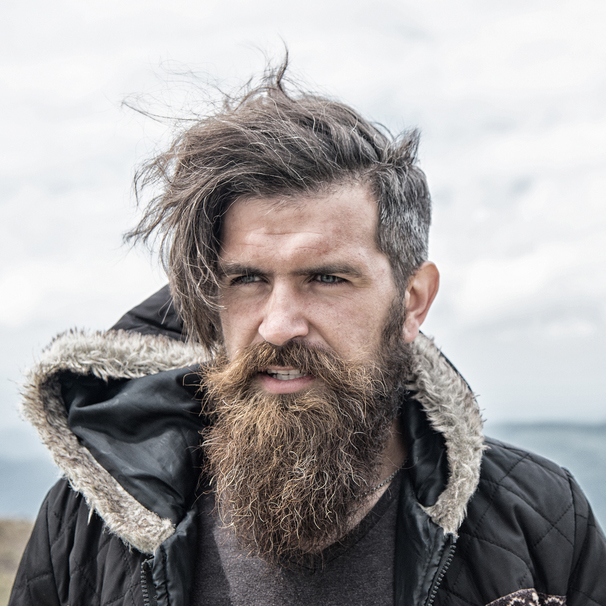
Ever wondered what city has the best art? If your heart beats for creativity, then travel and art can make an exhilarating fusion. This post aims to bring you to the world’s best cities that offer unique art encounters. Tired of the same old sights on your travels? Maybe you’ve hit up the most popular spots, but what about delving into locales that tickle your artistic fancy? I’m talking about places where art leaps off the canvas and streets become galleries. We’ll show you how to spot these cultural playgrounds where every corner promises a new visual feast for the soul. And because we’ve been there, done that—we’re your trustworthy companion to guide you to those inspiring artistic hubs that will transform your travels into a masterpiece of memories.
Feeling artistically unfulfilled?
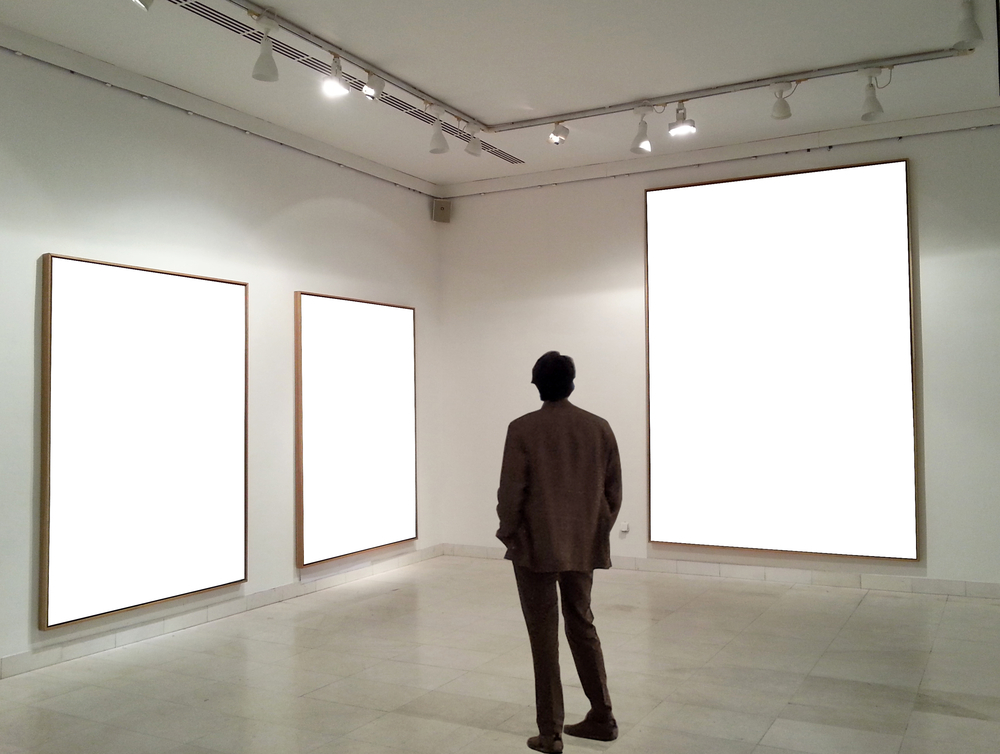
Tired of seeing the same old sights on your travels? Maybe you’ve visited the most popular destinations and landmarks, but have you ever embarked on a journey purely to soothe your artistic soul?
Here is your art-filled solution
We’ll show you how to blend your love of travel and art. Let’s prepare to take you on a tour of artistic cities, from world-renowned museums to immersive art festivals, where art is not just seen but is also an experience waiting to stimulate your senses and inspire your inner creator.
- Discover destinations that put art at the forefront, transforming the way you interact with travel.
- Learn how to find hidden gems, like intimate galleries and vibrant street art scenes, that offer a fresh perspective on culture and beauty.
Why you should trust this guide
Because we’re just as crazy about art and travel as you are! Our suggestions aren’t just pulled from a hat. They’re crafted from personal experiences, deep research, and conversations with fellow art enthusiasts who also love to travel. We understand the longing for a trip that goes beyond the ordinary, filling your travel sketchbook with moments that touch the essence of creativity. Whether it’s the stroke of a painter’s brush or the genius behind a public sculpture, we’ll lead you to find that spark.
Stimulating our minds through art while exploring the world has benefits backed by studies. For instance, a Psychology Today article discusses how engaging with art positively impacts mental health and cognitive function. So not only are you enriching your cultural palate, but you’re also doing wonders for your brain’s wellbeing.
By now, your curiosity might be peaking, and your wanderlust sparking — so what concrete encounters can ignite this artistic flame on your travels?
Stay tuned for the following section where we expose some of the world’s most amazing art destinations.
Amazing Art Destinations Around the World
Let’s be honest—some cities simply have a very special way of shouting out to the art lover in all of us. They’re the places where a stroll down any given street opens up worlds of visual and cultural splendor. And if you’re wondering, “Where next?”, well, I’m here to sketch out your personal art map—the very waypoints of an imagination-fueled journey.
Amsterdam, The Netherlands

In Amsterdam, art isn’t just found; it’s felt. This city is like a canvas showcasing the Golden Age’s rich essence while embracing contemporary boldness. Here’s an artsy sneak-peek:
- The Van Gogh Museum—home to the world’s largest collection of Vincent van Gogh’s works. Isn’t it time to see “The Starry Night” up close?
- Stedelijk Museum, where modern meets contemporary, challenging your perception at every angle.
- And, the legendary Rijksmuseum—a treasure trove of Dutch masterpieces.
And let’s not forget the streets adorned with graffiti art and installations that seem to sprout from the very soul of the city.
San Francisco, California

Moving on to the City by the Bay, San Francisco is where art disrupts the norm and speaks in volumes. It’s a metropolis of cultural rebirth:
- Behold the splendor of the SFMOMA, which houses over 33,000 modern and contemporary artworks that are simply otherworldly.
- For an al fresco art experience, Balmy Alley and Clarion Alley offer murals that narrate stories from the heart.
San Francisco’s art isn’t confined to gallery walls—it spills out, decorates the pavement, and interacts with daily life.
Venice, Italy

“Art washes away from the soul the dust of everyday life,” said Pablo Picasso, and nowhere does this feel more true than in Venice. Here, art is not just viewed; it’s experienced:
- Venice is the proud host of the Biennale, a celebration of contemporary art that transforms the cityscape every two years.
- Delight in the masterpieces housed in Gallerie dell’Accademia, a rendezvous with Venetian art history.
- And who could ignore the Peggy Guggenheim Collection, where modern art and tranquil gardens collide?
In Venice, every bridge crossed and ancient alley walked is an encounter with history and creative spirit.
Art beckons us to view the world through kaleidoscope lenses; it invites us into the minds of those who dare to dream in color. Have these destinations stirred the palette of your wanderlust? Are you feeling that magnetic pull to walk corridors echoing with brushstrokes and chisels? Then you might be pondering, “How do I immerse myself completely into the world of art tourism?” Keep reading, and I’ll unravel that very thread in the vibrant tapestry of art exploration.
Art Tourism Uncovered
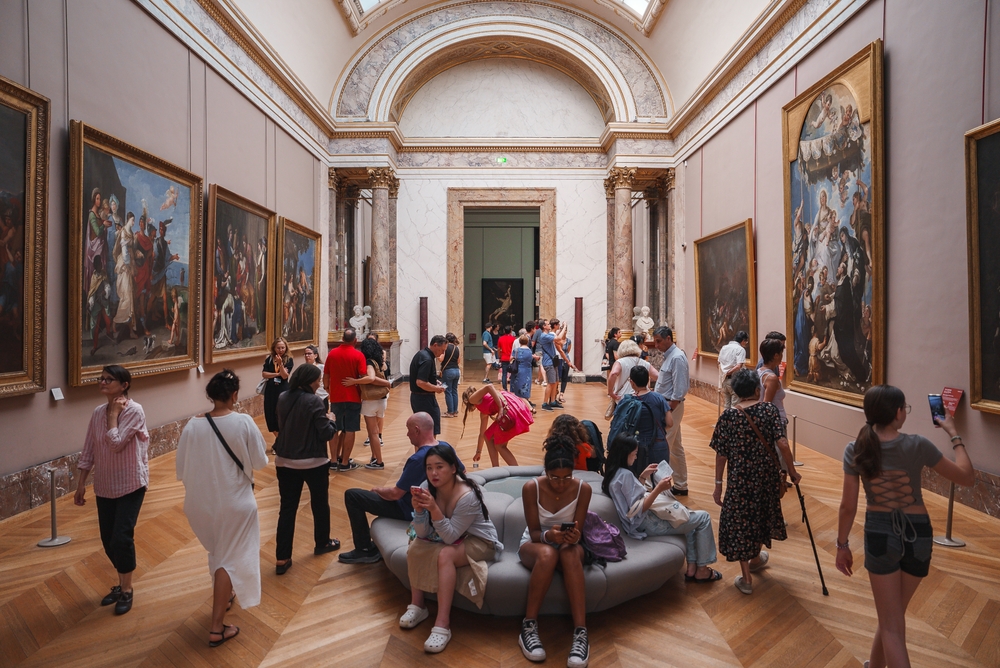
Ever found yourself wondering what the buzz around art tourism is all about? I’m here to shed light on this tantalizing trend that has art enthusiasts and travelers abuzz.
What Is Art Tourism?
Simply put, art tourism is the pursuit of travel experiences where the spotlight shines on art-related activities. Think of it as a pilgrimage for the soul, guided by the allure of creativity.
Examples of Art Tourism
- Art Festivals : These events can range from the avant-garde to traditional, offering a feast for the senses and a platform for new discoveries.
- Famous Museums : Stepping into institutions that guard humanity’s artistic heritage is like walking through a portal into history.
- Wine and Cuisine Events : Pairing the sensory pleasures of taste with visual wonders, such indulgences tell the local culture’s story through artistry on a plate.
- Concerts : Live music can paint an auditory masterpiece as profound and moving as any visual piece.
Getting the Most Out of Art Tourism
Here’s the secret sauce to ensuring your art tourism experiences are as enriching as they are memorable:
- Research the unique art offerings of each destination to tailor your trip to your tastes.
- Delve into local guides or social platforms for hidden gems that can offer a more authentic encounter.
- Participate in workshops or classes to take a piece of the artistic spirit back home with you.
“Art is not what you see, but what you make others see.” – Edgar Degas
This quote touches the essence of why we travel for art – to gain a new vision, to feel deeply, to unveil the unseen. It’s not just about witnessing art; it’s about letting art transform our perspective.
Imagine standing before a painting that captures an emotion you’ve never found the words to express, or feeling the pulse of a city’s creativity through its vibrant street art. These experiences stay with us, surfacing in our reflections and conversations long after the journey ends.
But let’s not stop here. With the stage set on what art tourism can offer, are you curious about where to find these soul-stirring experiences? What sanctuaries house the art that whispers to our deepest selves? Stay tuned as we unveil the abodes that breathe art into every space they occupy—where the very walls tell their stories.
Encountering Art Places
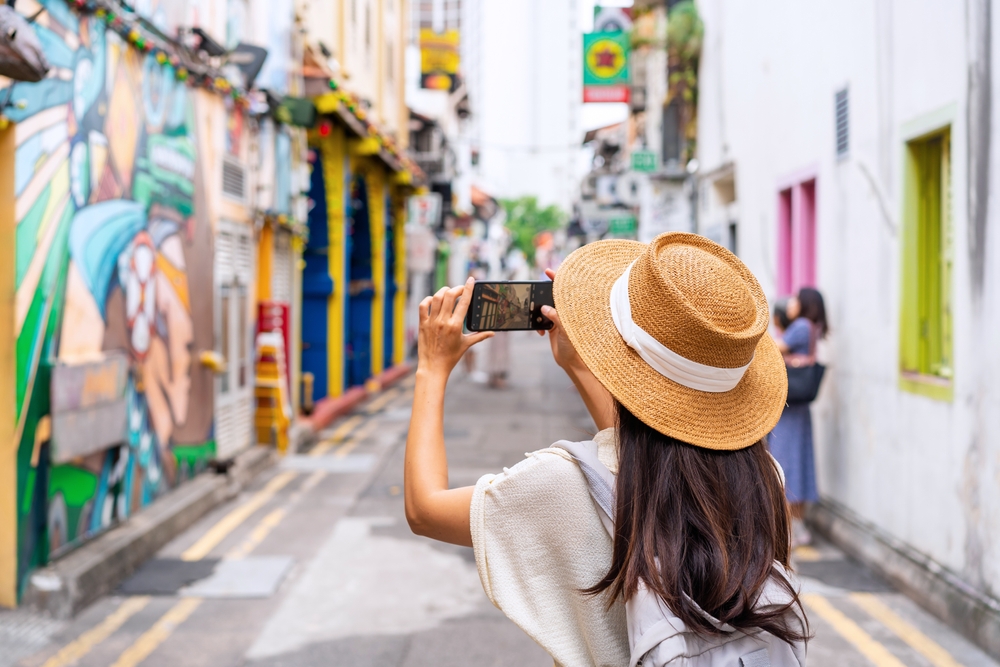
Imagine strolling through a city where every corner holds a secret dialogue between space and creativity. It’s not simply about finding places that exhibit art—it’s about discovering spaces that breathe life into art itself.
Museums and Art Galleries
Walking into a museum or gallery, you’re not just entering a building; you’re crossing the threshold into a world of artistic endeavors that span centuries and continents. Places like the Louvre in Paris or the MET in New York aren’t just popular tourist spots; they’re sanctuaries where the heartbeats of civilizations past pulsate through the brushstrokes on canvas.
- How about the Guggenheim, with its spiral layout that’s an artwork in itself?
- Or the Tate Modern in London, where modern art challenges your perceptions?
These monuments of human expression are more than structures; they are the architects of awe and understanding in our society.
It’s an urban canvas that’s ever-changing, reflective of the society’s pulse. The colorful murals of Berlin’s East Side Gallery, for example, tell stories of freedom and revolution. On the vibrant walls of Melbourne’s laneways, graffiti artists challenge norms and provoke thought. Where traditional art quenches our historical thirst, street art provides an unfiltered look at the present narrative of a city’s soul.
- Have you turned a street corner and stumbled onto a wall that became a window into someone’s imagination?
- Ever wondered what the stories behind the cryptic symbols and characters that adorn urban landscapes are?
Street art invites spontaneity and discovery, asking us to see the world through a prism of colors and shapes that dance on the asphalt stage.
Using Art Encounters for Personal Enrichment
As Picasso said, “Art washes away from the soul the dust of everyday life.” When art permeates through you, it ignites a creative spark; you begin to view the world through a different lens. Studies have shown that engaging with art enhances neural connections, boosting empathy, critical thinking, and emotional intelligence. It’s about the personal journey, the stirring of something innately human within us.
- Have you felt a surge of inspiration after a profound art engagement?
- Can a sculpture in a Parisian park unfold within you a newfound aesthetic appreciation?
It’s these encounters that can shape and refine our perspective, leading to an enriched life both personally and professionally.
And let’s not forget, there’s a sense of communal conversation that art invites. It may be a silent dialogue, but it’s one that connects us deeply with the artists and fellow observers—a shared experience that knows no bounds.
Now, if you’re eager to further unravel the fabric of art travel, stay tuned. The journey continues as we embark on a path laden with even more insight and inspiration. Are you curious about the voices and visionaries behind these art destinations?
Additional Resources

Have you ever felt the urge to immerse yourself even deeper into the beautifully eclectic world of art travel? Discovering new artistic destinations has never been easier, with a treasure trove of resources at your fingertips. For the passionate art traveler, I’ve curated a shortlist of thought-provoking and inspiring resources that will fuel your creative wanderlust.
Artsy’s List of Art Destinations
Curiosity about unseen art wonders around the globe is a common trait among art enthusiasts. Artsy.net does an impeccable job of feeding this curiosity with an editorial that takes you on a pictorial pilgrimage, showcasing 20 essential art destinations. These are places where art is not just shown; it is celebrated in grandiose expressions that feed the soul.
Lambus’s Inspiring Art Destinations
Are you in search of personal anecdotes and stories behind some of the world’s most inspiring art destinations? Lambus.com’s blog brings you an intimate look at locations that have captured the hearts of travel connoisseurs. Their narratives paint a vivid picture of the art and culture that breathe life into every corner of these destinations.
Journeys International
For the art traveler who looks beyond the canvas, Journeys International offers a unique opportunity. Here, art merges with the heart of travel experiences, guiding you to find your creative inspiration. It’s about creating art through the very act of traveling—every step is a stroke of the brush on your life’s canvas.
In essence, embarking on an artistic adventure is much more than witnessing art; it’s about integrating art into your journey and making it part of your story. The resources mentioned are gateways to expanding your artistic horizons.
But wait, there’s more to explore. From personal stories to expert insights, what could be the key takeaways to enhance your future art travels? Curious yet? Stay tuned, as the next part just might reveal that missing piece to complete your masterpiece of an art journey.
Wrap Up Your Artistic Journey

And there you have it—your map to exploring the grand tapestry of artistic cultures around the globe. You’re primed to step out the door, ticket in hand, ready to begin an odyssey through creative landscapes that promise to stir your soul and inspire your mind.
Begin Your Art Exploration
Now’s the time to embark on that eagerly anticipated art journey. Discover the textures of brushstrokes in a Parisian gallery, the vibrant murals adorning the alleyways of Bogotá, or perhaps the eclectic sculptures in Berlin’s public parks. With every step, you’re not just seeing art; you’re immersing yourself in the stories and spirits that birthed these wonders.
Share Your Experiences
But don’t let your adventures end with the trip. I want to hear about the galleries that enchanted you, the street art that took your breath away, and the local artists who opened your eyes to new horizons. Your stories form the mosaic of community knowledge, helping fellow travelers pinpoint their next artistic destination.
Conclusion: A Final Word for Art Travelers
Art is a journey, not just a destination. It’s an intimate dance with culture, history, and expression that transcends borders. By bringing back a piece of that journey, you become a curator of global narratives, a collector of visual anecdotes. So, keep your senses alert, be ready to capture those impromptu moments of artistry that speak the universal language of awe. Make your next escapade one where every moment is a brushstroke on your canvas of experiences. Because when you travel in pursuit of art, you’re not just a tourist; you’re a perpetual student of life’s boundless gallery.
Go ahead, set forth, and let every place you visit add a color to the palette of your life. Remember, the art of travel is but a canvas waiting for your story. Let’s paint it brilliant!
Cancel reply

- Work With Us
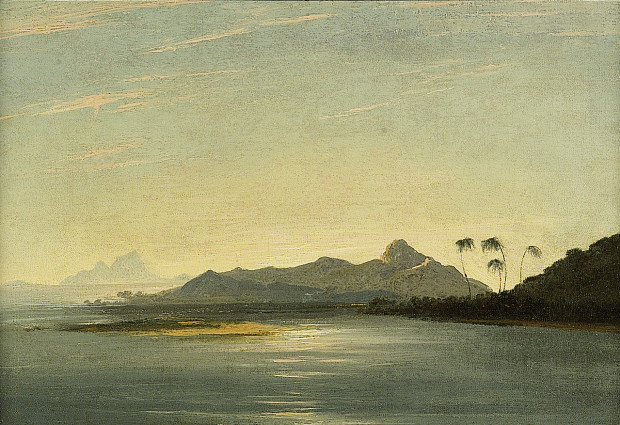
The Concept of Travel in Art Through the Ages
This post is part of the ArtSmart Roundtable , a group of travel and art bloggers bringing you themed posts every month. This month’s post theme is “concept”, so I’ve decided to tap into what Wanderarti does best – talk about travel in art. Scroll to the bottom to see more of this month’s awesome posts!
For as long as the timeline of art spans back there are paintings of places; depictions of destinations rendered carefully and thoughtfully by both famous artists and lesser-known explorers.
Landscape painting is perhaps the most prominent and most recognisable form of travel art.
Thick brushstrokes bring to life far-flung places; bold colours pinpoint fascinating scenes; realistic portraits showcase lesser-known destinations that would otherwise go undocumented.
Travel in Art in the 17th Century
Back in the 17th century, European landscape art was on the rise. It was a dominant genre during this time thanks to the unprecedented growth of global travel and tourism.
But there’s a conundrum here: it’s the chicken vs the egg debate when it comes to travel and art. Did the explorer set out to paint or did the artist set out to explore?
Through the 17th century and the following 200 years, travel was no longer a means from moving one group of people to another place (a form of travel that, for the most part, has been imbued into human life since the very beginning). It wasn’t just kings, queens, and traders who traversed landscapes far and wide.
Geographical exploration was on the rise, and colonial expansion was well and truly underway. This meant big things for the art world.
Without photographs or social media, explorers used the mediums of sketching and painting to document places. They combined skill and an expert eye for detail to produce scenes they had witnessed on their travels – to bring back and show family, friends, and those who were less able to travel.
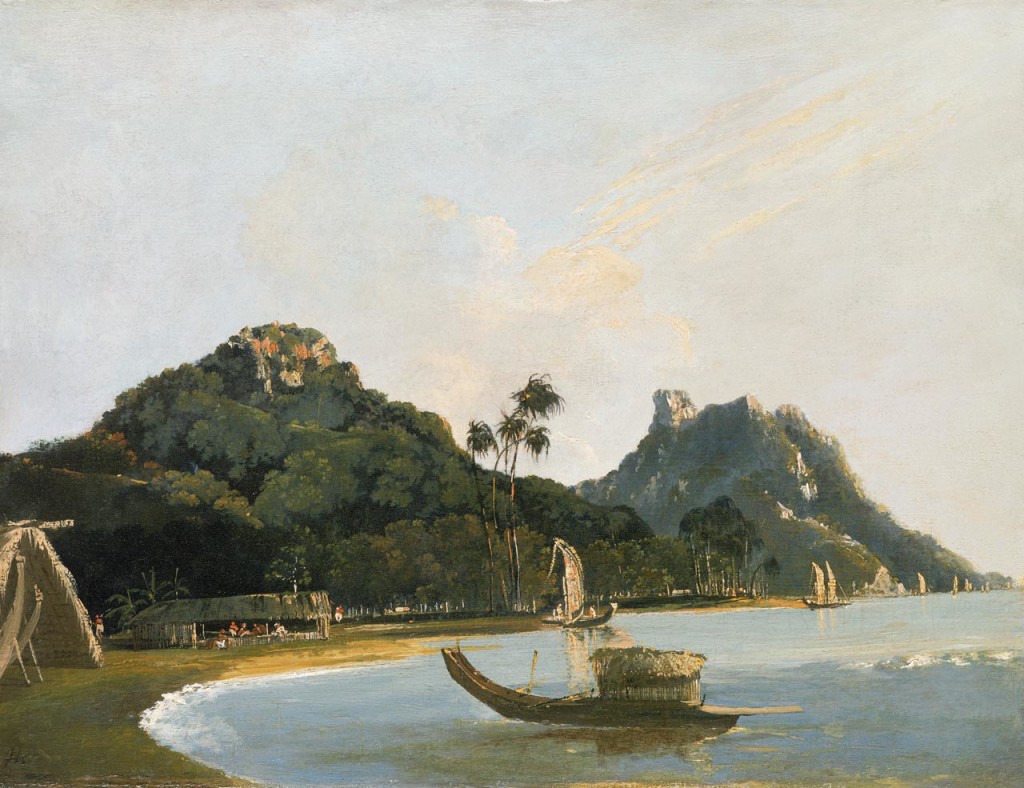
William Hodges via Wiki Commons
Trips during this time were lengthy and, usually, with purpose. It was impossible to pop to Cairo for a weekend, or explore the South American jungle in a couple of weeks.
Journeys lasted for months on end, with explorers turning to art to create stories about the places they visited – to immortalise languages, scenery, and customs that were otherwise unfamiliar to them.
But, despite efforts to portray countries, cities, and destinations in an objective light, this is art we’re talking about. Even in the most skilfully executed landscape piece, t here will always been a hint of political, social, and cultural significance depending on the person creating the painting.
Subjective observations creep into well-rendered pieces, offering viewers not just a glimpse into places from the past, but also an insight into the mind-set of explorers.
Even though just one explorer might have been producing the artwork, it was more of a collective experience. There was a vested interest in creating realistic depictions of other places because it hadn’t been done before.
Take the imagery created by 19th century explorers who ventured around the Pacific. Work produced by men aboard Captain James Cook’s ships in the 18th century immortalised places that had never been seen by the western world before. There was a vested interest from the west to learn more about these places – for trading and other political reasons.
Travel in Art in the Mid-19th Century
Jump forward to the mid-19th century. After teaching Queen Victoria how to wield a paintbrush, Edward Lear set out to explore distant lands, painting their oddities as he went.
Lear was different to the men who had been aboard Cook’s ship and those that came before him because he was, first and foremost, an artist. He wasn’t a trader, a soldier, or a voyager. His livelihood was made from painting.
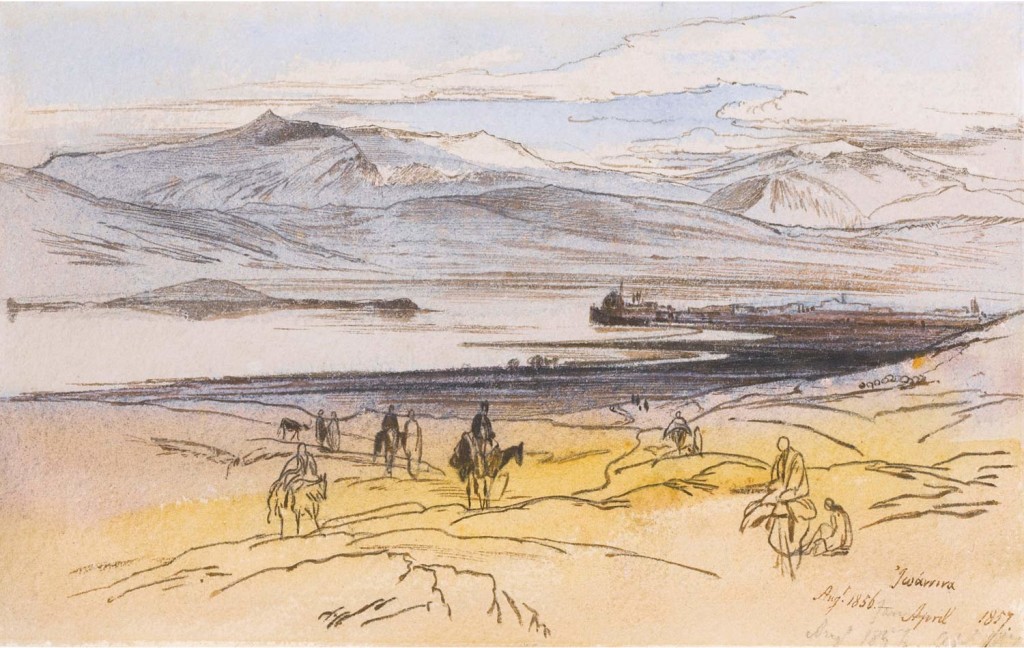
Greece by Edward Lear
At a time when barely anyone had the opportunity to travel (remember the long distances and difficulties in getting from one place to the next), Lear opened a gateway to the world for those less able than him.
From Italy, Albania, Greece, Egypt, and India, he immersed himself in the local culture and drew pictures that he felt reflected the place in its rawest form. There were seemingly no political backdrops to his work and underhand motivations. He simply wanted to bring the world to the world.
This was the start of something beautiful in the art world. Landscape paintings and depictions of “exotic” destinations were no longer driven by an ulterior motive. They were simply representations of the beautiful and the “other”.
Travel in Art in the 20th Century
Skip forward a century and this is even more evident to see. World-famous artists like Matisse, Derain and Picasso were creating piece after piece that showcased destinations around Europe.
These weren’t realistic renditions, though. In fact, they were a far cry from the beige swathes of sketches created by early voyagers and even Lear himself.
They were bold and bright, injected with a heavy dose of the artists’ recognisable style. Matisse’s paintings from Couillere were, at first glance, just splodges of paint in a wheel of surreal colours. Derain’s depictions of London were psychedelic, using the Pointillism technique to create abstract versions of scenes.
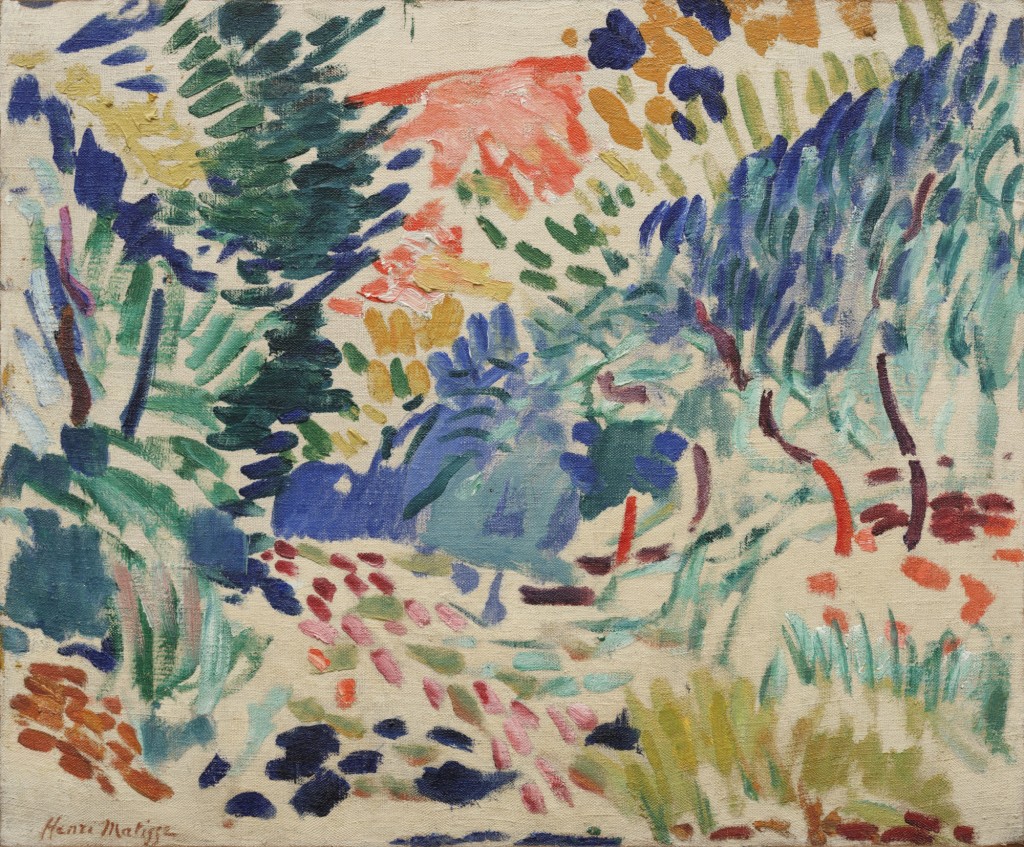
Gift and bequest of Louise Reinhardt Smith © 2015 Succession H. Matisse / Artists Rights Society (ARS), New York
At this point, art was no longer a vessel to share objective scenes and stories from around the world. It was a portal into the minds and souls of creative greats. There were already hundreds, if not thousands, of depictions of places around the world – what good would even more do?
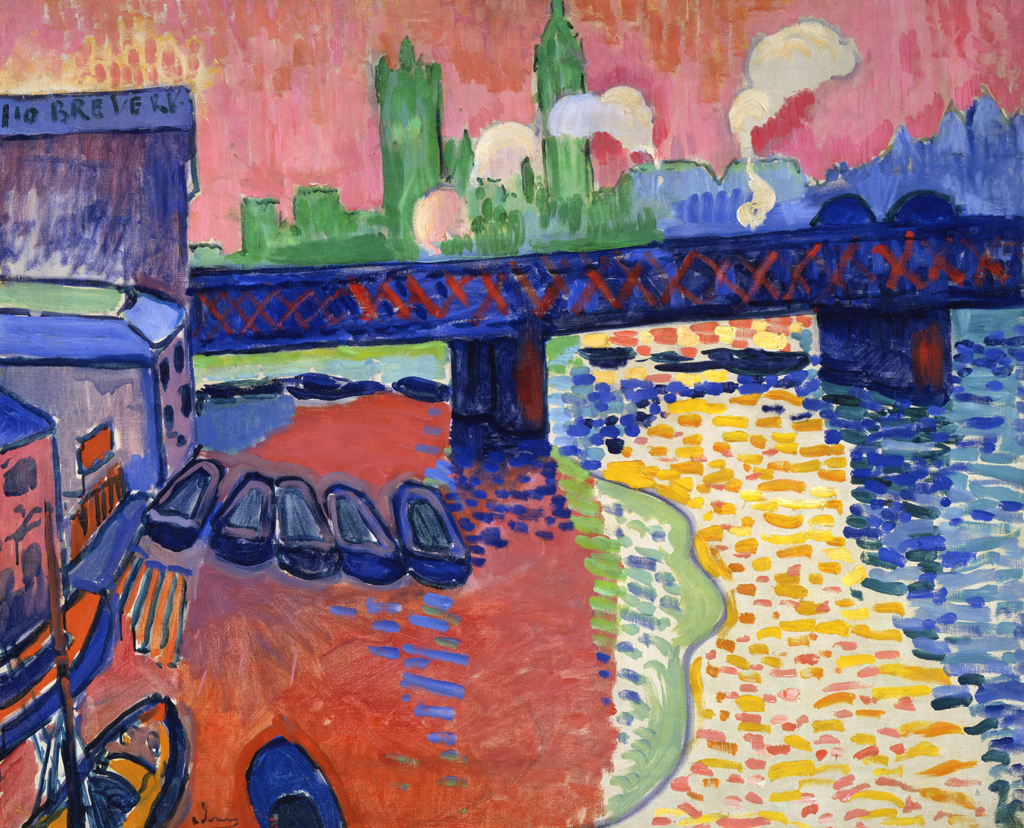
André Derain, 1906, Charing Cross Bridge, London , National Gallery of Art, Washington, D.C.
Instead, artists used the backdrop of places to express their feelings and thoughts about them. Matisse’s pieces from Couillere may not have shown visitors exactly what to expect in terms of scenery, but the brash use of colour and thick brush strokes might just give an insight into how he felt about the French town.
This notion of art being a personal endeavour rather than collective continues into the present day.
Sure, artistic versions of places hint at architectural styles, local life, and customs, but more than that they delve into personal journeys, highlighting individual thoughts and feelings rather than a collective vision of the world.
S ince documents began, art has served as an important inspiration for imagination. It’s served as a portal through which people can remember places, cultures, and journeys, as well as depict the motivations behind travel – from the Grand Tour, through the years of globalisation, right up until the present day.
Today travel art is so much more than simply a depiction of a place. They say a painting speaks a thousand words – especially in an age where photographs are a dime a dozen. They not only act as a portal through which we can see another view of a place, but they also act as a personal reminder that’s much more intimate than a photo could ever be.
More posts in this month’s ArtSmart Roundtable:
- Christina of Daydream Tourist – Changing Paintings After They Are “Finished”
- Alexandra of ArtTrav – Nurture and Hospitality at Santa Maria della Scala, Siena
- Murissa at the Wanderfull Traveler – Vancouver’s New Art Gallery
- Pal & Lydian at Art Weekenders – Earth Art – Creativity Out In Nature and Back Into Our Sight
- Jenna at This is My Happiness – Northern California’s Greatest Artist: Wayne Thiebaud


Lizzie Davey
Lizzie has a passion for visual vagabonding (a new term, maybe?), whereby she likes to document the beauty in the world via creative forms. She created Wanderarti as a space for this new term to flourish, providing somewhere for art and travel to collide. Apart from pretty things and exploring new places, Lizzie likes tea, takeaways, and cute animals.
You Might Also Like
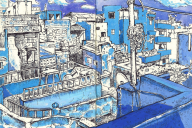
- Chronicling and Preserving Memories: Annelisa Leinbech Sketches the World
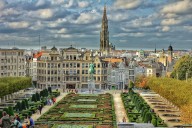
5 Ways to Explore the Art Scene in Brussels For Free
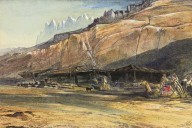
The History of Travel: Paintings of Landscapes Around the World by Edward Lear
Nice concept, Lizzie! It was Matisse indeed who jumped to my mind when I first saw the title, and nice to have a historic overview over how it evolved already before him.. It’s interesting to see that “travel art” hasn’t changed much for some 300 years, while photography of course totally changed the relationship between art and travel in the modern world.
Exactly! With the emergence of photography we no longer have to rely on the paintings of voyagers/travellers to know what places look like – which leaves lots of room for artists to get creative with their depictions of places!
I love early travel art. It seems like every exploration, trade, and military expedition always ventured from home with an artist along. I especially like seeing when Westerners had to document cultures and art so different from their own. For example, the Spanish explorers in Mexico were mostly able to draw Mayan characters, but you can still see their European approach to design in the pictures.
Yes, that’s one of the things I love about it – not only do you get a glimpse into “other” cultures, but you also get to see how they were viewed through Western eyes.
I like what you said about the 20th century artists. It certainly seems that from the late 19th century and after, travel became more important for some artists as they were inspired by color, light, landscape and even culture during their travels.
Exactly – documentation became less important whilst concept, ideas, and technique moved into the forefront.
[…] Lizzie – The Concept of Travel in Art Through the Ages […]
Follow along

Search the Site
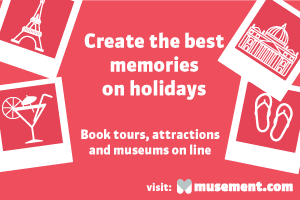
Recently on Wanderarti
- Moorish: Painting My Way From Marrakech to Lisbon
- Sirigu Paintings in Ghana Bring a Village Back to Life
- Playful Sketches of South America’s Wildlife, by Kia Hunt
- The Significance of Skulls in Art Around the World
Latest Guides

Unique Arty Things to do in Rome with Travelove

A Self-Guided Tour of the Street Art in Berlin
Find us on facebook.
- Explore by Place
© 2014 Wanderarti

Travel and Art
Explore transport and travel through the eyes of artists
Planes, trains and automobiles
Expeditions and maps, on your bike, take a walk, artists on holiday, explore more themes, fahrelnissa zeid: city by city.
Follow the international artist’s creative journey through each of the cities she spent time in
Patricia Belli – The Scar of the Skin
Join visual artist Patricia Belli and discover what her artwork means to her
Thao Nguyen Phan – 'My reflections on the history of Vietnam, the poetry of daily life'
Step inside the studio of artist Thao Nguyen Phan and discover her mesmerising, poetic work
Sol Calero Goes Travelling in Latin America
The artist explores themes of representation and identity through colourful, immersive installations
Concorde L449-15
Hommage à chrysler corp., tram on westminster bridge, concentric bearings b, king’s cross station, london, red arrow bus, french engine, locomotive wheel, united kingdom, escaped animals, water, selected, ithaca mirror trail, ithaca, new york, the north-west passage, a journey that wasn’t, the last voyage of henry hudson, a hundred mile walk.
Travel, in the younger sort, is a part of education; in the elder, a part of experience. Francis Bacon
Lubaina Himid CBE RA Between the Two my Heart is Balanced (1991) Tate
© Lubaina Himid, courtesy the artist and Hollybush Gardens, London
B.S.A. Tour of Britain Racer Enlarged to 135%
Joseph beuys, ‘is it about a bycicle’, cycle racing, five-man pedersen (prototype no.1), michael balling up old net, outside kampala, photograph of an unidentified boy playing with bicycle parts, colour photograph of the shadow of a bicycle on the pavement, a line made by walking, performance still, the commuters, laundromat-locomotion (walking in suit), walking dream with four foot clamp, the walking man diary, marching figures.
Julian Trevelyan Canal Holidays (1975) Tate
© The estate of Julian Trevelyan
It's very important for inspiration to go elsewhere: to move away from the city into pastoral settings, and to make space for meditation. Isaac Julien
Feet on Holiday I
The last resort 40, incidents 025, black mirror, st ives beach, from the pleasure principle, study for ‘the seaside’, rio de janeiro, brazil, 1967, couple eating fish and chips, whitley bay, tyneside, photograph of mollie gordon sunbathing by the pool in puerto de la cruz, tenerife.
My favorite thing is to go where I've never been. Diane Arbus
Tracey Emin Monument Valley (Grand Scale) (1995–7) Tate
© Tracey Emin
It sometimes takes a foreigner to come and see a place and paint it. I remember someone saying they had never really noticed the palm trees here until I painted them. David Hockney
Land art or earth art is art that is made directly in the landscape, sculpting the land itself into earthworks or making structures in the landscape using natural materials such as rocks or twigs
Psychogeography
Psychogeography describes the effect of a geographical location on the emotions and behaviour of individuals
Journeys Coursework Guide
From physical journeys and migration to journeys of self-discovery, get ideas and inspiration about journeys in art
Family and Art
Uncover how artists have responded to the idea of family through art
Queer Lives and Art
Discover LGBTQ artists and queer art
Migration and Art
Explore how artists reflect on moving to new places
Black Identities and Art
Discover Black art and artists in Tate's collection
Weather and Art
Explore how artists respond to the seasons and our changing environment

14 Top Attractions & Things to Do in Kiev, Ukraine
Written by Alison Abbott Dec 30, 2019
Kiev is having a moment. Regularly the subject of the nightly news, the city is just waiting to be discovered by tourists. You may know it as the capital of Ukraine and a manufacturing powerhouse, but what you may not know is that this lesser known European city also makes a dream destination for visitors.
Walk through the streets and visit the many small shops, restaurants, museums, and landmarks. The city has a population of three million, but in most neighborhoods, it retains its small-town vibe.
As the hub of science, industry, and culture in Ukraine, there isn't much you won't find in this undiscovered Eastern European gem. Whether you are looking for romance, history, or just a getaway to somewhere unique, Kiev offers a little something for everyone within the city limits.
Although there are many places to visit in the city, find the best spots for sightseeing with our list of the top attractions and things to do in Kiev.
1. St. Sophia's Cathedral
2. st. andrew's church, 3. national art museum of ukraine, 4. kiev pechersk lavra monastery, 5. mariyinsky palace, 6. independence square, 7. mezhyhirya: former presidential palace, 8. national opera and ballet of ukraine, 9. museum of the history of ukraine in the second world war, 10. st. volodymyr's cathedral, 11. the golden gates, 12. feofaniya park, 13. the motherland monument, 14. m.m. gryshko national botanical garden.
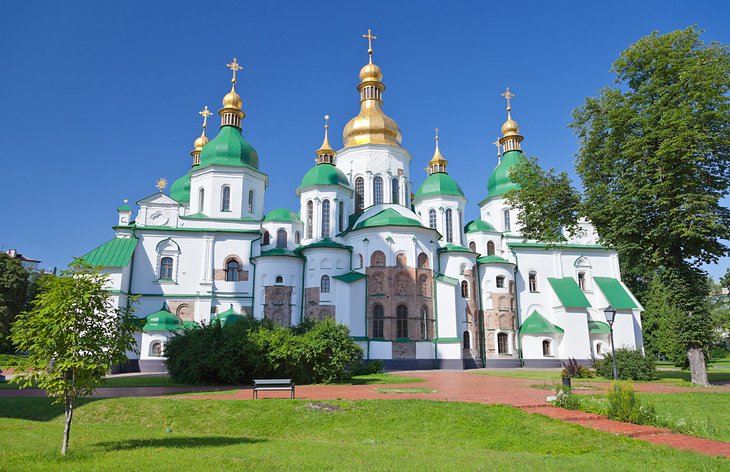
St. Sophia's Cathedral (also called Saint Sophia Cathedral) is one of seven UNESCO World Heritage Sites in Ukraine and was awarded the important status in the 1980s. It was constructed in 1037 and is named for Hagia Sophia. Since it's a favorite of tourists, visiting earlier in the day is recommended.
It's one of the oldest and most jaw-dropping of Kiev's impressive churches. Beautiful murals, ancient mosaics, and frescoes adorn the interior. Additional structures have been added over the years; one entrance fee is good for all.
Enjoy the views over the city form the bell tower. Tours are available.
Address: Volodymyrska St, 24, Kyiv
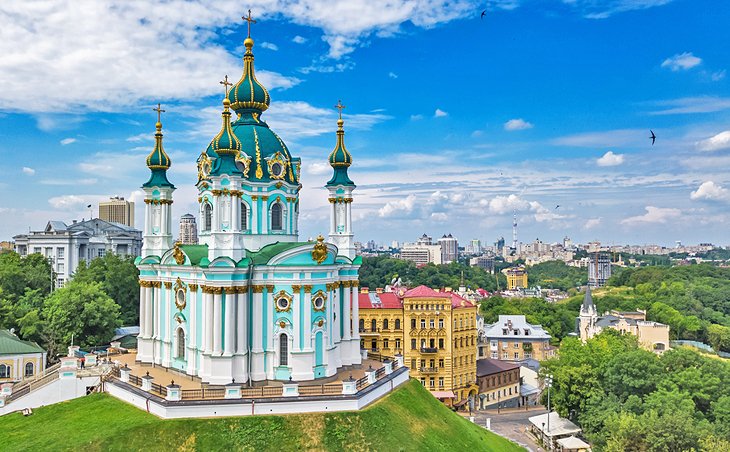
Another of Kiev's important landmarks is found in Podil, one of the oldest neighborhoods in the city. It was built by the Russian architect, Bartolomeo Rastrelli, during the time of Catherine the Great.
Churches were often built high on a hill for all to see, and St. Andrew's is a prime example. While the church is no longer religious in nature, it does house an important collection of paintings and sculptures . St. Andrew was a patron saint of Kiev, and the impressive Baroque architecture reflects his importance.
Address: Andriivs'kyi descent, 23, Kyiv
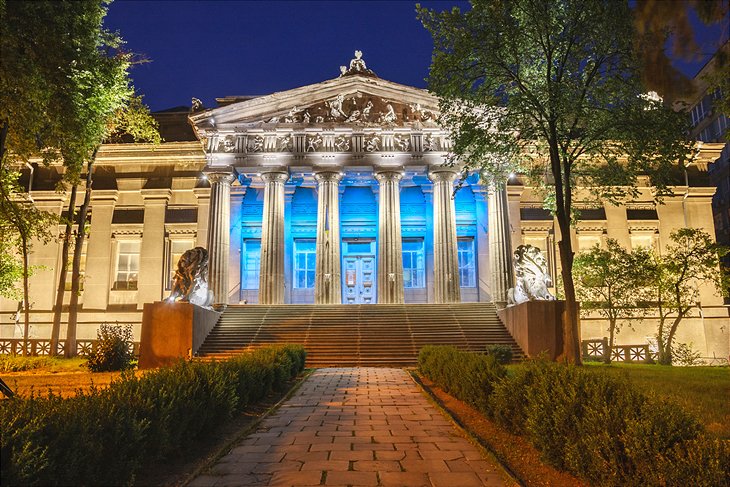
One of the most visited museums in Ukraine is the National Art Museum. It was established in 1897 by a successful patron of the arts, Bohdan Khanenko, who was determined to build the first museum in the country. Succeed he did—the historically important building contains a collection of important sculptures, artwork, and icons.
Represented are Ukrainian artists, both local and those who have moved to other countries and continued their career in the arts. The museum also shows the work of contemporary artists and is recognized around the world as an important representation of art from Eastern Europe.
Address: 6 Mykhaila Hrushevskoho Street, Kyiv
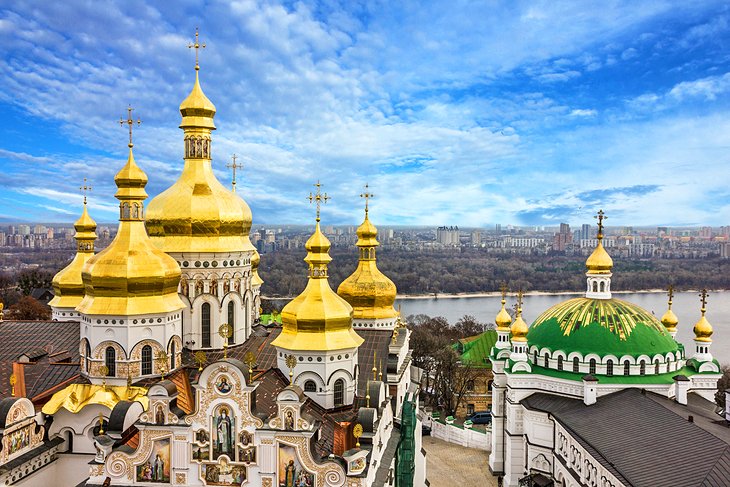
This monastery complex was founded by two monks of the caves: St. Anthony and St. Theodosius. Constructed over a series of caves excavated by the monks, it is remarkable to think they date to the 11 th century.
The Baroque style of Ukraine is again at work in the series of additional buildings in the complex. You might hear the attraction referred to as both the Near and Far Caves. Make sure to visit both areas, as you will find hundreds of artifacts.
Do not miss the underground crypts, where monks are buried under glass. Here, you'll find a fairly creepy and somewhat claustrophobic look into the past, and one of the most unique sights of the city.
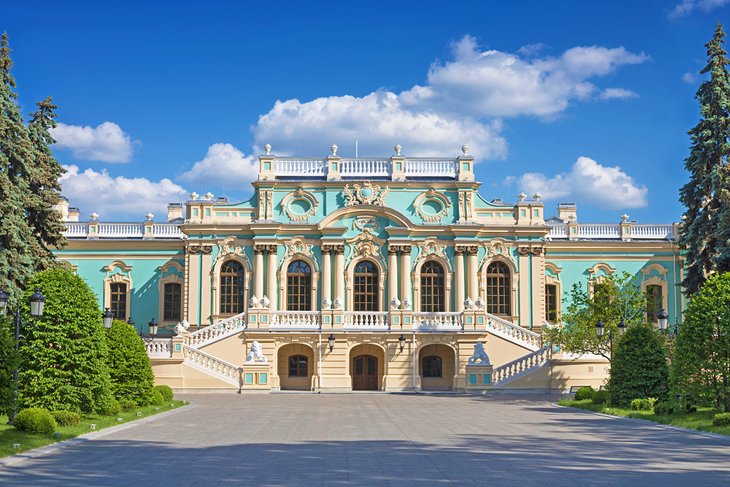
This Baroque palace is the official ceremonial home for the President of Ukraine. After a fire destroyed the first structure, Alexander II had the palace reconstructed in 1870, following the model of the old drawings. The pale blue exterior lends a dreamy quality to the magnificent architecture.
Inside, visitors will find a collection of artwork by Ukrainian masters, as well as cultural and historic treasures. The surrounding landscaped gardens are a nice place for contemplation.
Address: 5A, Mykhaila Hrushevskoho St, Kyiv
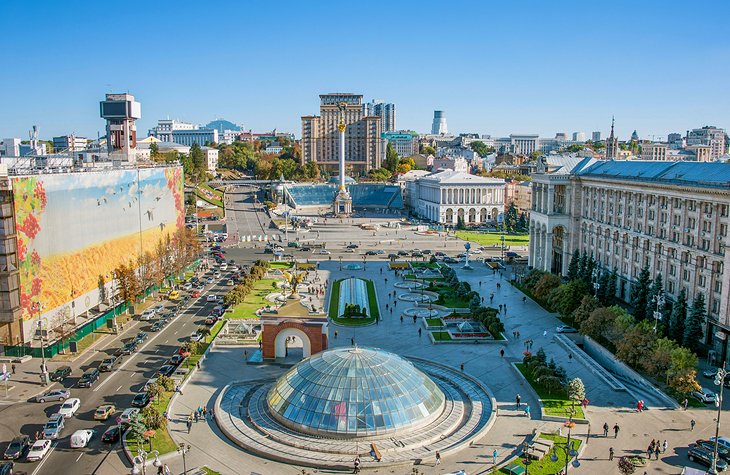
Independence Square had its international debut in 2004 as the scene of the Orange Revolution, when the power of the people changed Ukrainian history and the future of the country.
As the central square in the city, many festivals, concerts, and parades take place in the area. The attraction contains six fountains, a waterfall, and a large column representing Ukrainian independence. In the evening, it makes for a great people-watching spot, and there is often a light show and music with the fountains on colorful display.
Visitors will find this area a convenient location for their stay in the city as it is close to many shops, restaurants, and popular areas.
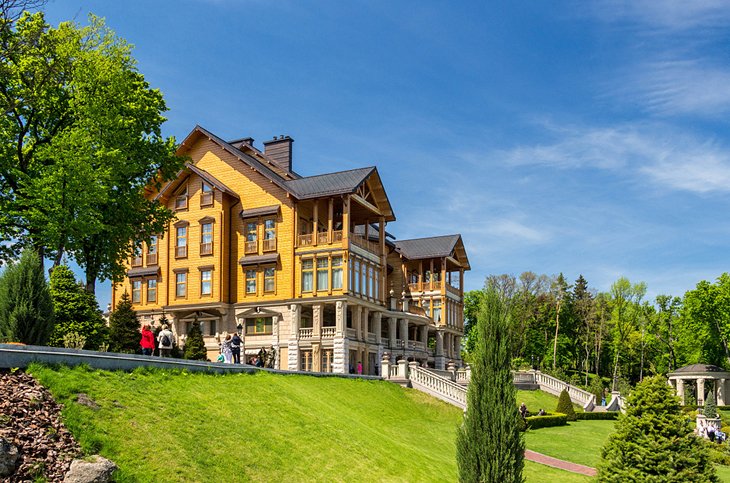
Mezhyhirya is situated in a lovely location on the banks of the scenic Dnieper River. The comples is the former residence of ex-president of Ukraine, Viktor Yonukovych. If you are lucky, your tour guide might be a caped member of the former resistance. Charged with protecting this example of political greed and corruption, he makes for quite an interesting hour of commentary.
Visitors will be overwhelmed by the extravagance on display. Today, in all its glory, the building is a symbol and reminder of overindulgence and institutional greed and corruption. Within its gated walls, there are tennis courts, a shooting range, an equestrian club, helicopter pad, ostrich farm, dog kennel, golf course, and hunting grounds—all built while the population of the country struggled to feed itself.
The surrounding gardens are beautifully maintained and a nice place to have a picnic while trying to process all that you have just taken in on the tour.
Address: Novi Petrivtsi, Kyiv Oblast
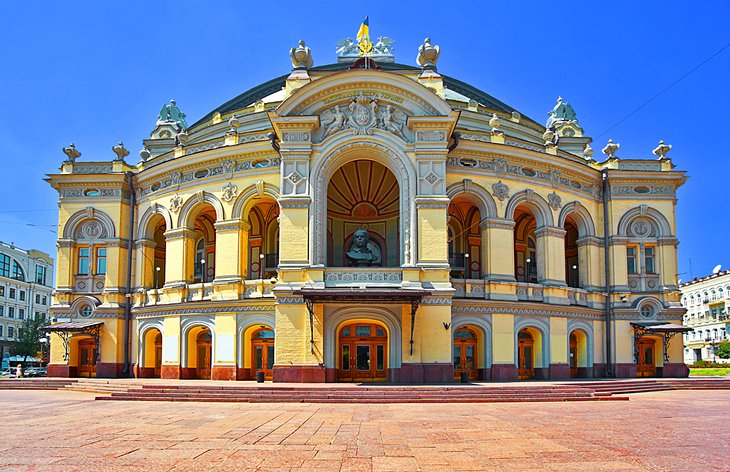
From its humble beginnings in 1867, the National Opera of Ukraine has been a cultural mainstay in Kiev. The impressive structure that houses the cultural institution is filled with unique architecture and has modern amenities after it was rebuilt following a devastating fire in the 1980s.
It's one of the most popular cultural attractions in the city—millions of people over the last century have graced its halls and viewed classics like Swan Lake or the Nutcracker .
The National Opera isn't just a great place to view a performance. Outside is the perfect spot to people watch or grab a bite to eat. There is a waterfall sculpture outside, and across the street are a few excellent restaurants from which to choose.
Address: Chaikovs'koho Ln, 1, Odesa, Odes'ka oblast
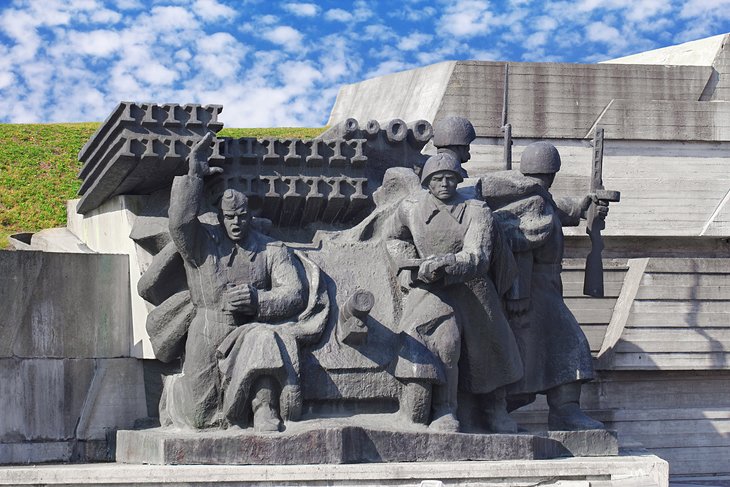
Opened in 1981, the Museum of the History of Ukraine in the Second World War is located on the banks of the Dnieper River. Within the complex, you will find everything related to the role that Ukraine played in the Second World War commemorated in statues and relics, like uniforms, letters, and larger pieces of history like airplanes and artillery.
Although most of the exhibits aren't in English, you will still get a sense of what it was like to be a soldier during that time, and walking around outside, you can see some impressive views of the city below.
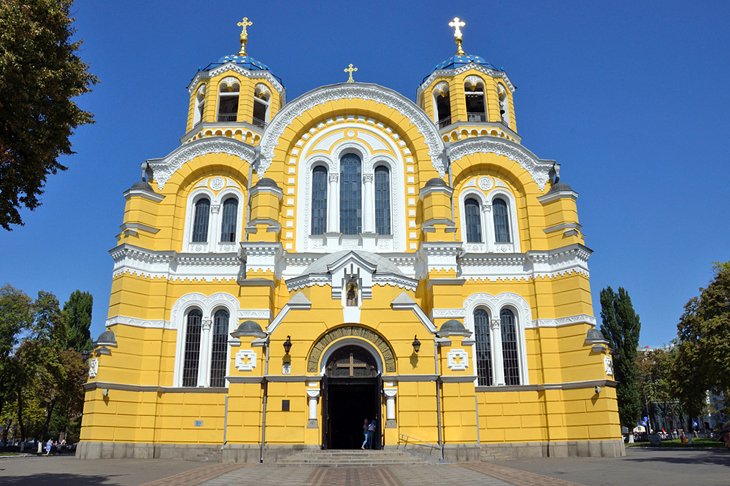
As one of Kiev's key landmarks, St. Volodymyr's Cathedral is probably one of the city's most significant churches. Surely it is one of the most impressive. Many would consider it a key component of the Ukrainian Orthodox structure.
From the moment you walk in the door, you are greeted by the amazing Byzantine-style architecture and art that most visitors find breathtaking. The craftsmanship is exquisite and one-of-a-kind, complete with gilded murals , paintings , and hand-carved accents all nested into this holy space. The grounds are equally beautiful, on a tree-lined street near Shevchenko University.
When you visit, take note that both men and women will need to be appropriately dressed, and women will need a headscarf. Be mindful of the time as well. Regular services are hosted daily.
Address: Tarasa Shevchenko Blvd, 20, Kyiv
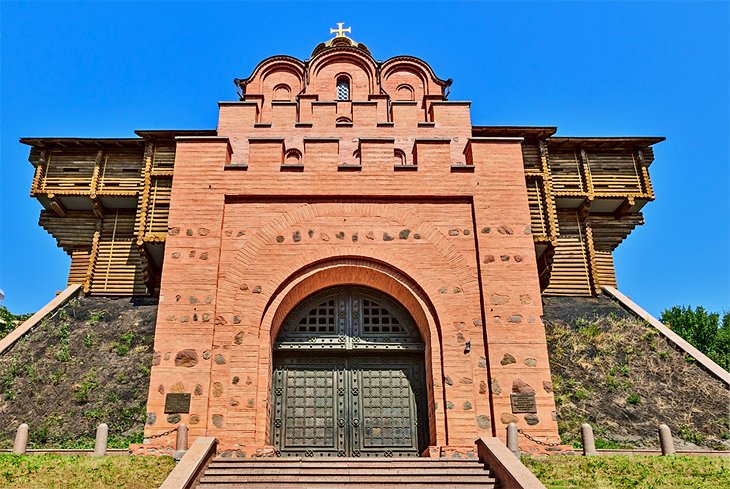
Although the original "golden gate" was dismantled in the Middle Ages, the gates that are here today pay honor to the main gate in the 11th century that helped fortify Kiev.
Modeled after the Golden Gate of Constantinople, the structure that stands today was built in 1982 amid controversy. There were no photos to compare it to, just oral tradition as to what the gates would have looked like, so there are many who feel as if this isn't an accurate representation.
At the gates, you will also find a branch of the Sophia of Kiev museum , and several vendors in traditional dress sell local wildflowers around the monument.
Getting here is easy—there is a station of the Metro with easy access.
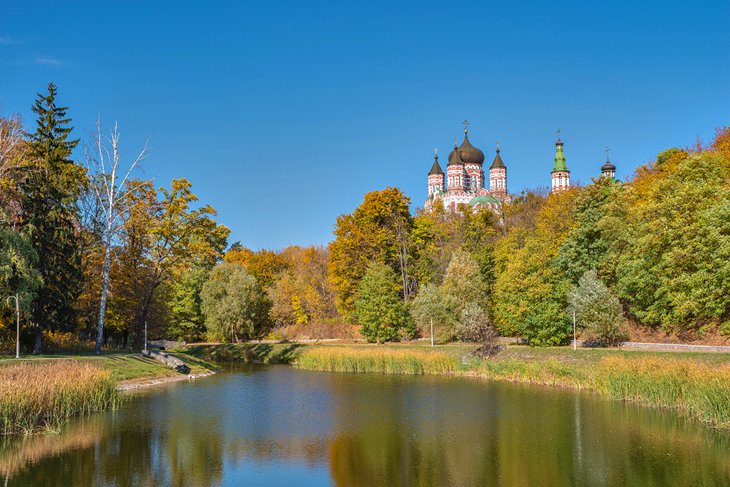
Feofaniya Park is a beautiful respite in the bustling city of Kiev. Located near the southern outskirts, this park became part of the Soviet state farm system and home to the main observatory for the Institute of Botany of the Ukrainian Academy of Science . This school is well known in Ukraine and Europe in its studies of biodiversity.
Take a stroll in the park and explore the lush greenery and unique plants that call this park home. It's a great way to spend a lunch break or just get away from the city to recharge in a welcome sea of green.
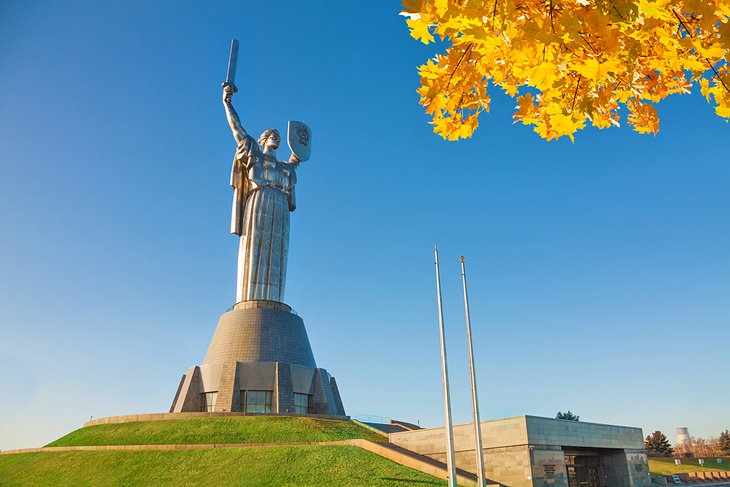
This statue, located in Victory Park , commemorates the Soviet victory over Nazi Germany and is a focal point in Kiev. Take a walk around the grounds and admire the views overlooking the Dnieper river.
Inside, visitors will find the Museum of the Great Patriotic War , opened in 1995 at the base of the statue. Thousands of visitors have flocked here to observe and view World War II memorabilia, from weapons to battle dioramas.
This giant titanium statue is taller than the Statue of Liberty. There is a viewing platform that can be reached by elevator, but only with a guide. When you are here, be sure to check out the Hall of Glory and the Hall of Remembrance and Sorrow , a sober reminder of those who lost their lives.
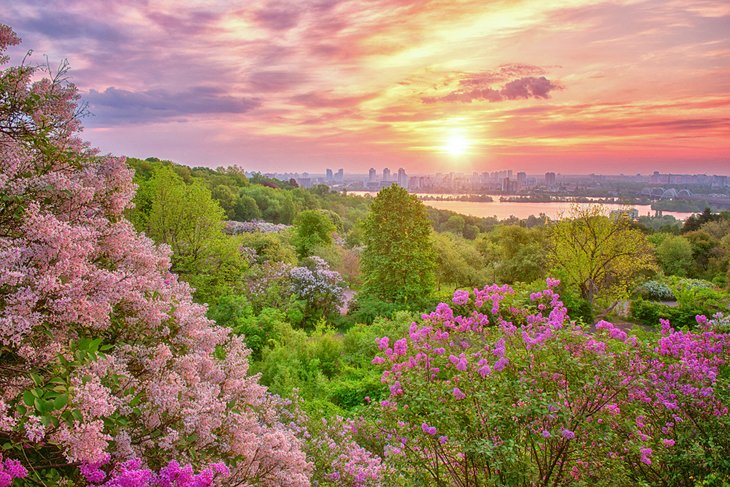
Named after the famed botanist Mykola Gryshko, this beautiful nature preserve is filled with local flora and fauna, as well as plants from all over the world.
Take a walk through the hothouses, greenhouses, or conservatories, where you can check out the exotic plants, as well as a plethora of flowers, from peonies to magnolias. If you are lucky enough to visit here during the spring, you can revel in the gorgeous lilacs in the central gardens, which are a favorite of visitors.
There is a small entry fee charged, but visitors could easily spend several hours here if they are looking for a green space to walk and enjoy the outdoors.
Address: 1 Timiryazevskaya Street, Kiev
Official site: http://www.nbg.kiev.ua/en/

Welcome to The Met
Now on view.
The Harlem Renaissance and Transatlantic Modernism
Hidden Faces: Covered Portraits of the Renaissance
Indian Skies: The Howard Hodgkin Collection of Indian Court Painting
Weaving Abstraction in Ancient and Modern Art
Lineages: Korean Art at The Met
The Facade Commission: Nairy Baghramian, Scratching the Back
Before Yesterday We Could Fly: An Afrofuturist Period Room
Grounded in Clay: The Spirit of Pueblo Pottery
The African Origin of Civilization
Cycladic Art
Look Again: European Paintings 1300–1800
The Art of the Literary Poster: Works from the Leonard A. Lauder Collection
Vision and Verse: The Poetry of Chinese Painting
Anxiety and Hope in Japanese Art
The Real Thing: Unpackaging Product Photography
Don't Forget to Call Your Mother
Art of Native America: The Charles and Valerie Diker Collection
Bélizaire and the Frey Children
The Calculated Curve: Eighteenth-Century American Furniture
Samurai Splendor: Sword Fittings from Edo Japan
Emulating Books: Book Objects from the Lynn and Bruce Heckman Gift
New York Art Worlds, 1870–1890
Ganesha: Lord of New Beginnings
A Passion for Jade: The Bishop Collection
Embracing Color: Enamel in Chinese Decorative Arts, 1300–1900
Afterlives: Contemporary Art in the Byzantine Crypt
The Jousting Armor of Philip I of Castile
Layered Narratives: The Northern Renaissance Gallery
Renaissance Masterpieces of Judaica: The Mishneh Torah and The Rothschild Mahzor
Celebrating the Year of the Dragon
Locations and hours.
The Met Fifth Avenue
The Met Cloisters
Updates on The Met Collection and Cultural Property
Met director Max Hollein provides an update on The Met’s work on cultural heritage and, more broadly, The Met’s engagements across the globe.
The Harlem Renaissance and Transatlantic Modernism : A Creative Convening
On Saturday, April 27, join us for a day of dynamic conversations with leading scholars and artists, performances, and more.
Date Night at The Met
Every Friday and Saturday night, enjoy an evening of live music, drink specials, and more.
Membership at The Met
Met Members enjoy a rich variety of specialized benefits—from free guest passes to Member Preview Days for new exhibitions—all while supporting our mission.
Timeless Jewelry
Discover new and best-selling designs inspired by 5,000 years of art.
More to Explore
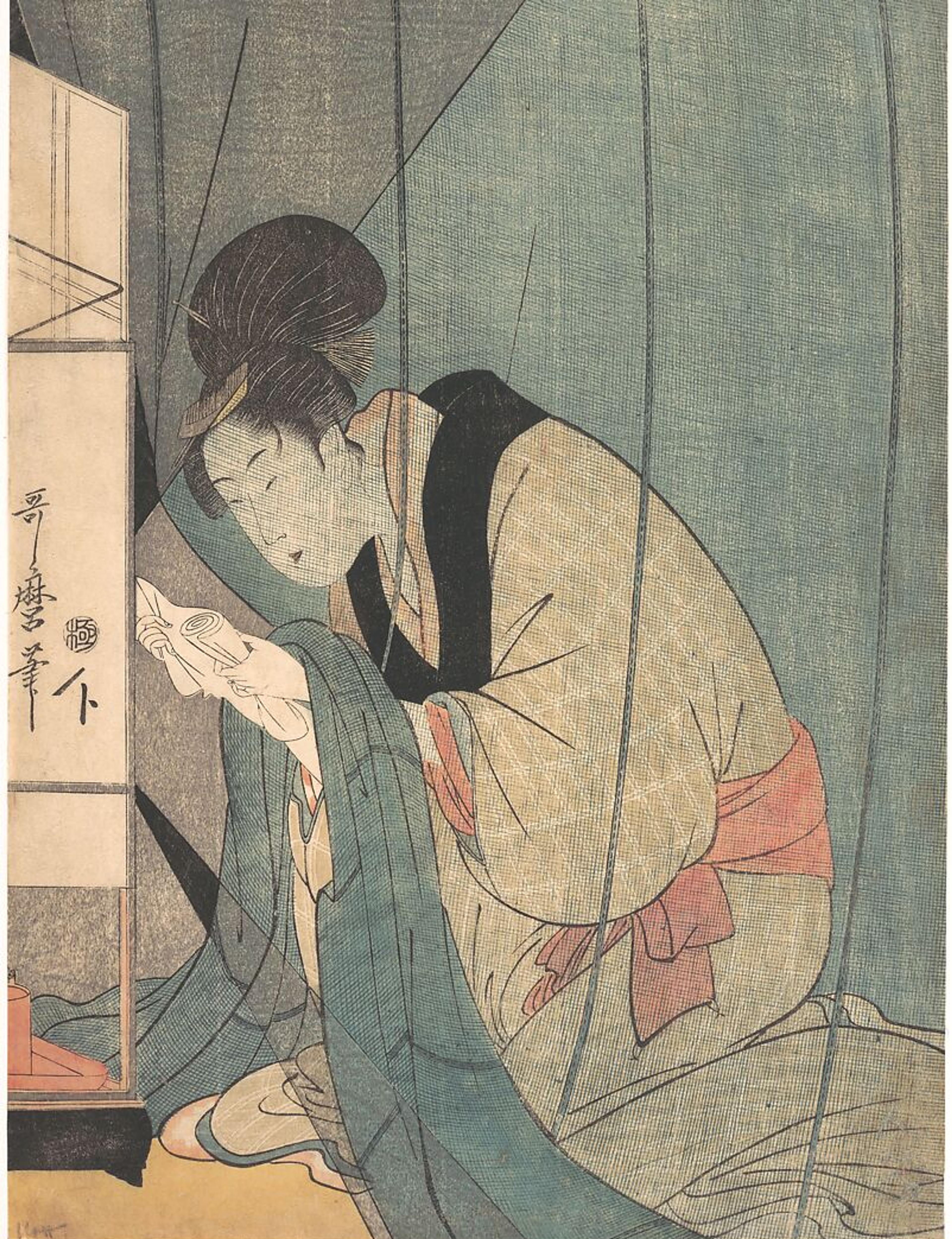
Perspectives
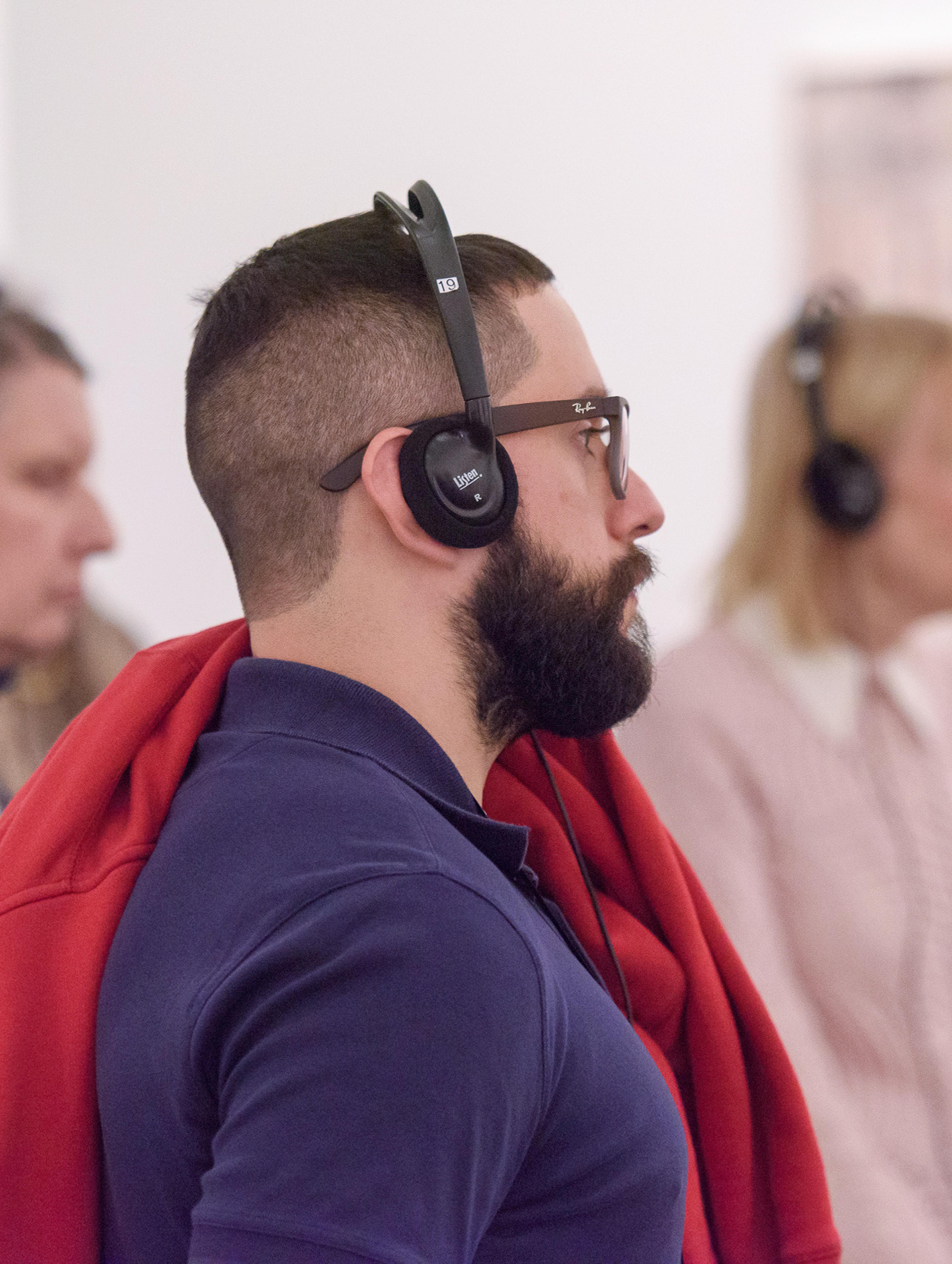
Audio Guides
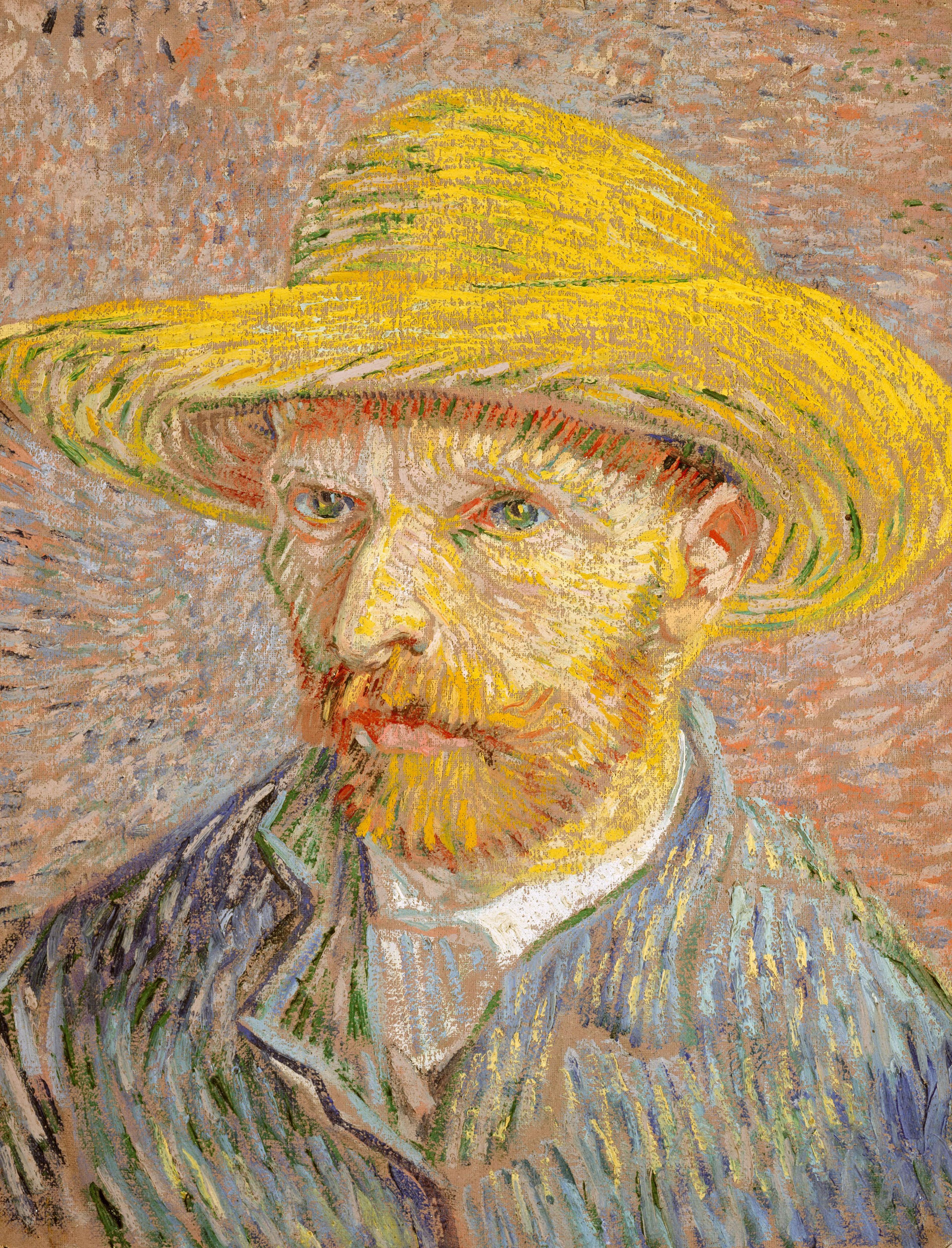
Collection Areas
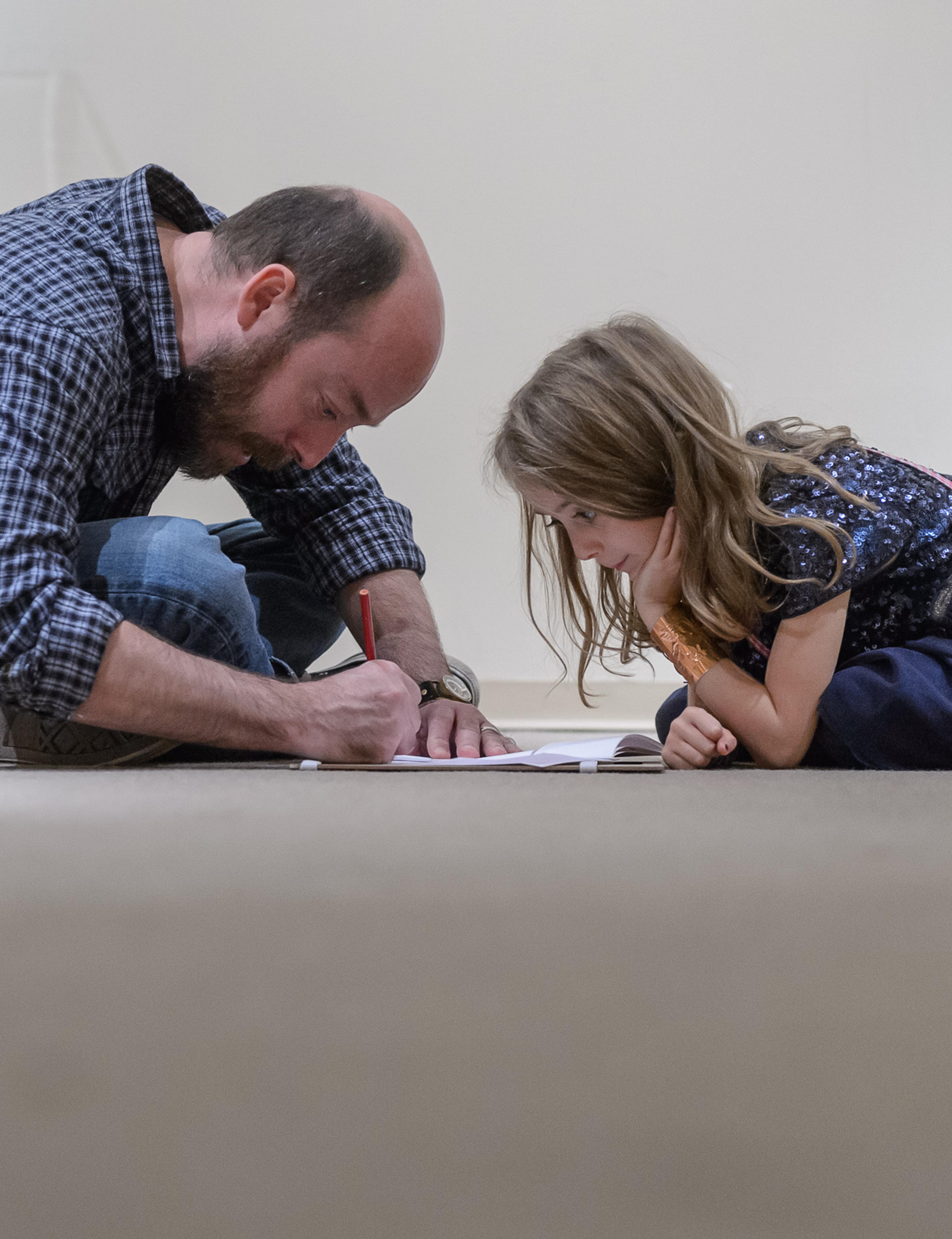
Learning Resources

Group Tours
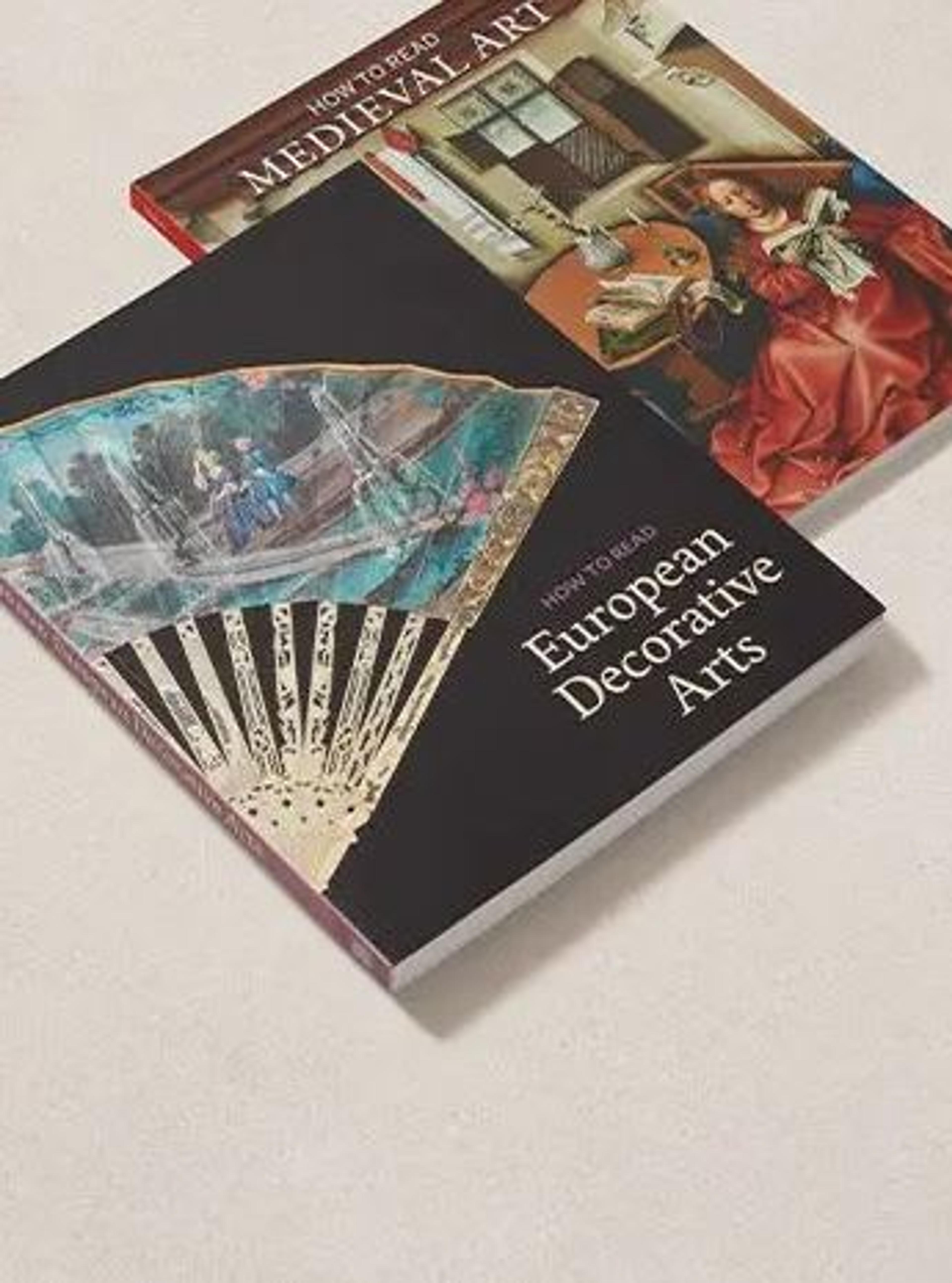
Met Publications
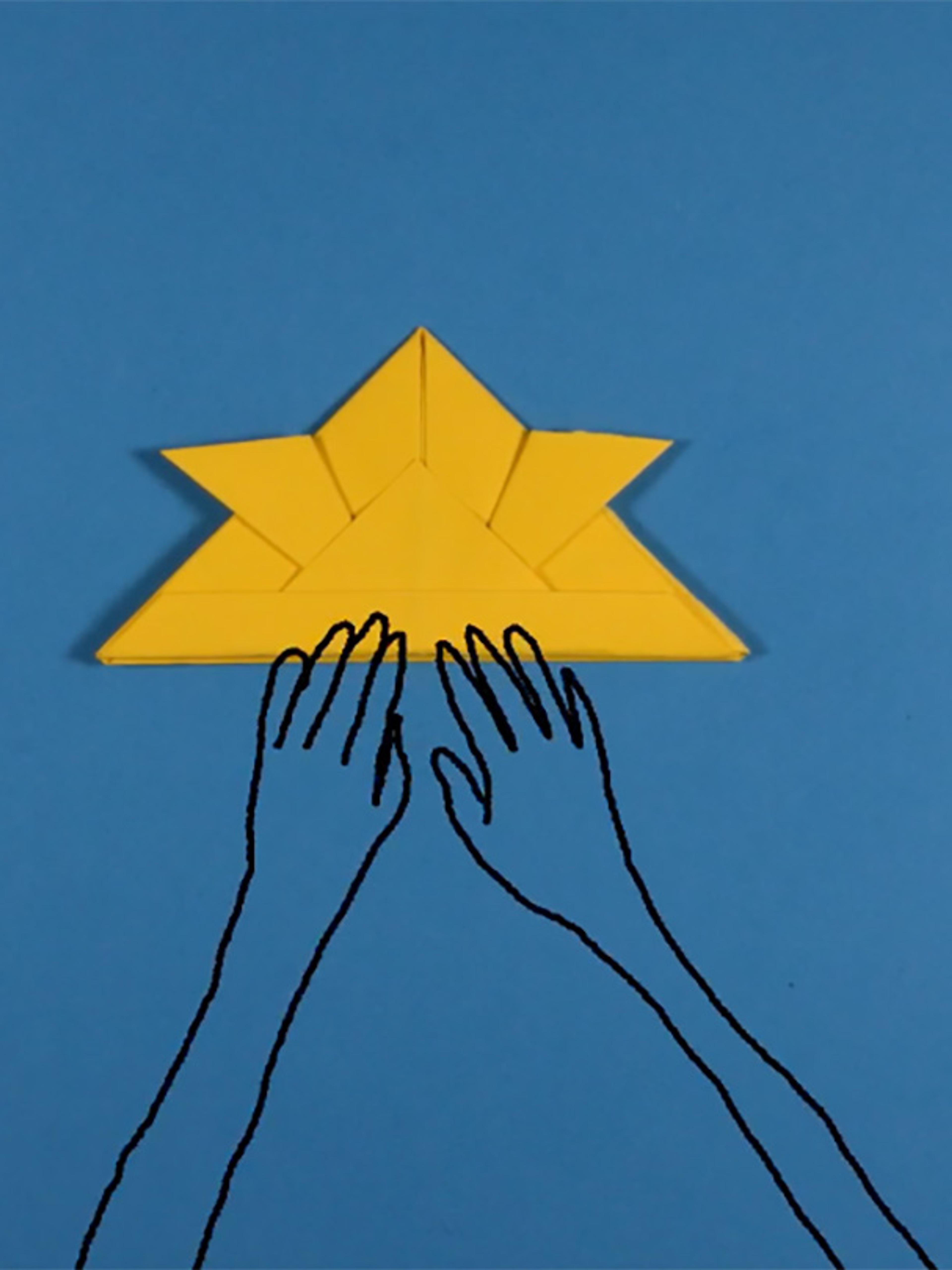
Virtual Events
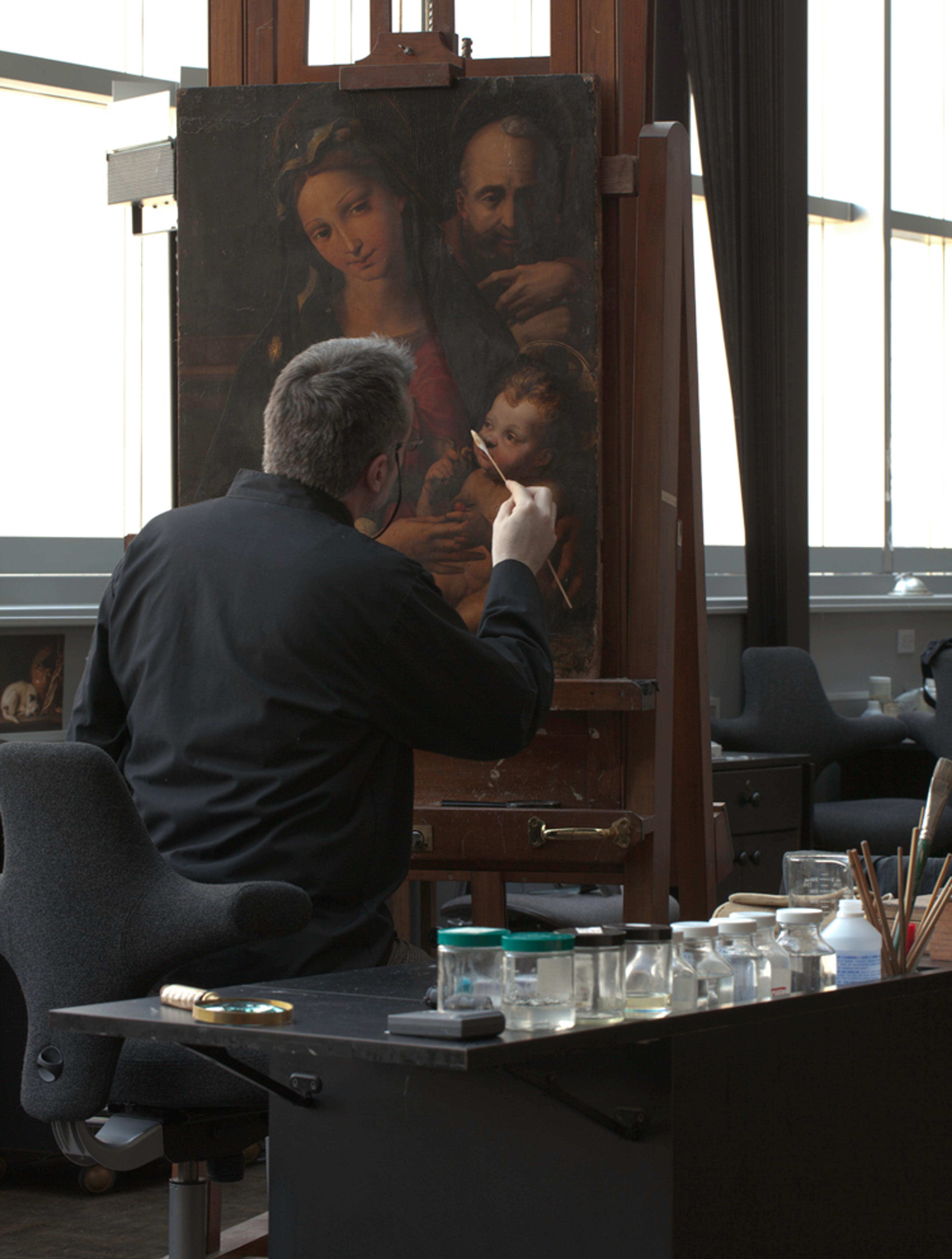
Conservation and Scientific Research

Bring some culture to your inbox

- Join for Free

10 Artists to Inspire Your Travel Illustration Journal
- by @amy.mcgregor
Find out how to bring a destination to life through travel illustration and the top artists to inspire your work
Travel. There’s nothing quite like it. The chance to experience new sights, sounds, and smells, to wander off the beaten track and make new discoveries, or simply kick back and relax for a week on a sun-drenched beach.
When we imagine the far-flung places we’d like to visit, reminisce about past adventures, or indeed, advertise a location to others, we turn to photos as the most powerful medium to capture the essence of a place.
But there is another, equally effective and arguably more creative way to bring a destination to life: travel illustration.
Alex Green ( @algreen_1 ) has been an illustrator for over 25 years and specializes in the art of travel illustration . He has worked in many areas including design, fashion, editorial, murals, websites, and live events, with a varied and enviable list of clients including Airbnb, the BBC, Emirates Airlines, Pfizer, The Guardian , The Financial Times , and Oxfam.
In his Domestika course, he demonstrates how to create travel illustrations that have a sense of place and atmosphere from photographic references of a location, and explains how to apply personal experiences to your illustrations to create pieces with your own vision and interpretation.

What is travel illustration?
Travel illustration is simply the art of drawing a place instead of photographing it. You can use a photo as a reference point, draw inspirational settings in real time as you travel, or recall them from memory.
The aim is not necessarily to copy the location exactly as you see it, but to give it your own interpretation and tell a story by focusing on conveying a particular emotion, theme, or atmosphere.
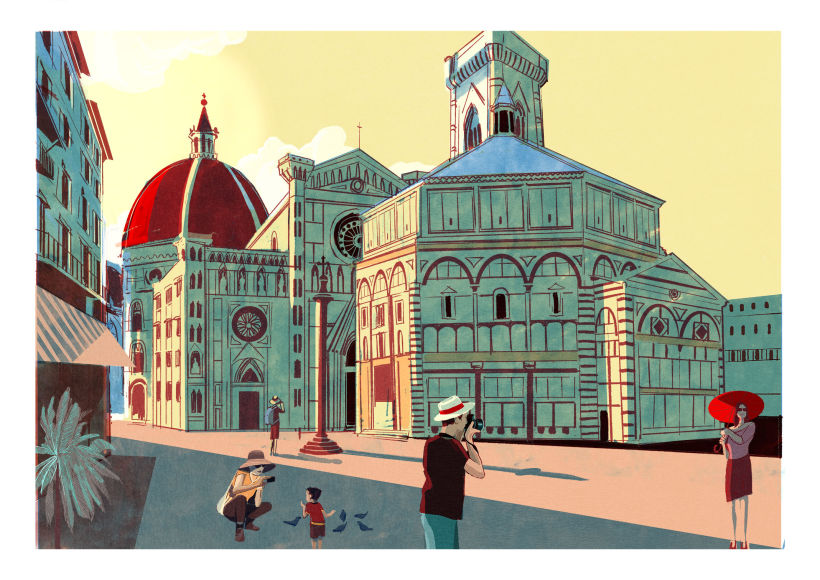
What are the benefits of travel illustration?
Aside from being a great way to practice your creative skills, illustrating a place allows for more freedom of expression and interpretation, giving you the opportunity to explore the limits of your imagination for a truly unique and personalized result.
It may require more time and patience to complete, but illustration also allows you to really connect with a place, bringing it to life through your drawings and recapturing those precious moments you spent there.
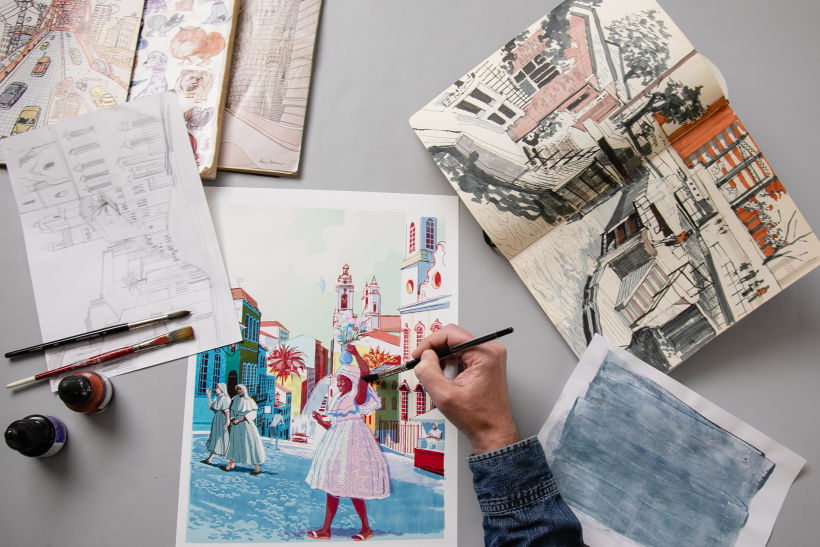
10 Artists to Inspire Your Travel Illustration Pieces
Although using your own photos as a point of departure usually means you have a greater connection with your reference, there is no reason why you can’t choose other images of locations you would like to visit. They could be photographs taken by someone else, or something you have found on the internet, as long as they spark your imagination.
Of course, all artists look to other artists for inspiration and Alex is no different. In this Domestika blog, he shares with us the top 10 artists who inspire his work, providing an invaluable tool that can help you begin thinking about how to develop your style, techniques, and give you ideas for your illustrations.
Miroslav Sasek
@miroslavsasek
The Czech artist is both illustrator and author of the This is series of children’s travel books, which bring to life key destinations around the world including New York, Rome, London, and Paris.
Abstract and representational elements contrast in his illustrations, making for a beautifully original take on seemingly-familiar places.
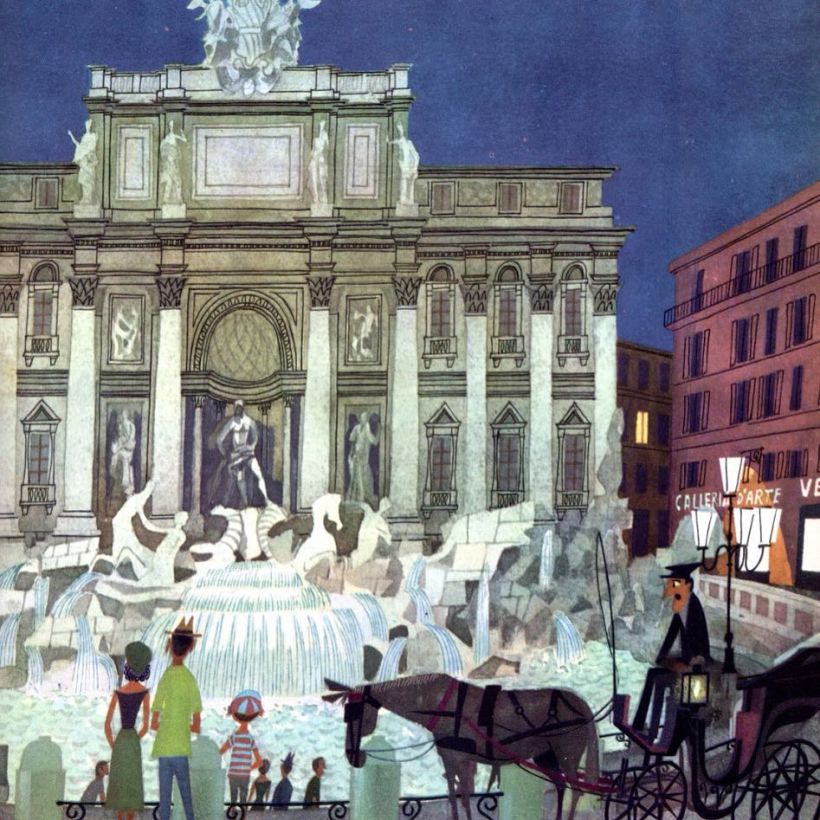
Katsushika Hokusai
@katsushikahokusai
Katsushika Hokusai was a Japanese artist, printmaker, and painter who lived from 1760 to 1849. He is most recognized for his woodblock print series Thirty-Six Views of Mount Fuji , made in response to a domestic travel boom in Japan.
From this collection, one piece in particular stood out among the rest. The Great Wave Off Kanagawa is arguably the most iconic piece of work in Japanese art, and went on to inspire many 19th-century European painters.

Evan Hecox is a multidisciplinary artist and designer based in Colorado, whose work often takes inspiration from travel.
He has a particular talent for capturing the mood and feeling of a place or moment in time, as well as giving new life and beauty to objects that are often overlooked or dismissed as mundane.

Tom Haugomat
@tomhaugomat
The Paris-based illustrator and director has had his work featured in Air France Magazine, Revue XXI, and Le Monde. His illustrations have a distinctly cinematic quality, perhaps as a result of his background making short films.
Perhaps the most interesting element of his work is that his characters have no facial features, although he is still able to convey depth and emotion through his use of color and negative space.
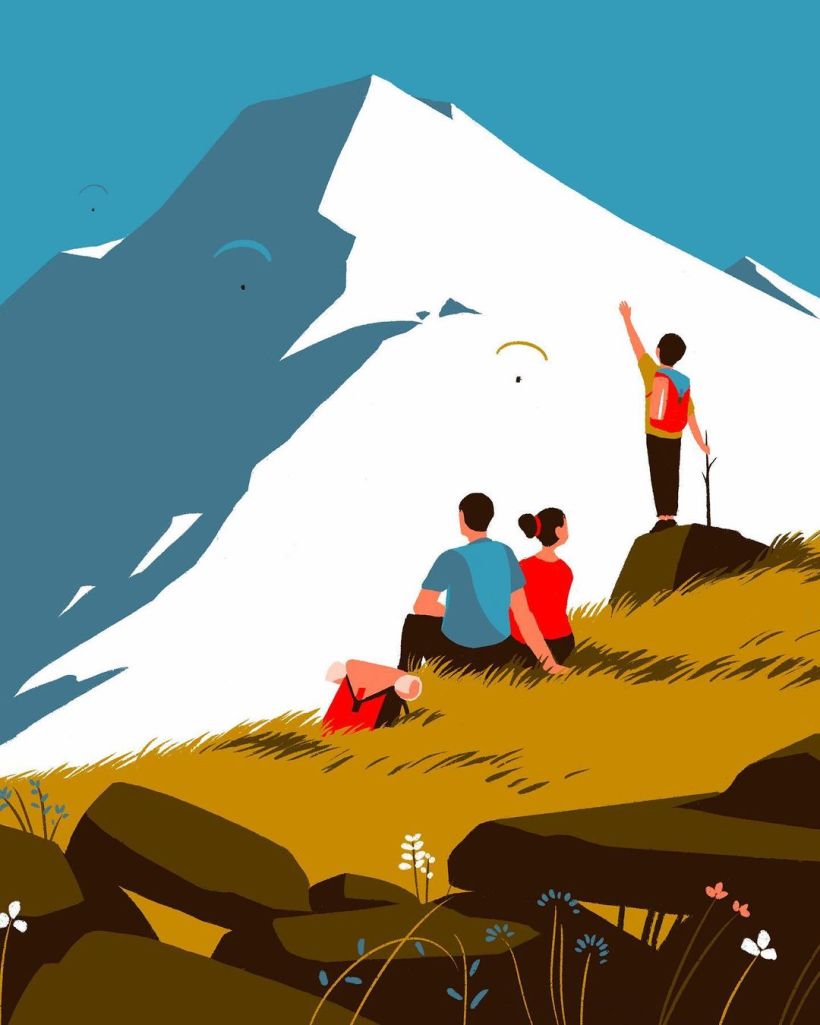
Josh Cochran
@joshcochran
This Grammy-nominated, Brooklyn-based illustrator has clients including Adidas, Apple, and The New Yorker , and he currently teaches at the School of Visual Arts in NYC.
He is known for his bold colors, humorous drawings, and urban murals.
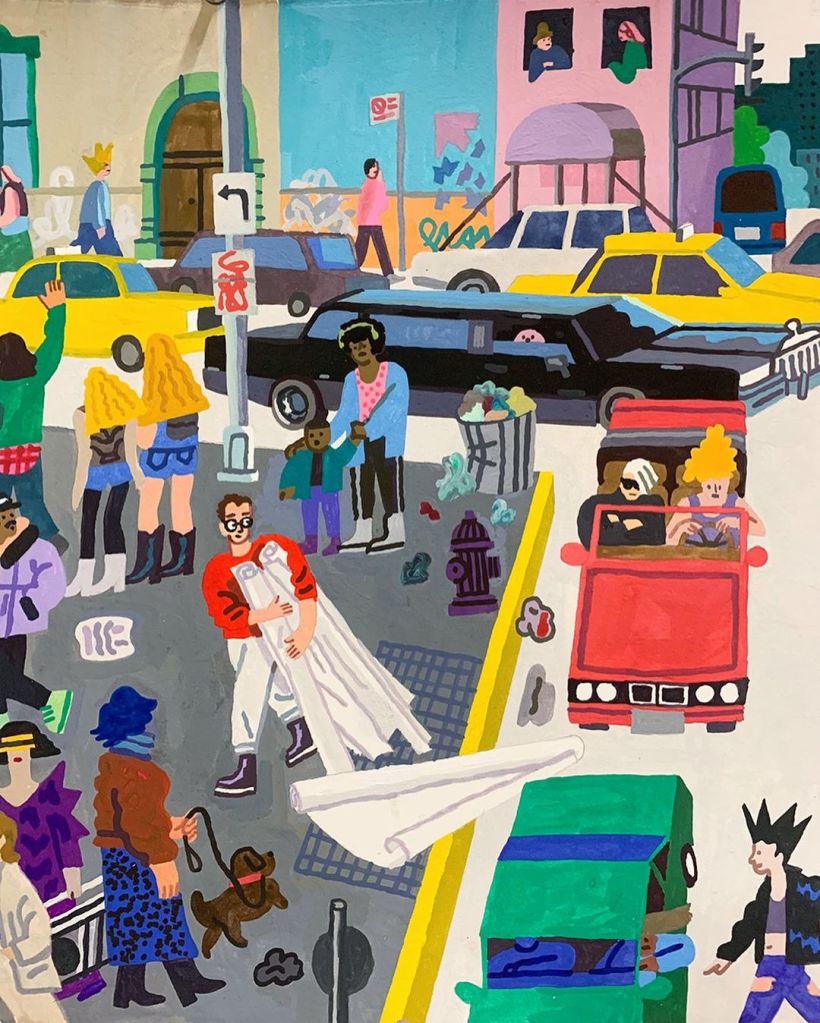
Bruno Mangyoku
@brunomangyoku
Bruno Mangyoku has worked as an illustrator and animation director who is greatly influenced by American graphic novelists such as Daniel Clowes and Charles Burns.
He uses a limited, yet highly contrasting color palette, focusing primarily on character design and silhouettes.
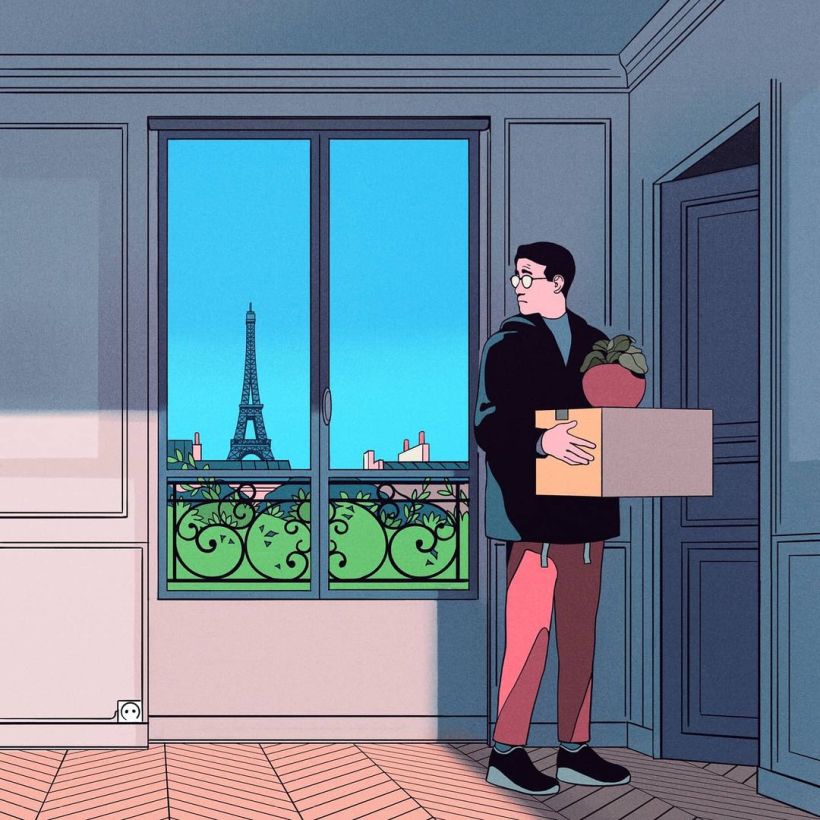
Hokyoung Kim
@hokyoungkim_
The South-Korean artist and illustrator lists clients including The New Yorker , The Washington Post , Apple, and Disney.
She finds inspiration in the Japanese comics and animations she grew up watching, and her work focuses on transmitting a strong sense of mood and atmosphere.
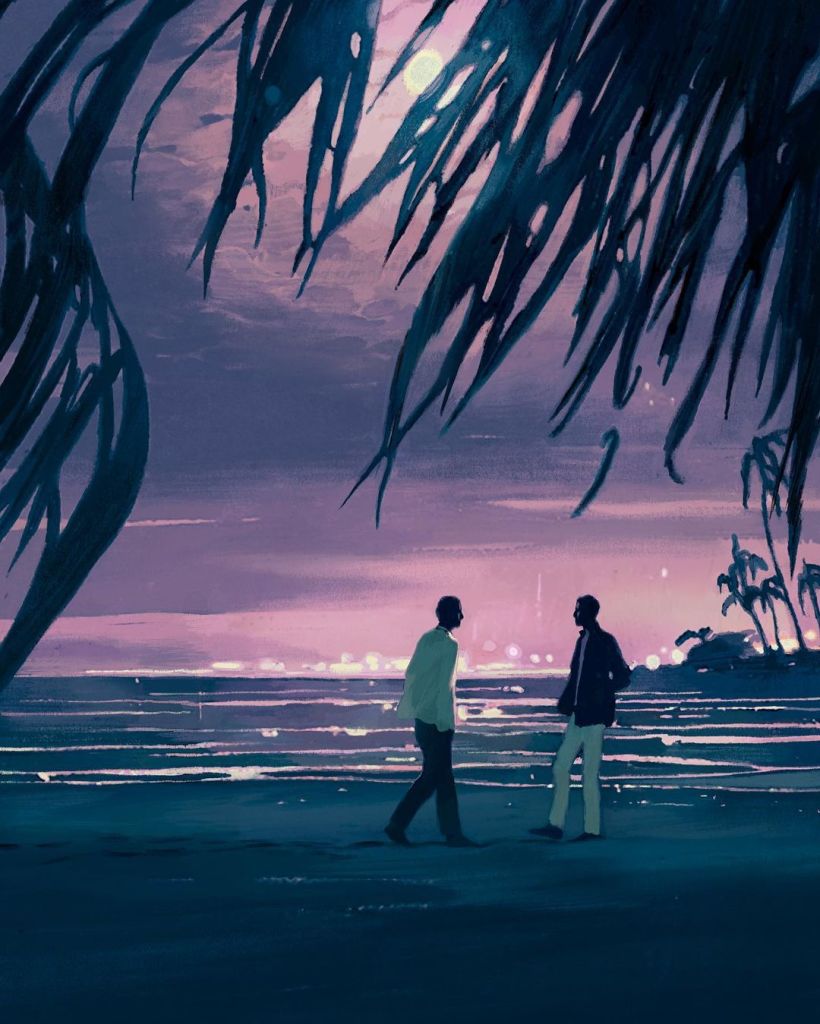
STRAUTNIEKAS
@strautniekas
The freelance illustrator studied at the Fine Arts Academy in Vilnius, before working in advertisement, animation and graphic design, with clients including the Royal Mail, The Independent , Penguin Random House.
His retro style, with soft colors and lines, lend him his unique style.

Christoph Niemann
@abstractsunday
Christoph Niemann is an illustrator, graphic designer, and children’s book author most known for his Sunday Sketches , quirky and humorous illustrations that take everyday objects and turn them into something unexpected.
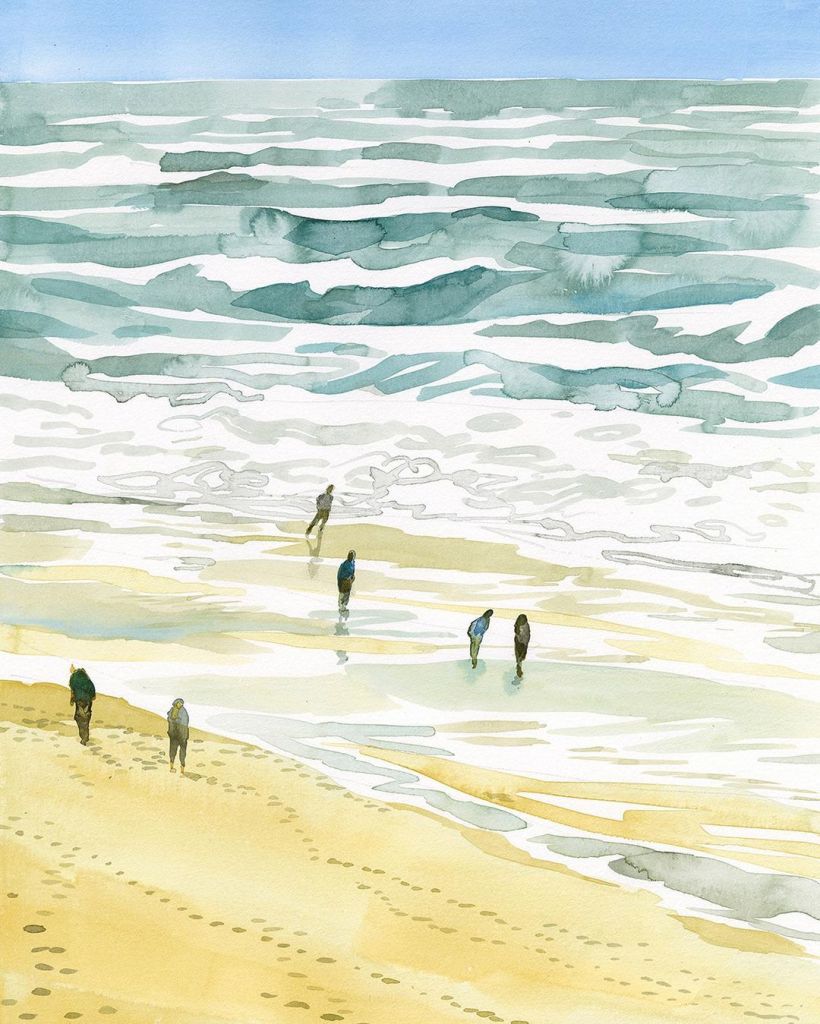
Jon McNaught
This London-based cartoonist, illustrator, and printmaker has clients including Penguin Books, Faber, The New York Times , and The Wall Street Journal .
His skill lies in taking the mundane and everyday and turning them into works of art, using simple shapes and a limited color palette.

If you enjoyed this references and want to know more about travel illustration, don't miss Alex Green's course Travel Illustration: Recreate your favorite place and learn digital illustration techniques with a splash of acrylic paint to create artwork inspired by a photograph of a place you love.
You may also like:
- What Is an Illustrated Life Journal and How to Start One? - Create a Travel Sketchbook Without Leaving Your House, with Powerpaola - What Is an Inspiration Board and How to Create One for Your Bullet Journal - Exploratory Sketchbook: Find Your Drawing Style , a course Sarah van Dongen - Lifestyle and Travel Photography , a course by Julia Nimke
Recommended courses
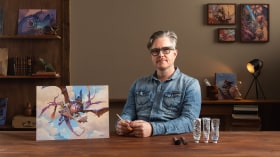
Fantasy Acrylic Painting
A course by Jesper Ejsing
Unleash your creativity in acrylic painting. Learn techniques for composition, sketching, and color to bring characters to life.
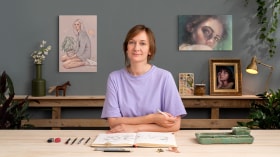
Portrait Sketchbooking: Explore the Human Face
A course by Gabriela Niko
Discover the fundamentals of portraiture by learning to draw facial features and tracking your progress in a sketchbook
- 95% ( 2.6K )

Expressive Architectural Sketching with Colored Markers
A course by Albert Kiefer
Learn to create expressive sketches of buildings and landscapes filled with color and practice drawing by hand
- 99% ( 2.2K )
- Follow Domestika
Part of the TTC Family of Brands
GET A QUOTE
DESTINATIONS
WAYS TO TRAVEL
SPECIAL OFFERS
1 888 680 1241
Art & History Tours

REQUEST MORE INFORMATION
Art Lover's Tour of Europe - Italy, Switzerland, France, Netherlands
Grand history tour of europe - france, germany, czech republic, scientific marvels of europe - italy, switzerland, france, england.
Your search for ""
Day 1: Welcome to Rome
Welcome to Rome! On arrival you are met by your Travel Director and transferred to your accommodation. (D)
Day 2: Rome Sightseeing
This morning, visit the Vatican Museum with a Local Expert. Admire the papal art collection and enter the Sistine Chapel and admire Michelangelo’s masterpiece on its ceiling. Next door, in St Peter’s Basilica, see one of Michelangelo’s early works, the Pieta, and the splendid dome, completed after his death. Afterwards, visit the Colosseum, where the gladiators prepared for battle. (B, RD)
Day 3: Tuscan Hills onto Florence
Journey through the picturesque Tuscan Hills towards Florence. On arrival, join a local art historian to see Michelangelo’s David in the Accademia Museum. (B, D)
Day 4: Renaissance Florence
This morning, see the multi-coloured marble cathedral, bell tower and baptistery, adorned by Ghiberti’s ‘Gates of Paradise’. Then join a Local Expert for a visit to the Uffizi Galleries, one of the oldest and most famous art museums in Europe. You'll also enjoy works by Michelangelo, Botticelli and Raphael, among other masterpieces. (B, RD)
Day 5: Leaning Tower of Pisa & Milan
Stop first in Pisa to see the incredible Leaning Tower, as well as its splendid cathedral and baptistery. Continue north to the financial and fashion capital Milan. (B, D)
Day 6: Experience Milan
This morning, visit the Church of Santa Maria delle Grazie with a Local Expert. It is an outstanding work of architecture and an emblem within the Catholic tradition, and is perhaps even more famous for its connection to Leonardo Da Vinci’s fresco of ‘The Last Supper’, which is preserved inside its refectory (dining hall). The Church is one of Renaissance art’s most important testimonies and has therefore been included as a UNESCO World Heritage Site (tickets to the Last Supper are subject to availability). Later, for a change of pace, we embark on an alternative visit to Milan to see urban graffiti, murals and street art scattered around the city. Get a glimpse of an alternative Milan, meet colourful characters, learn about modern-day Milan and be inspired by the vibrancy of city life. (B, D)
Day 7: Milan to Basel
Travel across the border into Switzerland. En route, we stop for a cheese or chocolate tasting before heading to Basel. (B, D)
Day 8: Basel Sightseeing
Explore Basel, with a Local Expert, concluding with a visit to Foundation Beyeler In 1997, the famous collection of Ernst and Hildy Beyeler in Riehen. The collection contains around 200 pictures and sculptures, including works by Cézanne, Picasso, Rousseau, Mondrian, Klee, Ernst, Matisse and Newman. Famous around the world, the astounding temporary exhibitions are highlights of your visit. (B, D)
Day 9: Basel to Paris
Travel through the French countryside to Paris. (B, D)
Day 10: Best of Paris
After an orientation tour, visit one of the world's best-known art collections at the Louvre Museum. A specialist art historian guides you through the galleries to see the Venus de Milo, Winged Victory, Mona Lisa and more (Louvre visit subject to availability). Continue on a visit to the Notre Dame Cathedral, famously protected by its roof-top gargoyles, to learn about over-arching Parisian history. This evening, embark on an illuminations journey in Paris to see iconic sights at night. (B, HD)
Day 11: Musee De L’orangerie & Giverney
This morning, visit the Musée de l'Orangerie, an art gallery of impressionist and post-impressionist paintings. Though most famous for being the permanent home of eight Water Lilies murals by Claude Monet, the museum also contains works by Paul Cézanne, Henri Matisse, Amedeo Modigliani, Pablo Picasso, Pierre-Auguste Renoir, Henri Rousseau, Alfred Sisley, Chaim Soutine, and Maurice Utrillo, among others. Afterwards, we head to Monet’s garden in Giverney to see the inspiration of some of his most famous works before heading back to Paris. (BB, D)
Day 12: Paris to Amsterdam
Travel through northern France and Belgium en route to Amsterdam. (BB, D)
Day 13: Amsterdam Galleries – Rijksmuseum & Vincent van Gogh Museum
Admire world-famous masterpieces in the Rijksmuseum, which has on display 8,000 objects of art and history. There is a total collection of 1 million objects, spanning the years 1200–2000AD, among which are masterpieces by Rembrandt, Frans Hals, and Johannes Vermeer. Then onto the Vincent van Gogh Museum, which is dedicated to the works of Vincent van Gogh and his contemporaries in Amsterdam. The museum is home to the largest collection of Vincent van Gogh's paintings and drawings in the world. This evening, enjoy a canal cruise dinner to bid farewell to our time in Europe. (B, FD)
Day 14: Farewell Amsterdam
Your tour concludes after breakfast with a transfer to the airport for your onward flight. (B)
Day 1: Welcome to Paris
Welcome to Paris! On arrival at Charles De Gaulle airport you will be met by your Travel Director and transferred to your hotel.
Day 2: Paris From a History Perspective
Learn about the significance of the French Revolution and visit key sites such as Place de la Bastille, Les Invalides War Museum, the Conciergerie and Place de la Concorde. In the evening enjoy a walk along the Champs-Elysees, followed by a cruise along the River Seine. (BB)
Day 3: Disneyland in Paris
Spend the day at Disneyland Paris. Included in your tour is a full-day, one-park pass to either Disneyland Park or Disney Studio Park. (BB)
Day 4: Versailles & D-Day Memorial
Travel this morning to Versailles and visit the Palace of Versailles to see its opulent rooms and gardens. Experience the extraordinary Hall of Mirrors where the historic Treaty of Versailles was signed, ending World War I. Continue to Arromanches and visit the D-Day Memorial. It’s then onto Bayeux for our overnight stay. (BB, D)
Day 5: Battle of the Somme
Today we visit Amiens and the nearby Somme Battlefields, where some of the most intense fighting took place during World War I. More than 3 million men fought in this battle with1 million wounded or killed. We visit some of the many interesting memorials and museums dedicated to the fallen. Our overnight stay is in Amiens. (BB, D)
Day 6: The Lost Territories - Strasbourg
We travel to Verdum where you will visit the Verdum Battlefields and War Memorial. Our journey continues to Strasbourg, on the border of Germany, for our overnight stay. (BB)
Day 7: Strasbourg to Colmar
In the morning travel to Colmar where you will enjoy a boat tour in the canal quarter, followed by a walking tour around Petite Venise and the historic centre. From Colmar, continue to Riquewihr for a walking tour in the town. We then visit Chateau du Haut-Koenigsbourg for a visit to the castle, before arriving back in Strasbourg for our overnight stay. (BB)
Day 8: Europa Park & Friedrichshafen
Spend the day at the Europa Park, one of the best theme parks in Europe. This evening we overnight in Friedrichshafen. (BB, D)
Day 9: Meersburg Castle onto Munich
Begin your morning with a walk up to Meersburg Castle. We then make our way to the well-known Neuschwanstein for a tour to the castle and a horse-carriage ride down the mountain. Then it’s onto Munich where a Local Expert will take you on a walking tour in the city centre, including key sites related to Hitler’s time in Munich and the Third Reich. Finally we visit the Nazi Documentation Centre. (BB)
Day 10: Eagle’s Nest & Obersalzburg
A short drive out of Munich, visit Hitler’s former retreat, known as the Eagle’s Nest. Afterwards, stop for lunch at Obersalzburg (own expense) and continue to the Konigsee for a boat tour on the Lake and a chance to swim in Lake Chiemsee. Return to Munich for your overnight stay. (BB)
Day 11: Dachau & Rothenburg
We start the day with a tour to the Munich Residenz Museum. It is then onto Dachau for a sobering visit to the concentration camp. Our overnight stay is in Rothenburg ob der Tauber. (BB)
Day 12: Explore Medieval Rothenburg
Rothenburg was regarded by the Nazis as the most “German” of German towns. Visit the Museum of Torture, explore the medieval city and battlements, and join a Nightwatchman tour. (BB)
Day 13: Nazi History in Nuremberg
We depart Rothenburg and continue to Nuremburg in the morning. On arrival, join a Local Expert for a tour to city centre. Walk up to the Kaiserburg Castle, visit the Nazi parade grounds and the Albert Speer Documentation Centre to bring to life the history of Hitler’s rise to power. In the afternoon, visit the Palace of Justice and Courtroom 600, the location of the Nuremburg Nazi trials. (BB)
Day 14: Onto Magical Prague
This morning travel to Prague, the capital of the Czech Republic. On arrival, join your Travel Director for an orientation tour of the old town centre, including the town square, St Nicholas Church and Tyn Church. Afterwards visit Prague Castle and walk to Charles Bridge. (BB)
Day 15: Museum visits in Prague
Visit The Prague Communism Museum, Jewish Museum and the Kepler Museum today. (BB)
Day 16: Military History in Dresden
In the morning we travel to Dresden where we join a Local Expert for a tour of the Dresden’s Zwinger Palace, the Bundeswehr Military History Museum, the Dresden Armoury and Frauenkirche. (BB)
Day 17: Tropical Islands Water Park
Depart Dresden and spend the day at the Tropical Islands Water theme park. (BB)
Day 18: Berlin Sightseeing
Tour to Berlin starts with a visit to the ‘Story of Berlin’ Museum to provide an overview of the city’s tumultuous history. Your journey with a Local Expert includes the Brandenburg Gate, the Reichstag, Checkpoint Charlie, sections of the Berlin Wall and Alexanderplatz. Visit also the Zeppelin Field and the Jewish Museum, the German Resistance Memorial Centre and the Holocaust Memorial. (BB)
Day 19: Farewell Berlin
On our final morning we visit the Wansee Haus Museum and Documentation Centre of the “Final Solution”. Later, explore the DDR Museum to learn about life under communist rule after the end of World War II. We bid farewell to Berlin and make our way to the airport for flights home. (BB)
Day 1: Welcome to Florence
Welcome to Italy! On arrival at Bologna airport, you will be met by your Travel Director and driver. We continue to our hotel in Florence where you’ll have time to settle in, before enjoying a welcome dinner at the hotel. (WD)
Day 2: Discover Florence
After a restful night’s sleep and breakfast at the hotel, we visit the Basilica di Santa Croce and Museo Galileo, home to the only surviving instruments designed and built by Galileo himself. The remainder of the day is free for you to explore Florence. (BB)
Day 3: Florence at your Leisure
Enjoy a day at leisure. Explore captivating Florence at your own pace or join your Travel Director for a day tour to Vallombrosa to see the Monastery where Galileo studied. (Guided tours only available in July & August). (BB)
Day 4: Bologna to Padua
After breakfast at your hotel, spend the morning at leisure. In the afternoon, we drive through Bologna to Padua where you’ll enjoy a local 3-course dinner alongside a guest lecturer from the Padua University. (Lecturer organised by MTG.) (BB, HD)
Day 5: Padua to Venice
Today we visit the Il Bo University, the second oldest university in Italy, for a guided tour. The afternoon is free for you to visit the Botanical gardens and St Anthony Basilica. Later in the afternoon, we continue to our hotel, situated in Mestre Venice, where we will stay for 2 nights. (BB)
Day 6: Romantic Venice at your Leisure
After breakfast, the rest of the day is yours to explore romantic Venice at leisure. (BB)
Day 7: Onto Swiss Geneva
Les Nations Hotel After a restful night’s sleep, we cross the border to Switzerland. On arrival into Geneva enjoy a late afternoon cruise on Lake Geneva. Afterwards we check into our hotel. (BB)
Day 8: Nuclear Science in Cern & Geneva Exploration
After breakfast we travel to CERN (subject to availability) to visit the European Organisation for Nuclear Research and see the Large Hadron Collider, the world’s largest and most powerful particle accelerator. The remainder of the day is free to explore the city of Geneva. (BB)
Day 9: Geneva to Paris
Enjoy a delightful drive through the French countryside, as we make our way to Paris. On arrival you are free to relax or explore the city of love on your own. Gather for dinner at the hotel, during which you’ll enjoy the company of a guest speaker from the Marie Curie Museum. (Lecturer organised by MTG.) (BB, D)
Day 10: Gardens of Paris
Visit the Botanical Gardens in the morning. Here you will discover the Alpine Gardens, which contain 2000 mountain plants from all over the world. Wander through the rose garden, the iris garden and the Botany School's Garden, where 4500 species are labelled and regrouped by families. (BB)
Day 11: Arts & Metier Museum in Paris
Take time to visit the Arts and Metier Museum and spend the rest of the day at leisure to explore the wonderful city of Paris. (BB)
Day 12: Science in Paris
After breakfast in the morning, visit the Marie Curie Museum. Completely re-designed, the Museum reveals the life and times of a family of unusual physicists and their huge contribution to science. The rest of the day is at leisure. (BB)
Day 13: Paris at your Leisure
Enjoy a day at leisure to explore the city of Paris. (BB)
Day 14: Eurostar to London
Bid farewell to Paris today, as we travel by Eurostar to London. On arrival we will be met and transferred to a local pub for lunch. We’ll then check into our hotel and you’ll have the rest of the day to enjoy at leisure. (BB, L)
Day 15: Day Tour to Kent
Today we travel to Kent to visit the Down House, the home of Charles Darwin, before returning to our London hotel. (BB)
Day 16: Scientific Marvels of London
Enjoy a full day of sightseeing, including a visit to the Royal Observatory, Flamsteed, Meridian Courtyard and Maritime Museum, and a cruise on the River Thames. The remainder of the day is at leisure. (BB)
Day 17: Royal Society & Faraday Museum in London
This morning we visit the Royal Society followed by a visit to the Faraday Museum at the Royal Institution. Lunch is served at a local restaurant. (BB, L)
Day 18: Westminster & Science Museum in London
We spend the morning visiting Westminster Abbey and the afternoon exploring the Science Museum in Kensington. (BB)
Day 19: Discover Cambridge
After breakfast, we continue to the university town of Cambridge for a 2-night stop. Enjoy a private walking exploration of the town including a visit to Trinity College – the largest of the Cambridge Colleges. (BB)
Day 20: Cambridge at your Leisure
Today is yours to explore at leisure. We meet again in the evening to celebrate the end of our tour with a farewell dinner at our hotel. (BB, D)
Day 21: Farewell from London
Our science tour has come to an end. Transfer from Cambridge to the London Heathrow Airport for your flight home. (BB)
ALL THE SIGHTS AND THE INSIGHTS, UP CLOSE AND PERSONAL, IN COMFORT AND IN STYLE
EXPLORE WITH INSIGHT
UK and Ireland
USA and Canada
Latin America
North Africa
TOUR STYLES
Discovery Journeys
Regional Journeys
Country Roads
Domestic Escapes
Special Interest Tours
Get A Quote
Request A Brochure
Travel Insurance
The Insightful Blog
Privacy Policy
Booking Conditions
Tour Deposit Level
Travel Updates
My Personal Information
Do Not Sell or Share My Personal Information
Selected Region
United States
United Kingdom
New Zealand
South Africa
© Insight Vacations 2024. All Rights Reserved.
Cookie Policy
On the Road: Best Traveling Paintings
Anastasia Manioudaki 17 November 2023 min Read
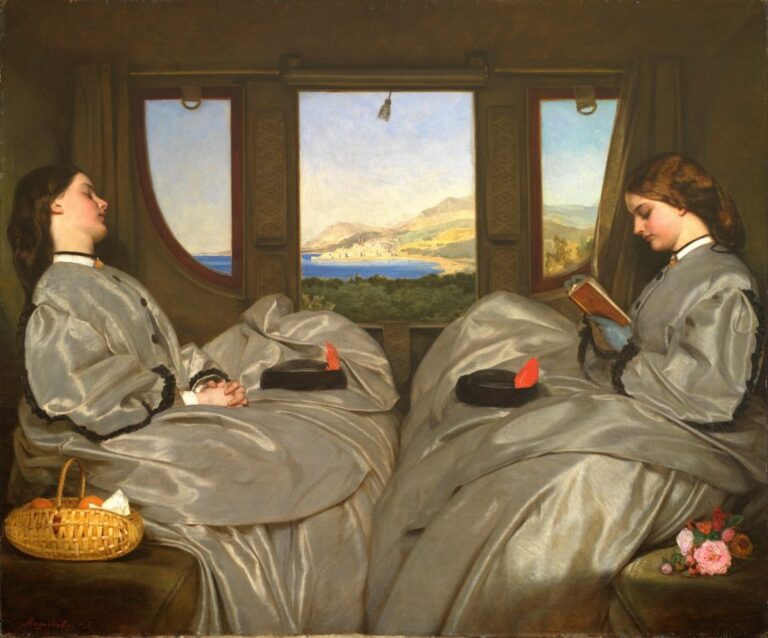
Augustus Leopold Egg, The Traveling Companions, 1862, Birmingham Museum and Art Gallery, Birmingham, UK.
Recommended
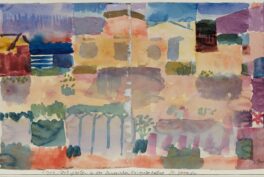
Art Travels
Artists’ Beloved Travel Destinations as Seen Through Their Art
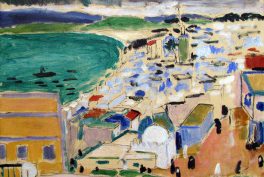
Travel in the Footsteps of Henri Matisse in Morocco
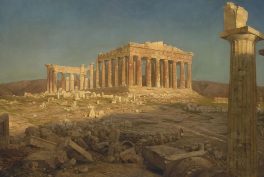
Around the World with a Painter: Frederic Edwin Church’s Travels
“ As you set out for Ithaka, hope your road is a long one,” thus begins Ithaka , the famous poem by C.P. Cavafy. When we travel, we always think about the destination – thinking of the time we spend to arrive as a hassle, a necessary evil. But, as Cavafy and many other artists will tell you, being on the road has its own kind of magic. Let us look at some of the best traveling paintings.
Traveling by Train: Traveling Companions
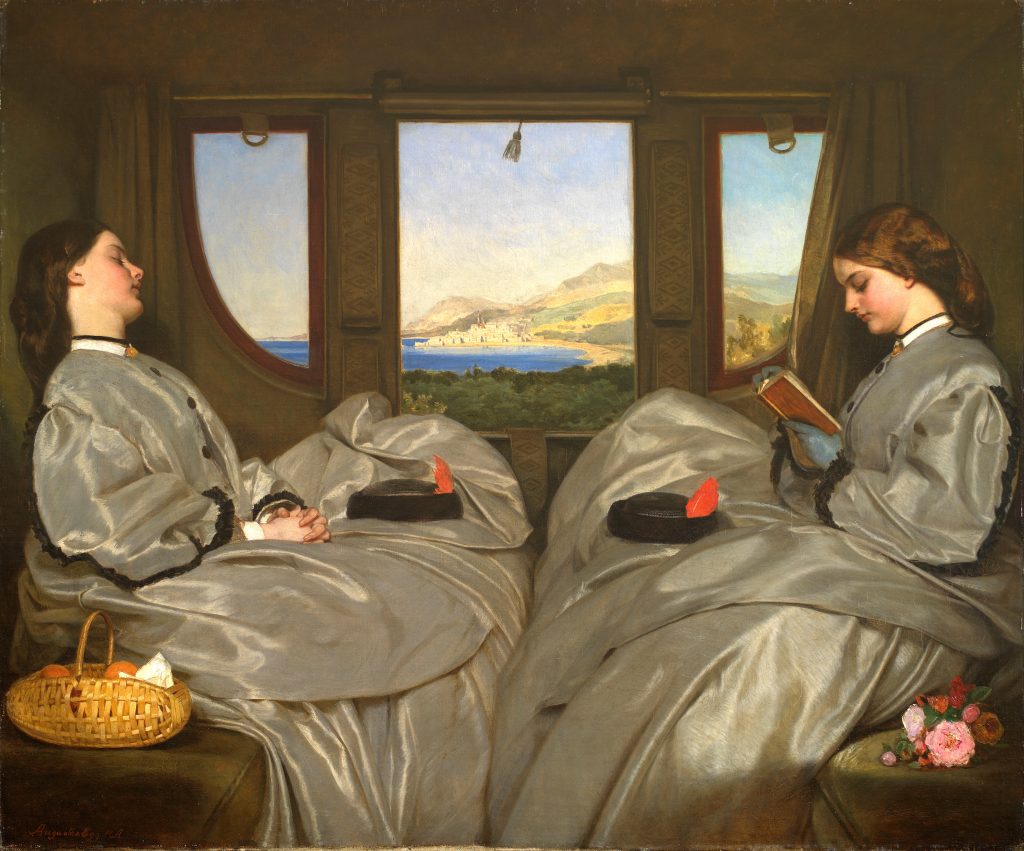
Director Wes Anderson would surely love this painting, or maybe not. At first glance, the scene inside the railway carriage looks completely symmetrical: the two women identical. They wear the same dress, the same hat, that both have placed on their lap. The window is split into three parts, emphasizing the sense of symmetry. However, there are small details that dissolve the similarity. The woman on the right has her hair up, wears gloves, and is reading a book. Beside her sits a flower bouquet, while the other with loose hair and bare hands is daydreaming, with a basket beside her.
Sadly, neither of them pays attention to the magnificent view of the French Riviera outside the window. They both remain firmly enveloped in their private worlds, eschewing the experience of traveling and thus putting an ironic ring to the painting’s title.
Traveling by Boat: Breezing Up
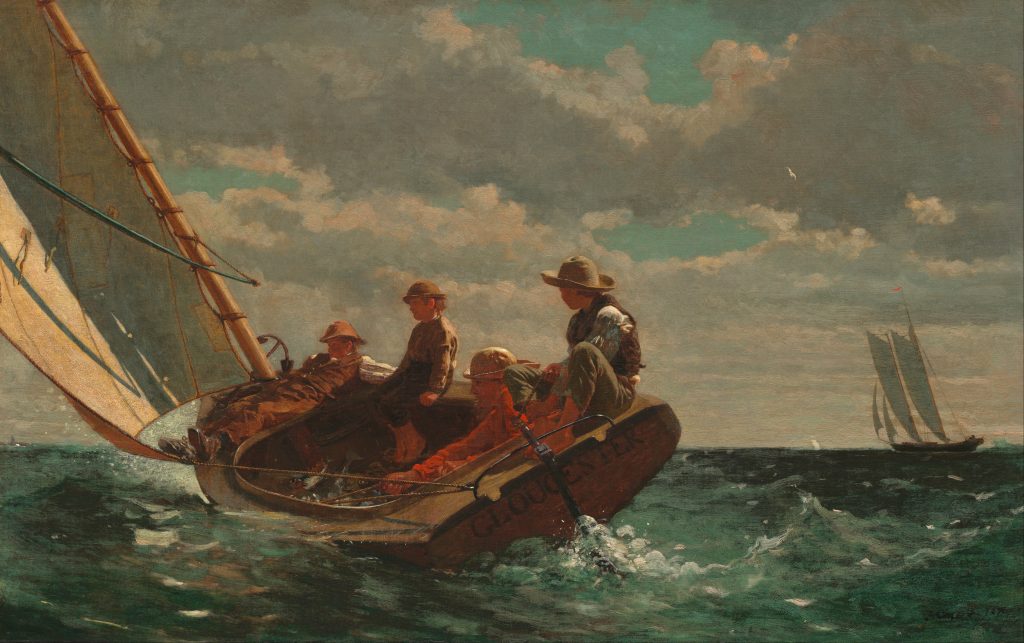
Traveling for business does not have to be boring. On a cloudy afternoon, a fisherman and three boys return from a day at sea. The boat moves quickly on the waves. The man and the boys are perched on the right side to balance the breeze that pushes the sail. It has been a good day. The floor of the boat is teeming with fish. At last, they have some time to relax. Look at the young boy in the front: he is sprawled across the bow taking in the wind and the sea.
Winslow Homer presented this painting in 1876, the centennial year of the United States. This view of American life completed the climate of postwar nostalgia at the time. Stylistically, the loose brushstrokes and warm colors remind us of the French Realism of Gustave Courbet and Edouard Manet .
Traveling by Boat: Great Wave Off Kanagawa
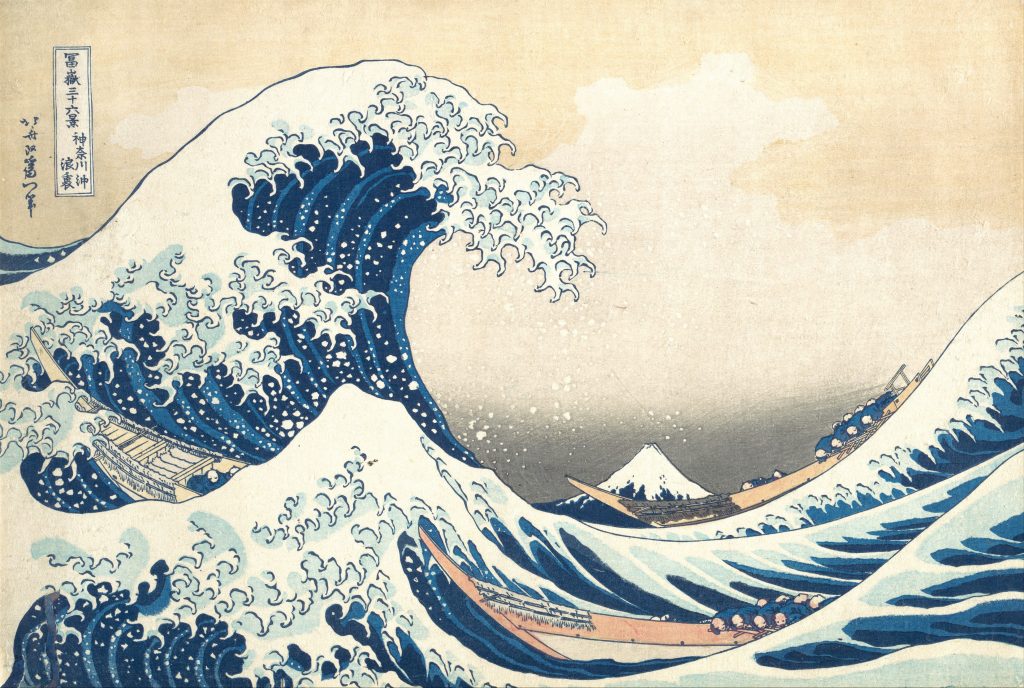
The Great Wave is probably the most famous piece of Japanese art. A huge frothing wave is about to crash on three fishing boats. The fishermen are frantically trying to get to shore – being at sea is not always fun. In the distance, the sacred mountain of Japan, Mount Fuji, is dwarfed by the immense body of water.
Katsushika Hokusai’s print is part of his series Thirty Six Views of Mount Fuji , but through the use of linear perspective, the largest mountain in Japan seems small. However, the waves are perfectly framed around it to make it stand out.
Traveling By Boat: The Last of England
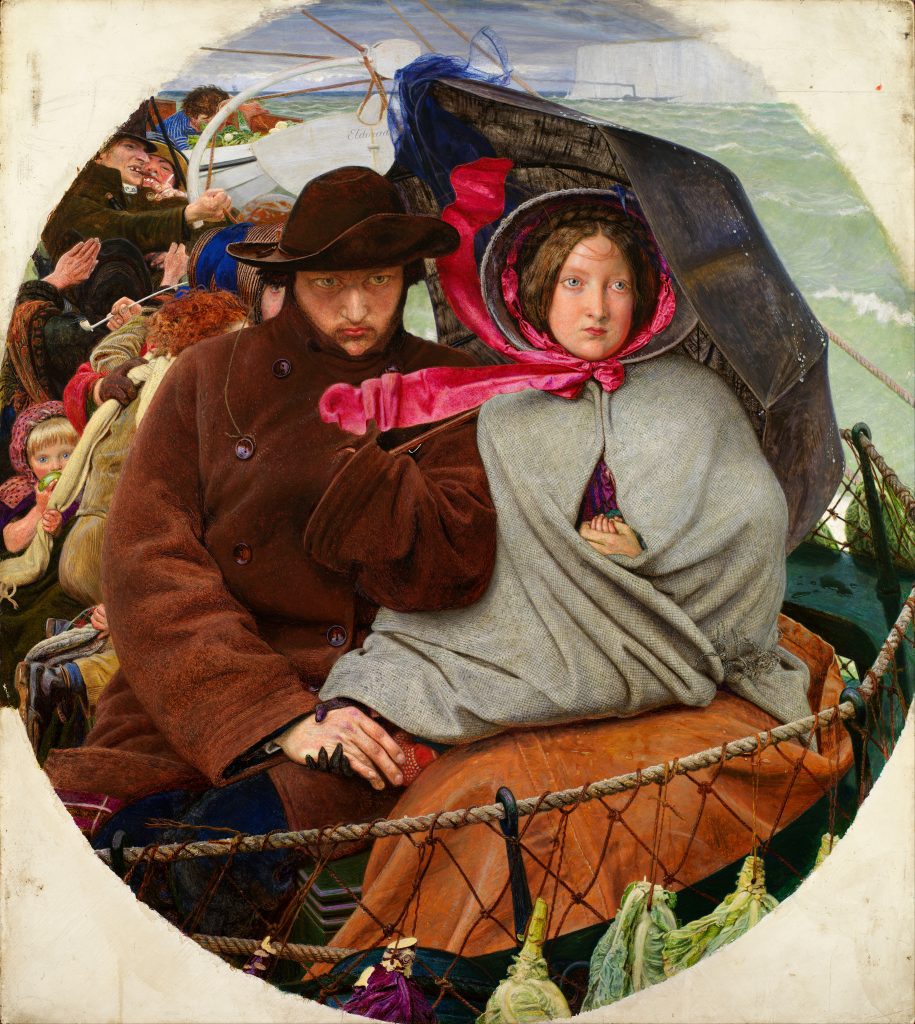
A young family sets on an uncertain journey with dreams for a new life. In The Last of England , we see a pair of immigrants beginning their voyage to Australia. The man seems broody and stressed while the woman is resigned to her fate. From an opening in her cloak, we barely see her clutching her baby’s hand. Emigration is surely one of the worst reasons to be on the road – being forced to leave everything and clinging on to hope. The white cliffs of Dover are looming in the back, the last view of England, while in front of the couple, strung cabbages reminds us of the long journey ahead.
Traveling by Car: Tamara in the Green Bugatti
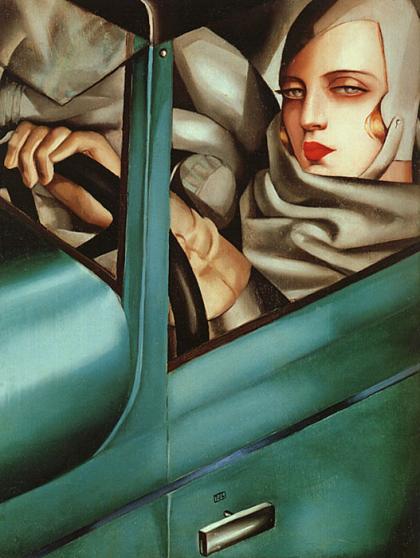
With the turn of the 20th century, traveling by car became more of a commodity than it used to be. Tamara de Lempicka , nicknamed the baroness with a paintbrush, epitomizes the modern woman of the roaring 20s. Her stylish persona, which she meticulously built, featured in all the most forward-thinking magazines in Europe.
Tamara in a Green Bugatti was a commission for the cover of the German magazine Die Dame . In her characteristic Art Deco style, the artist portrays herself as an independent, emancipated, and sexually liberated woman . She stares smugly at us, with her leather gloves and blowing majestic scarf. The car is another symbol of her emancipation. A woman driving in the 20s was a rare sight. Moreover, it is a nod to the contemporary futurist movement that celebrated speed and everything that had to do with the modern world.
Traveling by Caravan: Pilgrims Going to Mecca
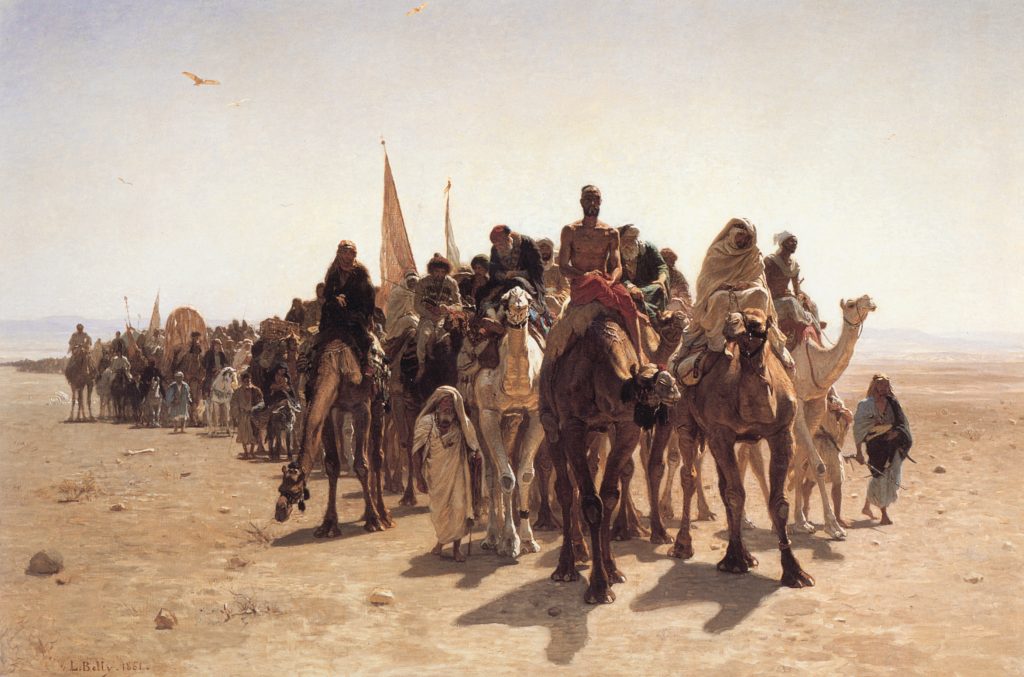
Before trains and cars, camel caravans crossed the desert to deliver goods and offer safe passage to travelers. Leon Belly’s orientalist painting shows a caravan heading towards Mecca, a place of pilgrimage for all Muslims. The convoy advances towards the viewer in a dramatic fashion.
Belly manages to capture the pious but weary faces of the pilgrims under the scorching sun. Adding an exotic note, the camels are large enough to dominate the canvas. Even though its subject matter is chiefly Islamic, Belly creates a more expansive religious meaning. Take notice to the left of the column; we can see a man walking along with a woman and child on a donkey – the pair refers to the biblical theme of The Flight into Egypt .
There are many reasons and many ways to be on the road. Whatever our destination, time spent traveling fills us with new experiences. Or, as Cavafy says, “Ithaka gave you the marvelous journey. Without her you wouldn’t have set out.”
- Augustus Leopold Egg
- Ford Madox Brown
- Katsushika Hokusai
- Tamara de Lempicka
- Winslow Homer
Get your daily dose of art
Click and follow us on Google News to stay updated all the time
We love art history and writing about it. Your support helps us to sustain DailyArt Magazine and keep it running.
DailyArt Magazine needs your support. Every contribution, however big or small, is very valuable for our future. Thanks to it, we will be able to sustain and grow the Magazine. Thank you for your help!
Anastasia Manioudaki
Art Historian, she graduated from the Department of History and Archeology of the University of Athens and has an MA in Art History from the University of Sussex. She is a member of the Association of Greek Art Historians. Her articles have been published in Ta Nea tis Technis and avopolis.gr.
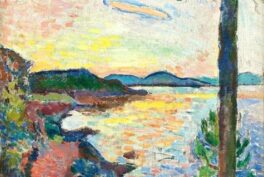
Top 5 Artsy Travel Destinations in 2024 Through Paintings
We suggest you a selection of the best tourist destinations and festivals by the hand of great artists!
Andra Patricia Ritisan 11 March 2024
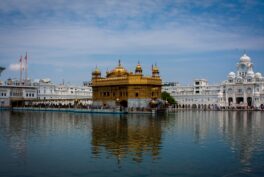
Art Travels: Golden Temple of Amritsar
Nestled in the city of Amritsar in Northwestern India is the iconic Harmandir Sahib or Darbar Sahib, better known as the Golden Temple. This sublime...
Maya M. Tola 8 January 2024
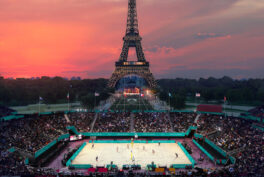
Art and Sports: En Route to the Paris 2024 Olympics
The forthcoming Paris 2024 Summer Olympics will bridge the worlds of art and sport, with equestrian competitions at the Palace of Versailles, fencing...
Ledys Chemin 9 April 2024
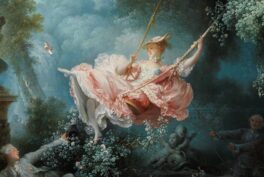
10 Masterpieces You Need To See in London
London is a city full of masterpieces. It is not only one of the biggest art hubs but also one of the most multicultural places in the entire world.
Sandra Juszczyk 23 February 2024
Never miss DailyArt Magazine's stories. Sign up and get your dose of art history delivered straight to your inbox!

Enjoy fast, free delivery, exclusive deals, and award-winning movies & TV shows with Prime Try Prime and start saving today with fast, free delivery
Amazon Prime includes:
Fast, FREE Delivery is available to Prime members. To join, select "Try Amazon Prime and start saving today with Fast, FREE Delivery" below the Add to Cart button.
- Cardmembers earn 5% Back at Amazon.com with a Prime Credit Card.
- Unlimited Free Two-Day Delivery
- Streaming of thousands of movies and TV shows with limited ads on Prime Video.
- A Kindle book to borrow for free each month - with no due dates
- Listen to over 2 million songs and hundreds of playlists
- Unlimited photo storage with anywhere access
Important: Your credit card will NOT be charged when you start your free trial or if you cancel during the trial period. If you're happy with Amazon Prime, do nothing. At the end of the free trial, your membership will automatically upgrade to a monthly membership.

Buy new: $14.63 $14.63 FREE delivery Thursday, May 2 on orders shipped by Amazon over $35 Ships from: Amazon.com Sold by: Amazon.com
Return this item for free.
Free returns are available for the shipping address you chose. You can return the item for any reason in new and unused condition: no shipping charges
- Go to your orders and start the return
- Select the return method
Buy used: $8.79
Fulfillment by Amazon (FBA) is a service we offer sellers that lets them store their products in Amazon's fulfillment centers, and we directly pack, ship, and provide customer service for these products. Something we hope you'll especially enjoy: FBA items qualify for FREE Shipping and Amazon Prime.
If you're a seller, Fulfillment by Amazon can help you grow your business. Learn more about the program.

Download the free Kindle app and start reading Kindle books instantly on your smartphone, tablet, or computer - no Kindle device required .
Read instantly on your browser with Kindle for Web.
Using your mobile phone camera - scan the code below and download the Kindle app.

Image Unavailable

- To view this video download Flash Player
Follow the author

The Art of Travel Paperback – Illustrated, May 11, 2004
Purchase options and add-ons.
- Print length 272 pages
- Language English
- Publisher Vintage
- Publication date May 11, 2004
- Dimensions 5.16 x 0.58 x 7.99 inches
- ISBN-10 0375725342
- ISBN-13 978-0375725340
- See all details

Frequently bought together

Similar items that may deliver to you quickly

Editorial Reviews
From the inside flap, from the back cover, about the author, excerpt. © reprinted by permission. all rights reserved., product details.
- Publisher : Vintage; Reprint edition (May 11, 2004)
- Language : English
- Paperback : 272 pages
- ISBN-10 : 0375725342
- ISBN-13 : 978-0375725340
- Item Weight : 7.8 ounces
- Dimensions : 5.16 x 0.58 x 7.99 inches
- #5 in Pragmatist Philosophy
- #144 in Travelogues & Travel Essays
- #1,026 in Happiness Self-Help
About the author
Alain de botton.
Alain de Botton is the author of Essays in Love (1993), The Romantic Movement (1994), Kiss and Tell (1995), How Proust can Change your Life (1997), The Consolations of Philosophy (2000) The Art of Travel (2002), Status Anxiety (2004) and most recently, The Architecture of Happiness (2006).
Customer reviews
Customer Reviews, including Product Star Ratings help customers to learn more about the product and decide whether it is the right product for them.
To calculate the overall star rating and percentage breakdown by star, we don’t use a simple average. Instead, our system considers things like how recent a review is and if the reviewer bought the item on Amazon. It also analyzed reviews to verify trustworthiness.
- Sort reviews by Top reviews Most recent Top reviews
Top reviews from the United States
There was a problem filtering reviews right now. please try again later..
Top reviews from other countries

- Amazon Newsletter
- About Amazon
- Accessibility
- Sustainability
- Press Center
- Investor Relations
- Amazon Devices
- Amazon Science
- Sell on Amazon
- Sell apps on Amazon
- Supply to Amazon
- Protect & Build Your Brand
- Become an Affiliate
- Become a Delivery Driver
- Start a Package Delivery Business
- Advertise Your Products
- Self-Publish with Us
- Become an Amazon Hub Partner
- › See More Ways to Make Money
- Amazon Visa
- Amazon Store Card
- Amazon Secured Card
- Amazon Business Card
- Shop with Points
- Credit Card Marketplace
- Reload Your Balance
- Amazon Currency Converter
- Your Account
- Your Orders
- Shipping Rates & Policies
- Amazon Prime
- Returns & Replacements
- Manage Your Content and Devices
- Recalls and Product Safety Alerts
- Conditions of Use
- Privacy Notice
- Consumer Health Data Privacy Disclosure
- Your Ads Privacy Choices
- The Top 10 Things To...
The Top 10 Things to See and Do in Kiev

With a history tracing back 1,500 years, Kiev is incredibly multifaceted; going from bohemian to Soviet or medieval at a moment’s notice. There is much to discover and learn in this fascinating city, so read on for our guide to the top 10 things to see and do in Kiev.
1. tour around kiev pechersk lavra.
Cathedral, Monastery

An important center of Eastern Orthodox Christianity since its foundation in 1051, the Kiev Pechersk Lava is a historic monastery and probably Ukraine’s most famous monument. It attracts millions of visitors — tourists and pilgrims alike — every year. It contains a large number of architectural monuments (including the Great Bell Tower, one of the most remarkable elements of Kiev’s skyline) and the Dormition Cathedral, completed in 1075 but destroyed during World War II and then rebuilt. The most incredible part is the large network of underground caverns and corridors, apparently built around the cave in which Saint Anthony of Kiev settled in the 11th century. Many saints were subsequently buried in those caves. Note that women have to cover their head to enter the Lavra.
Lavrska St, 15, Kyiv, Ukraine , +380 44 255 11 05

Kiev Pecherska Lavra Monastery|©anaroza/Flickr
Explore restaurants of Ukrainian cuisine
With its wealth of restaurants, Kiev is a great place to sample Ukrainian cuisine at any price. For budget-minded travelers, popular local chain Puzata Hata offers simple but traditional Ukrainian dishes at an incredibly low price, allowing everyone to discover the chicken Kiev and borscht without breaking the bank. In the same vein, check out Varenichnaya Katyusha, which specializes in dumplings known as vareniki. In general, every restaurant will serve a selection of Ukrainian soups, even pizzerias or sushi bars. So don’t be afraid to experiment and find a new favourite.
Stroll along Khreshchatyk

2. Visit exhibition at Mystetskyi Arsenal
Building, Library, Museum
When Ivan Meller designed an arsenal in Kiev to support Empress Catherine II’s war effort, he said that he had built it not for weapons but for the people. Three centuries later, though the building has allegedly been used as a secret military base in the Soviet era, his vision has finally come true, thanks to the creation in 2010 of the Mystetskyi National Art and Culture Museum. The museum currently features a permanent collection of Ukrainian art, temporary exhibitions, concerts, lectures and a library, making it a cultural hub.
Lavra Street 10-12, Kiev, Ukraine , +380 44 288 52 25
3. Learn about the Holodomor
The Holodomor, a man-made famine that killed 2.5-7 million Ukrainians in 1932 and 1933, was a horrific page in Ukrainian history but is seldom mentioned in the West. Although there is significant controversy over whether it was deliberate and how many victims there were, it is important to learn about it, if only to better grasp what Ukraine has gone through in the 20th century. To this end, head to the Holodomor Memorial Museum, opened in 2008 in the park next to the Kiev Pechers Lavra. It’s quite small, consisting of only one room, but extremely moving.
Lavrska 3, Kiev, Ukraine , +380 44 254 4511

Holodomor memorial|©Rob/Flickr
4. Immerse into contemporary art at Pinchuk Art Center
The Pinchuk Art Center is an international forefront for contemporary art, dedicated to showcasing outstanding new productions and artists. It also makes them accessible to the general public since admission is free. There is no permanent collection but rather temporary exhibitions, always ensuring something new and exciting to see. Artists who have exhibited their work range from major figures like Damien Hirst, Jeff Koons and Olafur Eliasson, to new talents like the shortlisted laureates of the 2011 PitchukArtCentre Prize. As a bonus, visit the bathrooms for a surprisingly disorientating experience.
Velyka Vasyl’k’ikvs’ka/Basseyna 1/3-2, Kiev, Ukraine , +380 44 590 08 58
5. Unveil the St. Michael's Golden-Domed Monastery
Cathedral, Church, Monastery, School, Shrine

An ancient monastery is one of the main attractions in Kiev. There is a spiritual school, a church choir and also a special hotel, where pilgrims can stay for a while in the shrine. The cathedral stands on the edge of the Starokiev Mountain, not far from the St. Andrew’s Church. When it was built, the dome was gilded for the first time in Kievan Rus. For this reason, it has received the title of Golden-Domed. St. Michael’s Monastery was completely destroyed in 1935 and was restored only 60 years later.
Triokhsviatytelska St, 8, Kyiv, Ukraine

St. Michael’s Golden-Domed Monastery |©rmac8oppo/Pixabay
6. Sit back at Hryshko Botanical Garden
Botanical Garden, Park

7. Watch a football game at the Olympic Stadium

8. Celebrate the street food festival
Street food festival in Kiev has become the local’s favourite venue a long time ago. Every month on the Art-Zavod Platforma (creative and co-working cluster) there is a food celebration dedicated to the cuisine and culture of the particular country. Being animal-friendly, there’s always an opportunity to come with the pet or even to join the flash mob as Pug Team Kiev. Moreover, people come to listen to the DJ’s or Ukrainian singers, who perform in the evening, dance the night away or meet with friends.
Bilomorska St, 1, Kyiv, Ukraine , +380 44 338 55 38
Since you are here, we would like to share our vision for the future of travel - and the direction Culture Trip is moving in.
Culture Trip launched in 2011 with a simple yet passionate mission: to inspire people to go beyond their boundaries and experience what makes a place, its people and its culture special and meaningful — and this is still in our DNA today. We are proud that, for more than a decade, millions like you have trusted our award-winning recommendations by people who deeply understand what makes certain places and communities so special.
Increasingly we believe the world needs more meaningful, real-life connections between curious travellers keen to explore the world in a more responsible way. That is why we have intensively curated a collection of premium small-group trips as an invitation to meet and connect with new, like-minded people for once-in-a-lifetime experiences in three categories: Culture Trips, Rail Trips and Private Trips. Our Trips are suitable for both solo travelers, couples and friends who want to explore the world together.
Culture Trips are deeply immersive 5 to 16 days itineraries, that combine authentic local experiences, exciting activities and 4-5* accommodation to look forward to at the end of each day. Our Rail Trips are our most planet-friendly itineraries that invite you to take the scenic route, relax whilst getting under the skin of a destination. Our Private Trips are fully tailored itineraries, curated by our Travel Experts specifically for you, your friends or your family.
We know that many of you worry about the environmental impact of travel and are looking for ways of expanding horizons in ways that do minimal harm - and may even bring benefits. We are committed to go as far as possible in curating our trips with care for the planet. That is why all of our trips are flightless in destination, fully carbon offset - and we have ambitious plans to be net zero in the very near future.

See & Do
How to help the people of ukraine.

Architecture
An architecture lover's guide to kiev's spectacular courtyards.

Guides & Tips
A guide to exploring the carpathian mountains in ukraine.

How to Spend a Week in Northern Ukraine

Where to Go Shopping in Kiev

How to Spend a Week in Southern Ukraine

Food & Drink
A regional guide to vareniki in ukraine.

How to Spend 24 Hours in Kiev

The Best Things to Do in Kiev at Night

The Best Ukrainian Fashion Brands To Add to Your Wardrobe

Explore Kiev Through This QR-Code Treasure Hunt

11 Excellent Reasons to Visit Kiev
Culture trip spring sale, save up to $1,100 on our unique small-group trips limited spots..

- Post ID: 391379
- Sponsored? No
- View Payload

Personalized Travel Art: Your Guide to Capturing Memorable Journeys
T raveling is an enriching experience, isn’t it? As you jet-set across the globe or road trip through your home country, each destination leaves a unique imprint on your heart. But wouldn’t it be great if you could capture these memories in more than just photographs? That’s where personalized travel art comes into play.
Think about this: instead of only relying on digital albums or social media posts to recall those special moments , you’re creating tangible pieces of art that encapsulate your travels. Personalized travel art serves as a beautiful and creative reminder of all the places you’ve been and experiences you’ve had.
In this article, we’ll dive deep into personalized travel art – what it is, why it’s becoming increasingly popular among globetrotters and how to create your own. Whether you’re an avid traveler or simply someone who appreciates unique décor elements, there’s something captivating about owning a piece of art that narrates your journey. So buckle up; let’s explore the world of personalized travel art together!
Personalized Travel Art
Ever feel like your wanderlust isn’t just a passion, but part of who you are? That’s where personalized travel art comes in. It’s not just any piece of decor; it’s a unique and creative way to express your love for exploring the world.
You’ve probably seen those generic cityscape paintings or vintage map posters. While they’re cool, they don’t really capture your journey, do they? Personalized travel art lets you immortalize your favorite destinations in a style that suits you best. Whether it’s an intricate watercolor painting of your favorite Parisian cafe or a minimalist sketch of that breathtaking cliffside view from Santorini – the possibilities are as boundless as your adventures!
Did you know there's quite an interesting range when it comes to personalizing these pieces? Here's what some folks choose:
- Specific locations: A special place that holds fond memories.
- Travel quotes: Words that encapsulate their feelings towards traveling.
- Dates and names: Marking significant milestones on their journey.
And let's not forget about styles! From classic oil paintings to modern digital prints – everyone can find something to match their taste and home decor .
In 2019, according to Statista , around 46% of US adults declared being interested in buying personalized products – proving there's indeed a market for such unique items. Plus with more artists jumping on this trend, options have skyrocketed making finding “the one” (piece) easier than ever!
So next time you're back from an epic trip and looking for ways to keep those memories alive – consider adding personalized travel art into the mix! It’ll be sure to make reminiscing even sweeter.
Why Personalized Travel Art is a Trending Choice
It’s no secret that personalized travel art is gaining popularity. But why? Let’s delve into this trend and understand its charm.
Unique and Meaningful Souvenirs
When you’re on the hunt for souvenirs, it’s easy to get lost in a sea of mass-produced items. You’ve probably found yourself sifting through piles of generic mugs, keychains, or fridge magnets only to feel underwhelmed by their lack of uniqueness. That’s where personalized travel art steps in.
Custom-made artwork captures the essence of your travels in a way nothing else can. Whether it's a watercolor rendition of your favorite cityscape or an intricate illustration of the quaint café where you had breakfast every morning, these pieces are truly one-of-a-kind.
Some examples include:
- Sketches or paintings based on your personal photos
- Custom maps featuring places you've visited
- Illustrations incorporating elements unique to your trip (like specific landmarks)
These aren’t just objects; they’re memories immortalized in ink and color!
Tailored to Your Travel Experiences
Personalized travel art isn't just about uniqueness – it's also about being tailored specifically for you! This level of customization goes beyond what any generic souvenir can offer.
For instance:
- A family trip might be commemorated with an artwork including everyone's names.
- A couple celebrating their anniversary could have an illustration made featuring the romantic spot where they renewed their vows.
- Solo travelers may choose depictions highlighting individual experiences like hiking trails conquered or cities explored solo.
This bespoke approach makes each piece resonate with personal significance – turning them into treasured keepsakes rather than mere decor items!
In short, personalized travel art lets you take home more than just memories – but tangible tokens that mirror those unforgettable moments from your journey around the globe!
How to Create Personalized Travel Art
Choose your travel photos.
Embarking on the journey of creating personalized travel art? You’ll need to start by selecting your favorite travel photos. This is a crucial step in the process, as these images will serve as the foundation for your artwork. Let’s break down how you can go about it:
- First off, sift through your collection and pick out those snaps that really capture the essence of your trip.
- Keep an eye out for pictures with vibrant colors or unique perspectives – they’re likely to translate well into striking pieces of art.
- Remember, it’s not just about scenic vistas and iconic landmarks. Pictures that encapsulate personal moments can add a heartwarming touch to your travel art.
Remember: The goal is not simply to choose good photos but rather ones that truly resonate with you and evoke fond memories.
Select the Right Artistic Style
Once you’ve got your photos ready, it’s time to decide on an artistic style for transforming them into art pieces. There are myriad styles available so this decision depends largely on personal preference:
- If simplicity appeals to you, consider minimalist line drawings or monochromatic sketches.
- For a more colorful and lively outcome, try pop-art inspired techniques or watercolor renderings.
- Those who favor realism might opt for detailed pencil sketches or hyper-realistic digital paintings.
Consider experimenting with different styles until you find one that fits perfectly with your vision.
Turn Your Photo Into a Painting
Now comes arguably the most exciting part – turning those chosen snapshots into beautiful paintings! Here are some ways how:
- Use painting software: Digital tools like Adobe Photoshop have features allowing users to convert photographs into painted renditions.
- Hire an artist: If manual painting is more up-your-alley but lack expertise yourself, consider commissioning an artist who specializes in custom work. Services like Instapainting are an easy way to find the right artist to paint your photo.
- DIY Paint-by-numbers kits: These kits allow you to paint your own masterpiece by following a numbered guide, perfect for beginners.
No matter which method you choose, seeing your travel memories transformed into beautiful artwork is bound to be a rewarding experience. So get started on creating your personalized travel art today!
Popular Types of Personalized Travel Art
Art has a way of capturing moments, emotions, and memories like nothing else. When it comes to travel, personalized art pieces can be the perfect way to remember your adventures and experiences. Let’s explore some popular types of personalized travel art that you might want to consider.
Custom Travel Maps
You’ve probably seen these before: beautifully crafted maps with pins or markers highlighting places you’ve been or dream destinations. They’re not just aesthetically pleasing – they tell YOUR unique travel story.
Whether it’s a map charting your cross-country road trip or one marking all the countries you’ve visited, custom travel maps make for stunning wall decor that constantly reminds you of your travels. You could even go one step further and opt for 3D versions that add an extra dimension to your globe-trotting exploits!
Some favorite picks in this category include:
- Push Pin World Maps
- Scratch Off Maps
- Personalized Star Maps (for those memorable nights under foreign skies)
Travel Photo Collages
What better way to relive those amazing trips than through photos? With travel photo collages, you get to showcase multiple snapshots from different locations in one frame – it’s like having a visual diary on display.
Travel photo collages come in various forms: framed prints featuring several photos; canvas prints where multiple images are printed on high-quality canvas; or even digital versions which can be used as wallpapers on devices.
Here are some creative ways people have put together their photo collages:
- Sorting photos by color palette for an artistic touch.
- Arranging pictures chronologically based on when each trip took place.
- Grouping photos by theme (beaches, mountains, cities etc).
Illustrated City Prints
When photographs don’t do justice to the breathtaking beauty of a cityscape viewed at dusk or dawn – illustrated city prints come into play! These stylized, artistic renditions of cityscapes, landmarks or favorite spots from your travels can be the perfect personalized travel art for any globetrotter.
Typically done in watercolor or digital formats, these prints capture the essence of a place through an artist’s eyes and make for stunning conversation pieces. They’re ideal if you want to showcase your love for a particular destination without resorting to generic postcard images.
Some popular options include:
- Skyline illustrations
- Landmark-focused artwork
- Personalized illustrations where you can add details like names or dates
In conclusion, personalized travel art is all about capturing memories and experiences in unique ways. Whether it’s maps that trace your journeys across continents, photo collages that bring together snippets of various trips, or illustrated prints that depict beloved cities – there are countless ways to keep your wanderlust alive through art!
Displaying and Enjoying Your Personalized Travel Art
Once you’ve acquired your personalized travel art, the next step is figuring out how to showcase it. You’ll want to display your pieces in a way that not only accentuates their beauty but also reminds you of the wonderful travels they represent.
One popular method for displaying travel art is creating a gallery wall. This allows you to mix different sizes, shapes, and types of artwork together for an eclectic yet cohesive look. Here’s how:
- Start by selecting a wall in your home that’s visible and gets plenty of light.
- Plan your layout before hanging anything up – this can be done by tracing each piece onto craft paper and arranging these templates on the wall with tape.
- Once you’re happy with the arrangement, replace each template with its corresponding piece of art.
Besides walls, think outside-the-box when it comes to showcasing your artwork:
- Floating shelves or bookcases can provide more depth than traditional frames.
- Consider using easels for larger pieces or those that are particularly special.
Now let’s talk about enjoying your travel art collection. It’s not just about looking at them passively; these artworks serve as tangible reminders of memorable trips and adventures you’ve had around the world! Take time every now and then to really study each piece – perhaps reminiscing over a cup of coffee on a lazy Sunday morning or sharing stories associated with them when friends come over.
A well-curated collection can also serve as inspiration for future travels; seeing depictions from far-flung locales might inspire wanderlust within you! That Moroccan marketplace painting could nudge you towards planning an exciting trip there!
So remember, personalized travel art isn’t just decor; it's an ongoing testament to your journey through life – one filled with adventure, exploration, growth…and plenty of beautiful sights along the way!
Affordable Options for Personalized Travel Art
Looking for a unique way to commemorate your travels? Personalized travel art is an incredible option, but you might be thinking it’s out of your budget. Well, guess what? There are affordable options available that won’t break the bank. Let’s explore some of these cost-effective ways to capture your travel memories in art.
Art prints are one great option. Websites like Etsy or Redbubble host thousands of artists who can create personalized pieces based on your favorite travel photos or destinations. You’ll find a wide range of prices, but there are definitely affordable pieces if you take the time to look around.
- Etsy: The average price for a custom piece can range from $20 – $50.
- Redbubble: Prices start as low as $15 depending on the size and artist.
Next up, consider digital downloads. These are designs that artists create and sell online for you to download and print yourself. This cuts down on shipping costs and allows you more flexibility in choosing how large you want the final piece to be.
- Digital Downloads: Artists often charge between $5 – $10 per design.
- Printing Costs: Depending on where you print (a local shop vs an online service), this could add another $5 – 20 per piece.
Finally, think about DIY projects! If you’re crafty or willing to try something new, creating your own personalized travel art can be both fun and budget-friendly.
- Paint or draw directly onto maps.
- Create collages with ticket stubs and other mementos from your travels.
By considering these options above, it’s clear that personalized travel art doesn’t have to come with a hefty price tag! It's all about finding creative solutions within your budget while still capturing those special moments from your journeys across the globe.
Final Thoughts
So, you’ve journeyed with us through the wonderful world of personalized travel art. It’s clear that this unique form of expression has a profound impact on how we remember and cherish our adventures.
Why is it so captivating? Well, let’s break it down:
- Personalization: Your travel experiences are deeply personal. They’re your stories, your memories. When these experiences are translated into art, they become tangible pieces of your personal narrative.
- Creativity: Travel inspires creativity like nothing else. Whether it’s the vibrant colors of a bustling marketplace or the serene beauty of a mountain landscape, these visuals spark artistic interpretation.
- Connection: Personalized travel art connects you to your past journeys in a visceral way. Each piece serves as an emotional bookmark, allowing you to revisit cherished moments anytime you wish.
There’s no denying the power and allure of personalized travel art. It bridges the gap between experience and memory in an aesthetically pleasing manner that photographs alone simply can’t achieve.
The next time you find yourself wandering through a foreign city or hiking up picturesque trails, think about how those moments could be immortalized through personalized travel art. You might just discover that this unique blend of self-expression and remembrance becomes an essential part of your travels moving forward.
In short, personalized travel art isn’t just about capturing places; it’s about capturing you in those places - what you felt there, what moved you there - making each piece as individual as fingerprints on pottery clay.
Remember to explore different styles and artists when considering commissioning your own piece; diversity can only enrich your collection! And above all else… happy travels!
The post Personalized Travel Art: Your Guide to Capturing Memorable Journeys appeared first on VIVA GLAM MAGAZINE™ .
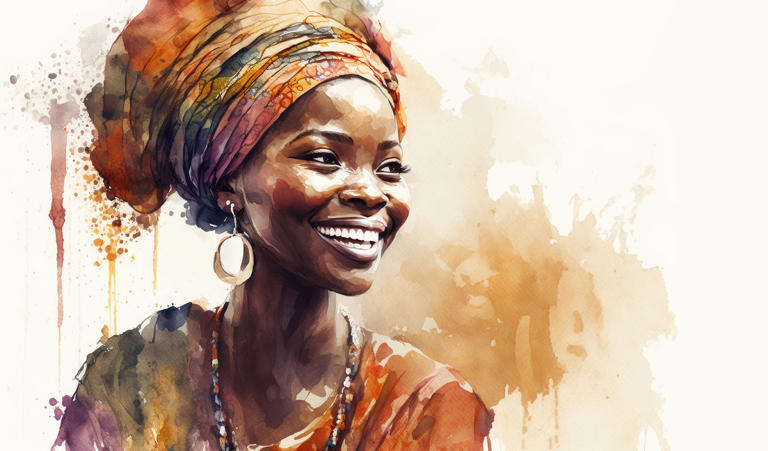
- Skip to main content
- Keyboard shortcuts for audio player
Author Interviews
What's the key to creating great art this author spoke to 40+ artists to find out.
Michael Levitt

Ari Shapiro
NPR's Ari Shapiro speaks with Adam Moss, author of The Work of Art: How Something Comes From Nothing.
ARI SHAPIRO, HOST:
I've got a 400-page book. I have a couple hours to spend with the author talking about it, and I have eight minutes of your time to tell you about this book. So where should I begin?
ADAM MOSS: Yeah, no, I'm feeling, very exposed and somewhat terrified.
SHAPIRO: Exposed? Terrified? That seems like a good start. We've got emotion, stakes and a character. The author? Adam Moss. His new book explores how creative people make things.
MOSS: The book is called "The Work Of Art," and that is kind of what it's about.
SHAPIRO: It's about the work. In more than 40 chapters, one per artist, the book tries to answer the question - how does a sketch become a painting, a scribbled lyric become a song? Or how does a sprawling interview become a radio story?
You know, on second thought, maybe I should start this piece with a scene instead - take two.
MOSS: So this building used to be pretty much all artist studios, and then, over the years...
SHAPIRO: Adam Moss and I walk into a square room with white walls, light streaming in from windows on two sides...
MOSS: Which is my sort of secret painting studio, and it's kind of my den of torture.
SHAPIRO: (Laughter).
MOSS: And this is where I come, you know, many days and wrestle with trying to make something (laughter).
SHAPIRO: And it's just art everywhere you look. The difference between this and other artist studios being that you've never allowed anyone in this space before now?
MOSS: That is true - just my husband and my teacher. That's it. Two people in my entire life, and I've had this thing for five years. So welcome.
SHAPIRO: Well, what a privilege. What a privilege.
See, when Adam Moss gave up his job as editor-in-chief of New York Magazine five years ago, he started painting. He loved it, and it was agonizing.
MOSS: I really wanted to be good, and it made the act of making art so frustrating for me. And what - you know, just to cut to the chase - you know, what I learned from this book is that the end product is not the point. Everyone I talked to was, in many ways, indifferent to the product of their labors - and, really, extreme labors. And what they were consumed by - why they did what they did - is because they were consumed by the work.
SHAPIRO: Ugh. Is this too forced - trying to emulate the form of the book in the form of this radio piece? Oh, wait - I know. The solution to my problem of how to start this story is in the book.
How do the artists you spoke with deal with the blank page?
MOSS: Well, it was a preoccupation of all of them. And they all approached it differently, but, basically, they tried to get through that as quickly as possible and with as little thought as possible. Many of them write in longhand, giving themselves...
SHAPIRO: Yeah.
MOSS: ...Explicit permission to fail.
SHAPIRO: Key, it sounds like, is it doesn't have to begin with something good. It just has to begin.
MOSS: It just has to begin.
SHAPIRO: Phew. OK, then - let's move on.
The artists in this book cover so many different genres. There are composers and crossword-puzzle-makers. There are poets and playwrights, painters. What interested me the most was the number of things they all have in common. Can you list off a few of those for us?
MOSS: Sure. Fundamentally, they all have drive. They all have a compulsion - an obsession to make something. It gets into their system, and they can't let go of it. They have faith. They have patience. They have perseverance. They have luck.
SHAPIRO: The book is a visual feast full of drafts and sketches. Every page offers images showing how an idea becomes a finished design. You know what? Maybe I should zoom in, give you a specific example. And since this is an audio story, it should probably be a musician. Adam Moss and I talked about composer Stephen Sondheim and singer-songwriter Rostam, who's less well known. Which one do I put in this story? Well, Sondheim already gets a lot of attention on NPR, and I like an underdog. So...
You spoke with the artist Rostam, formerly of the band Vampire Weekend, now a solo artist, and he described to you the process of writing the song "In A River."
SHAPIRO: What was that process for him?
MOSS: The process for him was he had purchased a mandolin. And he was just plucking it, sitting in his house, and a chord progression came to him.
(SOUNDBITE OF RASTAM BATMANGLIJ SONG, "IN A RIVER")
SHAPIRO: But it had to be a simple chord progression 'cause he wasn't good at playing the mandolin.
MOSS: Absolutely. He'd never played it before.
SHAPIRO: Which gets to the theme of limitations are so helpful to so many of these artists.
MOSS: Limitations are helpful. And also, he had played the guitar. So he had in him ingrained a certain facility, which - he was able to adapt to the mandolin. He played this little, simple chord progression. He would then revisit this sound now and then. At one point, he started to sing kind of gibberish, which was, by the way, what all the songwriters do at first.
SHAPIRO: All of them.
MOSS: All of them - every single one - they start by just singing the thing that comes to their mind. It's the blank page that you were talking about before. And in this case, the line - the key lyric of the song came to him in that very first instant, swimming in a river with no clothes on. And he liked that.
(SOUNDBITE OF SONG, "IN A RIVER")
ROSTAM BATMANGLIJ: (Singing) We are swimming with no clothes on in a river in the dark.
SHAPIRO: In the book, you print the draft lyrics that he was playing with and then the final lyrics, and so we can see how it evolves from, yeah, I'm holding on to you, yeah, I got you by the arm, to and I'm holding on to you, boy, in the faint light of the stars.
BATMANGLIJ: (Singing) And I am holding onto you, boy, in the faint light of the stars.
MOSS: And in fact, when he - you know, when he looked at his early lyrics in any number of places, he'd cringed.
SHAPIRO: Yeah, I mean...
MOSS: But he said, as he says - he says, but that's what - you've got to get through the bad in order to get to the good.
BATMANGLIJ: (Singing) In the faint light of the headlights of passing cars.
SHAPIRO: And so as we sit here in your painting studio, surrounded by studies half-finished, entirely finished paintings that you have felt like were torture as you were making them...
MOSS: (Laughter).
SHAPIRO: ...What has the experience of writing this book and speaking with all of these geniuses taught you?
MOSS: It's taught me to appreciate the making, not the made, which is enormously relieving for me and allows me to feel joy, even when I don't like what I make.
SHAPIRO: Every creation is, in some sense, defined by its limitations.
MOSS: Mmm hmm.
SHAPIRO: And one of the limitations on this interview we're conducting is that it is eight minutes on the radio - no more, no less.
SHAPIRO: So how do we end it? What did you learn from the artists you spoke to about how to end the thing?
MOSS: Well, people end for all sorts of reasons. They end because they're afraid they're going to screw it up. They end because they're bored. They end for completely arbitrary reasons. And let's end it there with - let's just end it.
SHAPIRO: Adam Moss - his new book is "The Work Of Art: How Something Comes From Nothing." Thank you so much.
MOSS: Thank you.
SHAPIRO: Sorry, there was one thing about endings that I really loved, which was Twyla Tharp basically saying, like, an ending is just another thing.
MOSS: Yeah, we can actually end there if you want.
MOSS: That's good.
SHAPIRO: How do people end the thing?
MOSS: They end it all sorts of ways. The choreographer, Twyla Tharp, when she says, well, you just end it, the ending is another part, just like the middle, she says - love that.
SHAPIRO: Adam Moss is the author of the new book, "The Work Of Art: How Something Comes From Nothing." And you didn't hear this from me, but he's also a very talented painter.
Copyright © 2024 NPR. All rights reserved. Visit our website terms of use and permissions pages at www.npr.org for further information.
NPR transcripts are created on a rush deadline by an NPR contractor. This text may not be in its final form and may be updated or revised in the future. Accuracy and availability may vary. The authoritative record of NPR’s programming is the audio record.
Election Updates: Watchdog group accuses the Trump campaign of violating finance law.
- Share full article

Neil Vigdor
Steve Garvey, the former L.A. Dodgers star and Republican U.S. Senate candidate in California, accused University of Southern California of enabling pro-Palestinian protests and equated the encampments to terrorism for obstructing "the pathway to classes." The school's provost noted yesterday that it asked protesters to remove the tents and closed campus gates to keep the demonstration from growing.

Zolan Kanno-Youngs
During a speech about federal investments in semiconductor manufacturing, Mr. Biden again trolled Republicans who voted against or criticized his CHIPS act. “My predecessor and his MAGA Republican friends have a very different view,” Mr. Biden said, as he celebrated $6.1 billion grant for Micron. Referring to Representatives Brandon Williams and Elise Stefanik, Biden said, “I guess they’re not going to be here today to celebrate.”
President Biden is preparing to deliver a speech celebrating $6.1 billion in grants to Micron Technology, the latest federal award to bolster semiconductors. “It’s going to have a gigantic impact,” Biden said. As he entered the science and technology museum where he will speak here in Syracuse, a group of about 100 pro-Palestinian protesters across the street chanted “ceasefire now!”
Five Republicans and three Democrats submitted signatures to the state of Michigan to try to qualify for their party primaries on Aug, 6 for the state's open U.S. Senate seat. G.O.P. petition filers included a trio of former House members: Mike Rogers, Peter Meijer and Justin Amash. The Democrats included Representative Elissa Slotkin and the actor Hill Harper.
Federal filings show that Christina Bobb was paid $5,288.82 on March 29 by the R.N.C., which provided a statement from Steven Cheung, a Trump campaign spokesman, in response to questions about her status. Mr. Cheung said Ms. Bobb’s indictment in Arizona was another example of Democrats’ weaponization of the justice system. “The Democrat platform for 2024: if you can’t beat them, try to throw them in jail.”
One name to watch in the Arizona election indictment is Christina Bobb, a right-wing former lawyer for Donald Trump whom the R.N.C. hired as a senior election counsel. “This tells you all you need to know about today’s Republican National Committee,” Liz Cheney wrote on X , “The person in charge of election integrity for the @GOP was just indicted in Arizona for a lack of election integrity.”
North Carolina’s elections board said Thursday that felons who have not completed their sentences remain ineligible to vote, including parolees and those on probation and supervised release. It attempted to clarify their status after a federal judge on Monday blocked the state from enforcing an 1877 law, one criticized as discriminatory, that made it a crime for offenders who voted without knowing about the ban.

Michael Gold
Donald Trump made a campaign stop this morning at a construction site in Manhattan, where he shook hands with union members. The brief visit, meant to highlight Trump’s criticism of Biden’s economic policies, exemplifies how his campaign intends to balance his court schedule with stops in media-heavy New York City that help him broadcast his national message.

Maggie Astor
Several lawyers and advisers to former President Donald J. Trump, including Rudolph W. Giuliani and Mark Meadows, were indicted in Arizona on Wednesday in connection with efforts to overturn the 2020 election. Trump was named as an unindicted co-conspirator in the case, as well as in a similar case in Michigan .
Donald Trump’s legal team will argue to the Supreme Court this morning that he can’t be prosecuted because former presidents have “absolute immunity” from criminal charges for acts they took in office. Trump’s campaign, meanwhile, sent out a fund-raising email last night titled “Put Biden on Trial,” saying, “CROOKED JOE DESERVES LIFE IN PRISON!”

Chris Cameron
Watchdog group accuses the Trump campaign of violating finance law.
A campaign watchdog group filed a formal complaint to the Federal Election Commission on Wednesday accusing Donald J. Trump’s presidential campaign and related political committees of concealing payments of $7.2 million in legal fees by paying them through an unrelated shell company in violation of campaign finance law.
At the center of the complaint , from the Campaign Legal Center, is the company that received the payments, Red Curve. The company is run by Bradley Crate, who is also the treasurer for the Trump campaign and four related political committees listed in the complaint, as well as for 200 other candidates and committees.
In its complaint, the Campaign Legal Center said that the Trump political committees had used Red Curve, which did not appear to offer legal services, “as a conduit to conceal payments for legal services.” The group filed its complaint hours after The Daily Beast published an article about the payments to Red Curve.
Neither Red Curve nor representatives of the Trump campaign responded to a request for comment.
“This apparent payment scheme, however, violates the reporting requirements of the Federal Election Campaign Act,” the complaint said, “which requires that committees provide detailed information about who they are paying for services, and how much they are paying for those services.”
The complaint also said that Red Curve advanced payments for the legal costs to the Trump committees as part of the payment scheme, potentially violating a campaign finance law that prevents corporations from giving money to candidates.
“What Red Curve was doing was basically making a contribution," said Saurav Ghosh, the director of federal campaign finance reform at the Campaign Legal Center. “If it’s treated as a corporation under federal campaign finance law, then that’s illegal on its face.”
He added: “If, alternatively, it’s an unincorporated entity for campaign finance purposes, then the contributions would be in excess” of the amount permitted by federal law.
Mr. Trump has spent more than $100 million on lawyers and other legal costs since he left office in 2021, relying almost entirely on political donations to cover those expenses. Red Curve was the largest single recipient of those payments, receiving $7.2 million, according to records filed to the F.E.C.
The F.E.C. also on Wednesday fined a pro-Trump super PAC $6,075 in a negotiated settlement for failing to disclose $150,600 in in-kind contributions in an April 2022 quarterly report. The super PAC — Make America Great Again, Again — was once a leading fund-raising group for Mr. Trump. It fell under scrutiny last year for an unusual payment of $155,000 to Melania Trump , Mr. Trump’s wife, for a speaking engagement.
The Trump campaign did not respond to questions about the fine.
In its complaint concerning Red Curve, the Campaign Legal Center cited what it said were similar violations of campaign finance law. The watchdog group noted the use of a law firm by Hillary Clinton’s presidential campaign and the Democratic National Committee in 2016 that made payments to the firm Fusion GPS to conduct research against Mr. Trump — research that was used in what became known as the Steele dossier . The Clinton campaign and the D.N.C. agreed to pay $113,000 in fines to settle an F.E.C. investigation into campaign spending disclosures.
“It’s similar to this situation,” Mr. Ghosh said of the Fusion GPS case. “In that there was, you know, a lack of transparency about who’s getting paid. What is the payment for?”
Trump again compares campus protests to the violent white supremacist rally in Charlottesville.
Former President Donald J. Trump emerged from his felony criminal trial in New York on Thursday and again minimized the violence at a white supremacist rally in Charlottesville, Va., in 2017 while portraying a recent wave of predominantly peaceful pro-Palestinian protests on college campuses as characterized by “tremendous hate.”
One woman was killed and nearly 40 people were injured when an avowed neo-Nazi plowed his car through a crowd of counterprotesters during violent clashes in Charlottesville. Earlier, hundreds of white supremacists had marched through the city, carrying torches and chanting, “Jews will not replace us.”
The current campus protests, while resulting in hundreds of arrests , have had no reports of significant violence.
But standing outside a Manhattan courthouse on Thursday, Mr. Trump said, “Charlottesville was a little peanut and was nothing compared — and the hate wasn’t the kind of hate that you have here. This is tremendous hate.” Of President Biden, he added, “We have a man that can’t talk about it because he doesn’t understand it.”
Andrew Bates, a spokesman for the White House, said in a statement that “minimizing the antisemitic and white supremacist poison displayed in Charlottesville is repugnant and divisive.” He added: “That moment compelled President Biden to run in 2020, because he has fought antisemitism and hate his entire life.”
Mr. Trump had used that same characterization about Charlottesville only a day earlier in a post on his social media site. The former president diminished the violence at the far-right rally, calling it “like a ‘peanut’” compared with the campus protests against the war in Gaza, which he distorted as “riots and anti-Israel protests.”
Mr. Trump also in that post repeated an attack on President Biden, saying that he “HATES Israel and Hates the Jewish people,” while adding “the problem is that he HATES the Palestinians even more, and he just doesn’t know what to do!?!?” Mr. Trump has repeatedly insulted Jews who vote for Democrats and for Mr. Biden, saying that they hate their religion and Israel .
Representatives for the Trump campaign did not respond to a request for comment.
Mr. Trump — who also presided over civil unrest set off by the murder of George Floyd by a police officer in May 2020 — sought to downplay a chapter of his presidency that garnered widespread outrage and criticism.
In Charlottesville’s aftermath, Mr. Trump repeatedly drew a moral equivalency between the white supremacists — who brandished swastikas, Confederate flags and “Trump/Pence” signs — and peaceful counterprotesters, asserting that there were “very fine people on both sides.”
Underpinning the Charlottesville gathering of neo-Nazis, antisemites and white supremacists was a racist conspiracy theory, called the great replacement theory, which says that elites, sometimes manipulated by Jews, seek to “replace” and disempower white Americans. The growing prominence of the theory in far-right circles has incited racist terror attacks across the world, including several mass shootings in the United States.
Mr. Biden has in recent months faced protests and opposition to his presidential campaign from Americans who are sympathetic to the plight of the Palestinians and angry at the United States for arming Israel in the fighting in Gaza. Mr. Trump’s social media post on Wednesday sought to portray many of these protesters as a riotous mob, while also seeking to stoke protesters’ anger by claiming that Mr. Biden hates the Palestinians.
Some of the campus demonstrations have included hate speech and expressions of support for Hamas, the militant group in Gaza that carried out attacks on Israel on Oct. 7, killing about 1,200 people. In response to those attacks, Israel has waged a war on Hamas in Gaza, killing more than 34,000 people, mostly women and children , according to the Gaza Health Ministry. This week Mr. Biden condemned demonstrations that he said veered into antisemitism, but he also expressed sympathy for the Palestinians.
“I condemn the antisemitic protests,” Mr. Biden told reporters on Monday. “I also condemn those who don’t understand what’s going on with the Palestinians.”
Biden was in Syracuse as Trump’s trial continued in Manhattan.
President Biden was in Syracuse, N.Y., today to promote investments from the CHIPS and Science Act and other economic policies enacted during his administration.
The reliably blue state is again the center of political attention during the 2024 presidential campaign, after Mr. Biden and former President Donald J. Trump crossed paths last month . But it is the first time that Mr. Biden has traveled to the state during the felony criminal trial of Mr. Trump, his Republican rival.
Mr. Trump’s trial in a Manhattan courthouse was in recess on Wednesday, and will pick back up today — most likely unfolding as Mr. Biden gives his speech in upstate New York, 250 miles away. Mr. Trump made a brief campaign stop early in the morning at a construction site in Manhattan.
It is a dynamic that will continue for at least several more weeks: While Mr. Biden campaigns across the country, Mr. Trump has often been in the Manhattan courtroom.
Mr. Trump has tried to make campaign stops outside of the courtroom, as he did Thursday morning, and on the weekends. But a rally that he had scheduled in North Carolina last weekend was called off because of weather.
And Mr. Trump’s legal troubles have only grown in recent days. On Wednesday, Rudolph W. Giuliani, Mark Meadows and a number of other Trump allies were indicted in Arizona for their role in a fake elector scheme in 2020 that sought to overturn the results of the election in that state. The indictment includes conspiracy, fraud and forgery charges, related to efforts by the defendants to change the 2020 election results.
Mr. Trump was also named an unindicted co-conspirator in the case.
On Wednesday evening, Mr. Trump weighed in on the growing pro-Palestinian protests on college campuses, distorting the mostly peaceful demonstrations as “riots” while downplaying the violence at a 2017 white supremacist rally in Charlottesville, Va., saying that “Charlottesville is like a ‘peanut’” in comparison to the current student protests.
Mr. Trump, in the same social media post, accused Mr. Biden of hating Israel and Jewish people, even as Mr. Biden reaffirmed his commitment to Israel as “ironclad.” Mr. Trump has made similar accusations against Jews who vote for Democrats, saying that they hate Israel and their religion.
Trump makes a campaign stop in Manhattan before his trial resumes.
Hours before he was set to return to the courthouse for his criminal trial in Manhattan, former President Donald J. Trump started Thursday morning by visiting a construction site in a campaign stop that exemplified the balancing act required for a candidate who is also a criminal defendant.
In the shadow of what will eventually be the 70-story headquarters of one of the nation’s biggest banks, Mr. Trump shook hands with union workers in a visit meant to highlight his support from working-class voters and draw attention to his criticism of President Biden’s economic policies.
His warm reception — a cheering crowd of roughly 100 people gathered behind him, chanting “we want Trump” — marked a stark contrast from the sober environment of the courthouse where Mr. Trump has spent most weekdays since his trial began last week, and where his comments have largely been limited to addressing reporters in the hallway during breaks.
Mr. Trump has not held a rally since just before the trial began, in part because a planned event in North Carolina last weekend was canceled because of weather. But his visit to the construction site typifies how his campaign is using retail stops in New York, a left-leaning state not expected to be in play in November, to help broadcast his national message.
“I have a lot of support here,” Mr. Trump said, as roughly two dozen workers clambered up scaffolding and equipment to catch a glimpse of him. Among those in the crowd were members of the Teamsters union, whose endorsement Mr. Trump has been courting.
The trip to the construction site kicks off what will be a significant day in Mr. Trump’s legal battles. In Manhattan, where Mr. Trump is accused of falsifying business records, David Pecker, the former publisher of The National Enquirer, is expected to return to the stand and detail the hush-money payment at the center of his case. Asked by reporters, Mr. Trump said that Mr. Pecker had been “very nice” and called him a “nice guy.”
In Washington, the Supreme Court will consider Mr. Trump’s argument that he is immune from prosecution on federal charges that he plotted to subvert the 2020 election. Mr. Trump, who will likely be in the Manhattan courtroom during the oral arguments before the Supreme Court, repeated an argument he has been making for months that “a president has to have immunity, otherwise you just have a ceremonial president.”
Mr. Trump’s appeal to working-class voters was key to his victory in 2016, and as he tries to return to the White House, he has been eager to win the support of rank-and-file union members and to drive a wedge between them and labor leaders who have long favored Democrats.
In January, Mr. Trump met with the Teamsters union’s executive board and said he believed he had a “good shot” at securing the influential union’s endorsement. The union endorsed Mr. Biden in 2020, and its leaders met with the president last month.
Mr. Biden has for years touted his allegiance to unions. On Wednesday he received the endorsement of the North America’s Building Trades Unions, an umbrella group whose leaders pointed to Mr. Biden’s bipartisan infrastructure package.
Jason Miller, a senior Trump campaign adviser, said that Thursday’s visit had been “on the books for some time” and was part of the campaign’s larger strategy to contend with the scheduling challenges posed by the Manhattan trial.
“Since the Biden Trials are an attempt to keep us off the campaign trail, we’ll bring the campaign trail to us,” he said. Mr. Trump has said without citing evidence that the charges are part of an “election interference” scheme orchestrated by Mr. Biden.
Advertisement

IMAGES
COMMENTS
To reach our tour operator directly, please contact a Met Travel consultant at Arrangements Abroad by phone 844-TRVLMET (844-878-5638); outside New York: 800-221-1944), email, or write to: Venture abroad with the Metropolitan Museum's own lecturers and other art lovers to gain new insights and fresh perspectives on art and culture.
Photo by Brendon Campos. New York, London, Paris, Berlin, Los Angeles, Florence, Miami Beach, Hong Kong, São Paulo—these cities are all home to blockbuster art markets, creative superstars, and museums as famous as the works they house. We love these places, but we also love art destinations outside of the art-world orbit: places with an air ...
Types of Travelers and Journeys. Motivations for travel throughout history have been almost as varied as the means of travel. Whether people traveled alone or in groups, on foot, on animals, in caravans, on ships, or using modern modes of transportation like planes, trains, and automobiles, art can capture how and why we move through the world.
Luxury art travel experiences. Travel the world on intimate journeys curated through the lens of art. Experience an insider's view through artists' studios, museums, galleries, and collectors' homes. Build your art collection with the help of a skilled team. Make a difference by supporting art's impact on the world.
MetTours. Explore the vast world of art and culture through the lens of various viewpoints in programs ranging from gallery tours to storytelling sessions and interactive experiences with works of art. MetTours connects you with works of art, with curators, conservators, educators, and artists alike guiding you through the collection and ...
Journeys International. For the art traveler who looks beyond the canvas, Journeys International offers a unique opportunity. Here, art merges with the heart of travel experiences, guiding you to find your creative inspiration. It's about creating art through the very act of traveling—every step is a stroke of the brush on your life's canvas.
Travel in Art in the 17th Century. Back in the 17th century, European landscape art was on the rise. It was a dominant genre during this time thanks to the unprecedented growth of global travel and tourism. But there's a conundrum here: it's the chicken vs the egg debate when it comes to travel and art.
Travel and Art; Travel and Art. Explore transport and travel through the eyes of artists. Highlights; Planes, trains and automobiles; Expeditions and Maps; On your bike; Take a walk; Artists on holiday; Dig Deeper; Explore more Themes; Highlights. Fahrelnissa Zeid: city by city.
Regardless, travelers often over-look the nation for the more well-known artists travel destinations such as Egypt and Morocco. The capital, Tunis, offers a little something for everyone, for instance, ruins, beaches, and beautiful architecture. Klee's painting, however, is of the city of Kairouan, which is now a UNESCO World Heritage Site.
Miami, Florida is a great travel destination for art lovers because it is home to many world-renowned art museums, galleries, and cultural centers. It is also home to a vibrant street art scene and a variety of public art installations. From the Perez Art Museum Miami and the Bass Museum of Art to the Little Haiti Cultural Center and Wynwood ...
The National Art Museum of Ukraine illuminated at night. One of the most visited museums in Ukraine is the National Art Museum. It was established in 1897 by a successful patron of the arts, Bohdan Khanenko, who was determined to build the first museum in the country. Succeed he did—the historically important building contains a collection of ...
The Art of the Literary Poster: Works from the Leonard A. Lauder Collection. Through June 11. The Met Fifth Avenue. Vision and Verse: The Poetry of Chinese Painting. ... Travel. Bring some culture to your inbox. The Met Fifth Avenue. 1000 Fifth Avenue. New York, NY 10028. Phone: 212-535-7710. The Met Cloisters. 99 Margaret Corbin Drive.
2. Le Bonheur de vivre, also called The Joy of Life. The Barnes Museum, Philadelphia. Home to the iconic Philadelphia Museum of Art, the Rodin Museum, and now the Barnes Foundation, Philadelphia's Museum district deserves months to explore. But The Barnes is an incredible place to start.
The Art of Travel and Aesthetic Story Telling.
View of Delft (1660-1661), Johannes Vermeer. Johannes Vermeer's 17th-century oil painting, View of Delft, is one of three depictions the Dutch artist created of his hometown. View of Delft, as was The Little Street and House Standing in Delft, was notably uncommon for the time period, as portrayals of cityscapes were rare.
Katsushika Hokusai was a Japanese artist, printmaker, and painter who lived from 1760 to 1849. He is most recognized for his woodblock print series Thirty-Six Views of Mount Fuji, made in response to a domestic travel boom in Japan. From this collection, one piece in particular stood out among the rest. The Great Wave Off Kanagawa is arguably ...
ART & HISTORY TOURS. Discover some of Europe's most remarkable historic and artistic marvels in VIP style on our Special Interest Art & History Tours. From Rome to Amsterdam, you'll meet local art and history experts who will share insider knowledge on local galleries, sites and museums. In Italy, admire the papal art collection and Sistine ...
Traveling by Boat: Breezing Up. Best Traveling Paintings: Winslow Homer, Breezing Up, 1873-1876, National Gallery Of Art, Washington, DC, USA. Traveling for business does not have to be boring. On a cloudy afternoon, a fisherman and three boys return from a day at sea. The boat moves quickly on the waves. The man and the boys are perched on the ...
The Art of Travel. Paperback - Illustrated, May 11, 2004. A wise and utterly original book of travel essays from an international bestselling author that will "give one an expansive sense of wonder" (The Baltimore Sun). Any Baedeker will tell us where we ought to travel, but only Alain de Botton will tell us how and why.
Amy Blyth 30 January 2023. Kyiv is a treasure trove of ancient Ukrainian culture, complete with 950 churches, cathedrals and monuments dotting the city. Come to the capital of Ukraine to explore top attractions such as St Andrew's Church, the MM Hryshko National Botanical Garden, the Mariyinsky Palace and the Kyiv-Pechersk Lavra, with its ...
5. Unveil the St. Michael's Golden-Domed Monastery. Cathedral, Church, Monastery, School, Shrine. Share. Add to Plan. ©rmac8oppo/Pixabay. An ancient monastery is one of the main attractions in Kiev. There is a spiritual school, a church choir and also a special hotel, where pilgrims can stay for a while in the shrine.
Other art museums in Kyiv include the Pinchuk Art Centre, a museum dedicated to Eastern European art and culture, which is privately owned by Viktor Pinchuk. It is an international centre for the display of contemporary art. ... Bradt Travel Guides.
The breakout series Shōgun has renewed interest in the clashing swords and political maneuvering of Japan's feudal era - and the city of Kanazawa is an excellent place to learn more.
Personalized travel art serves as a beautiful and creative reminder of all the places you've been and experiences you've had. In this article, we'll dive deep into personalized travel art ...
Opinions expressed by Forbes Contributors are their own. I write about conscious luxury, focusing on travel, well-being & art. On the opening day of the Venice Art Biennale, dark storm clouds hang ...
MOSS: The book is called "The Work Of Art," and that is kind of what it's about. SHAPIRO: It's about the work. In more than 40 chapters, one per artist, the book tries to answer the question - how ...
Wandering through Sfer Ik is an experience that is part museum, part art gallery and definitely a topsy turvy encounter.
Federal filings show that Christina Bobb was paid $5,288.82 on March 29 by the R.N.C., which provided a statement from Steven Cheung, a Trump campaign spokesman, in response to questions about her ...